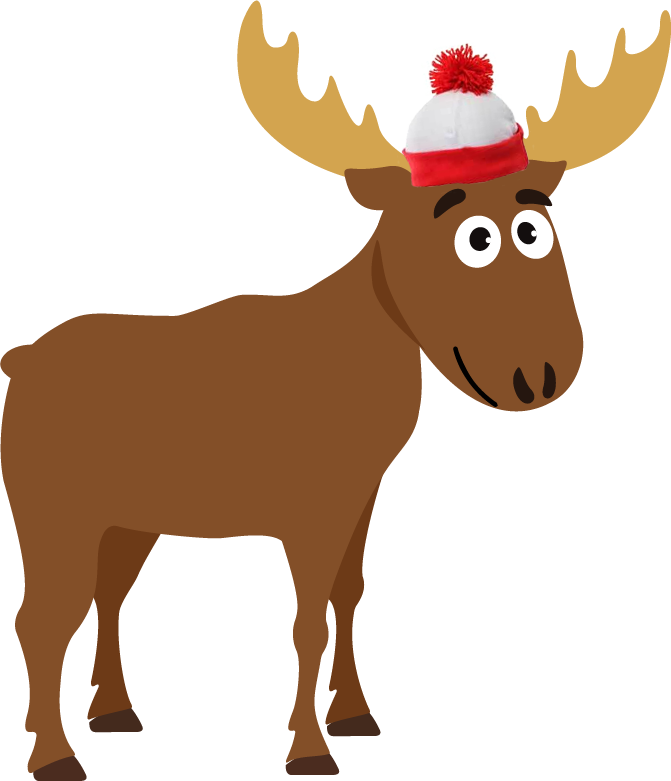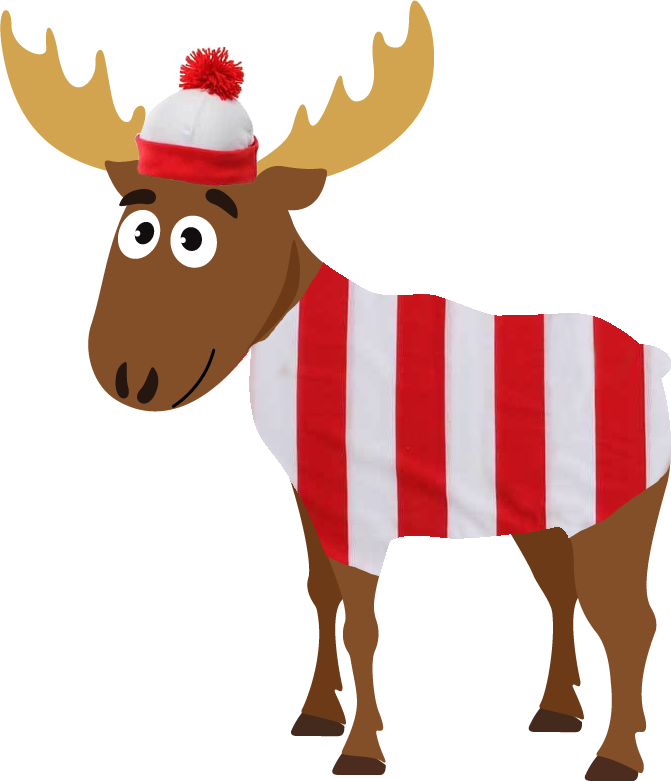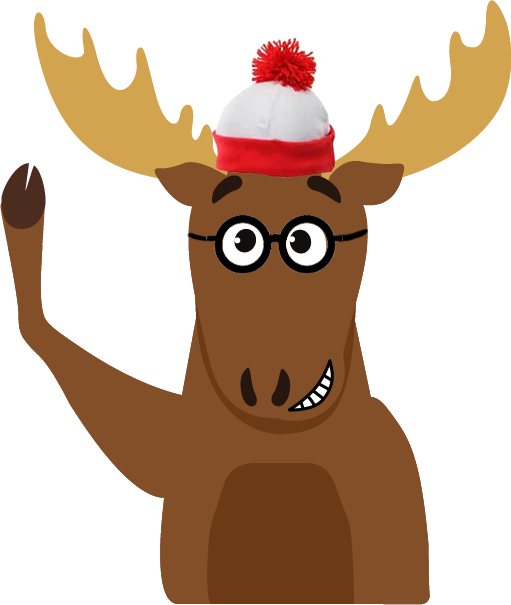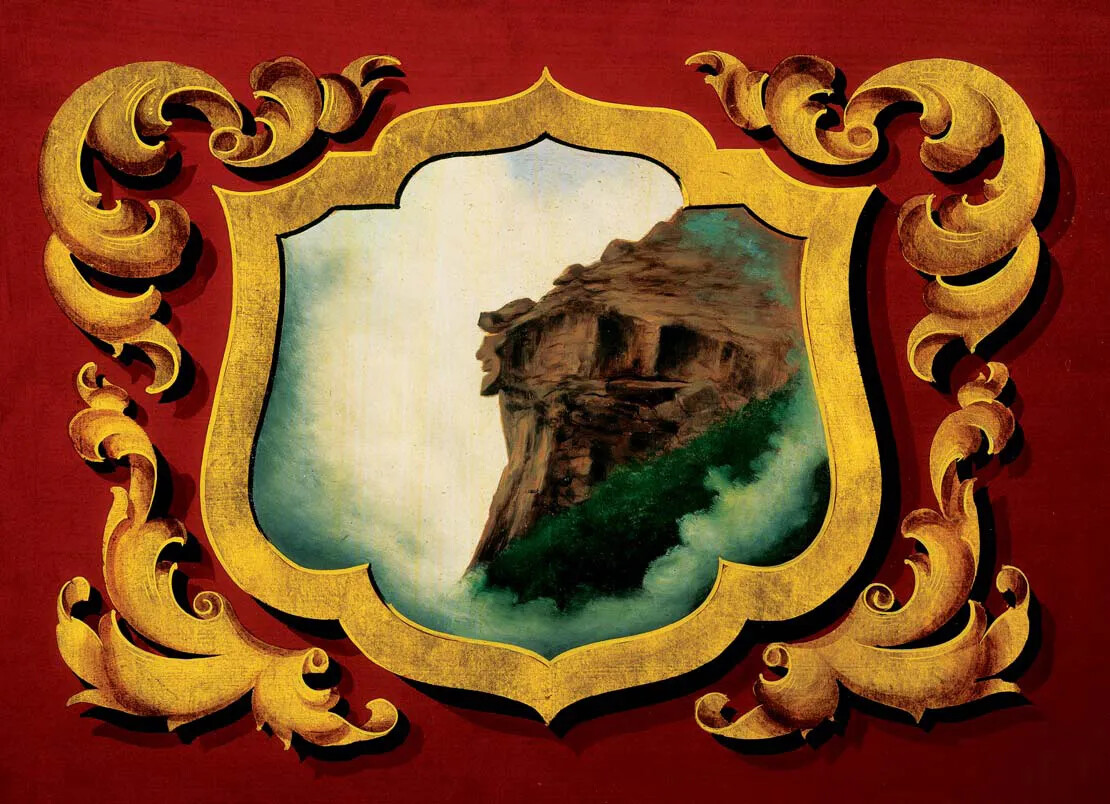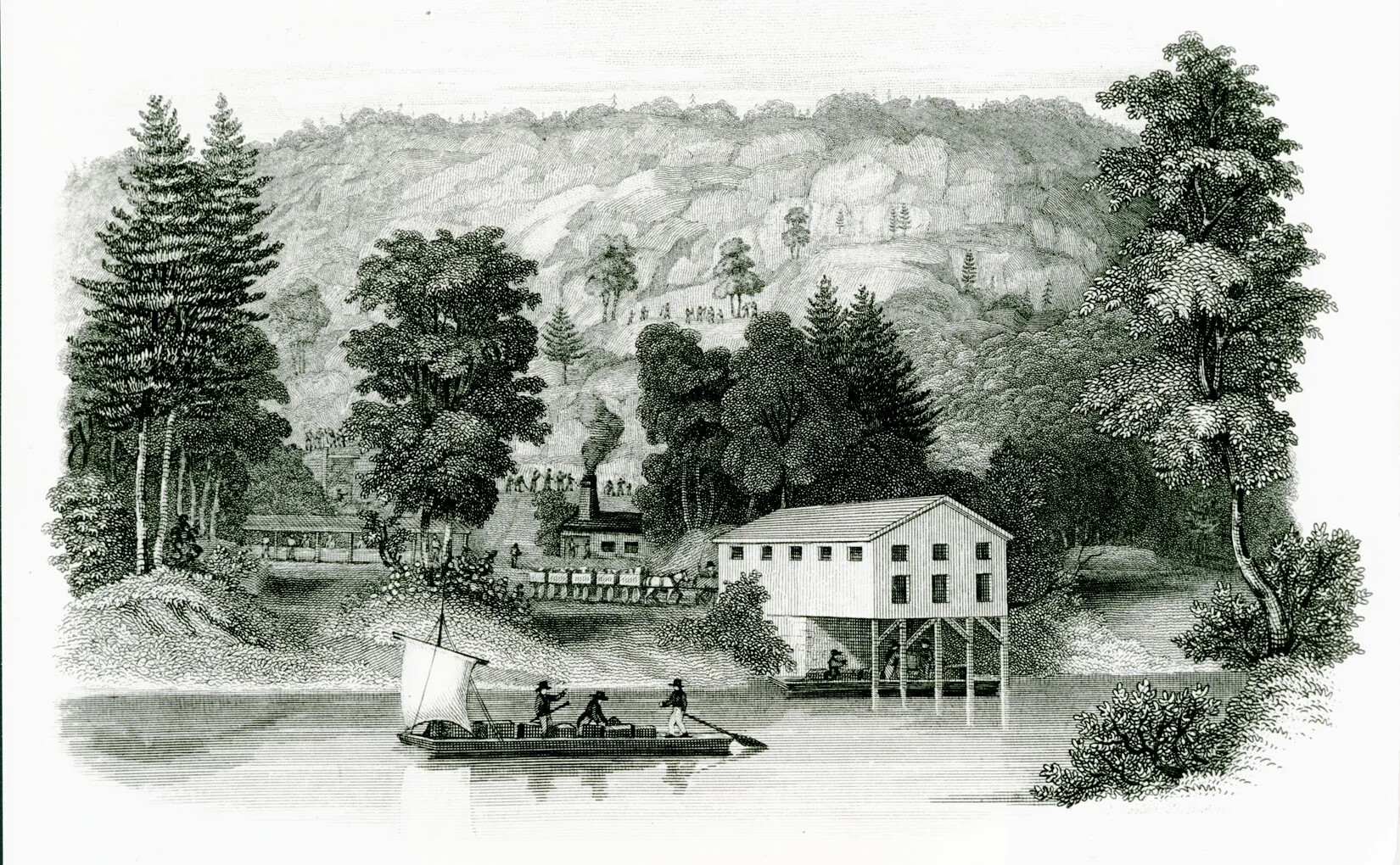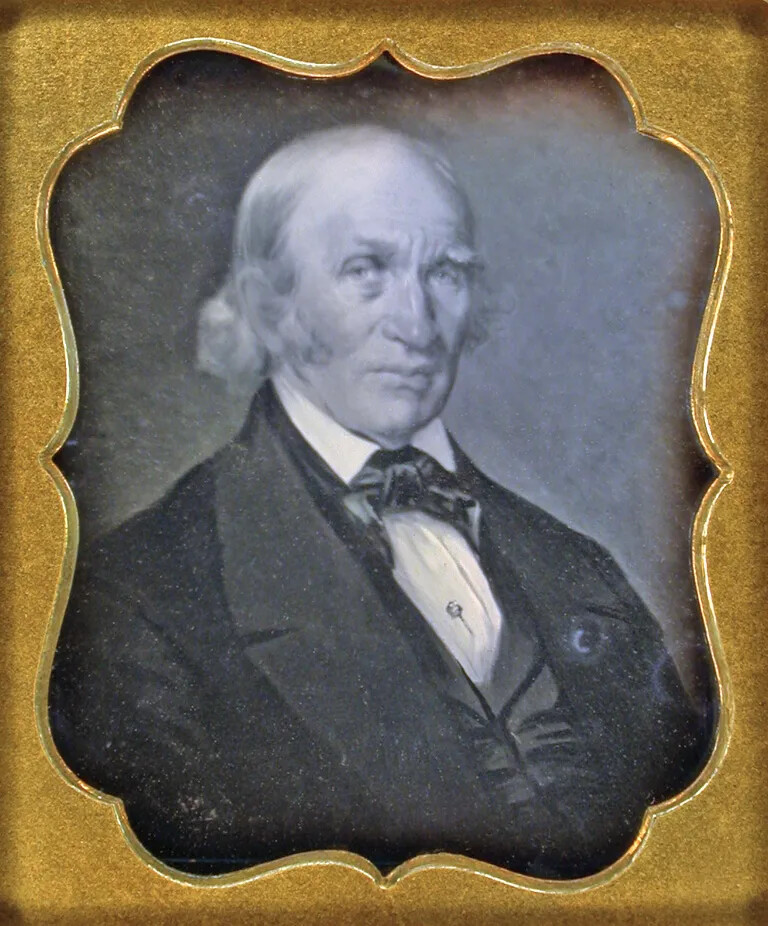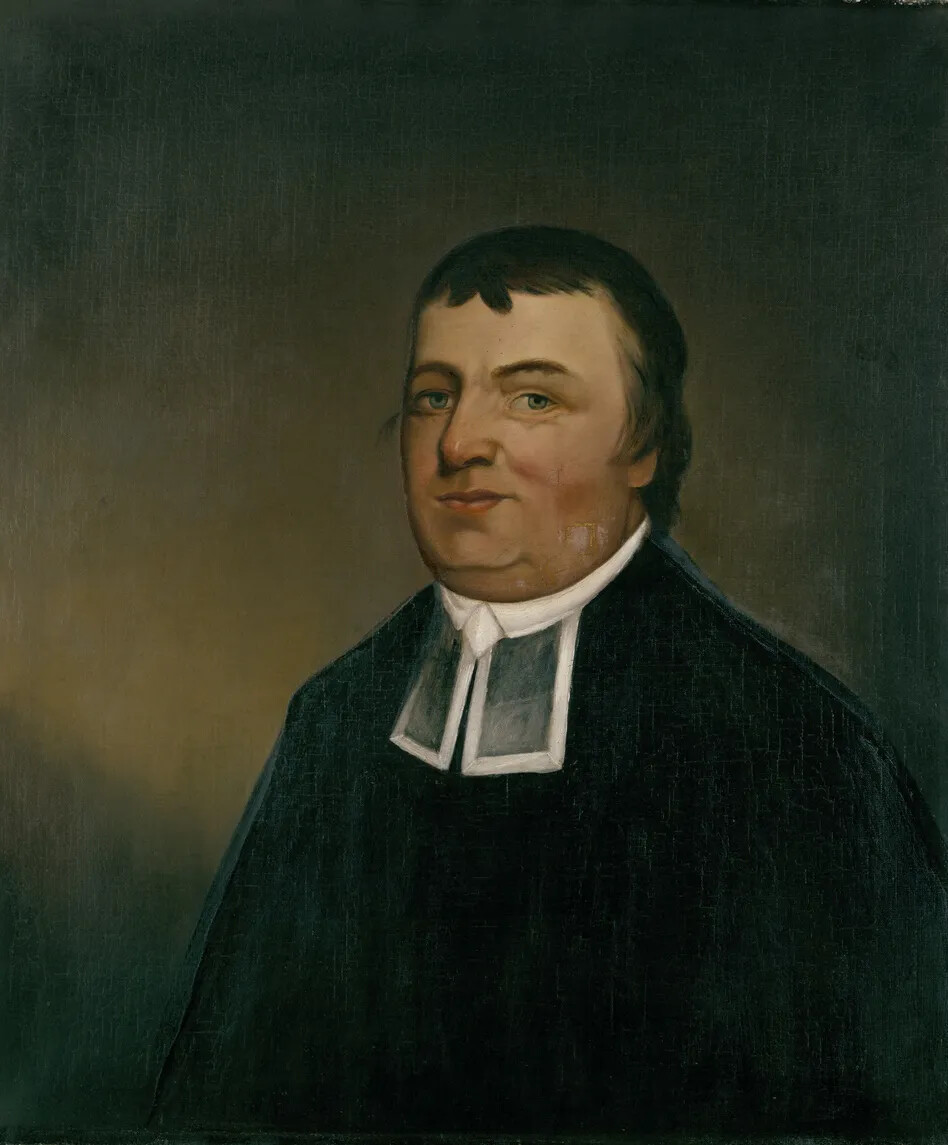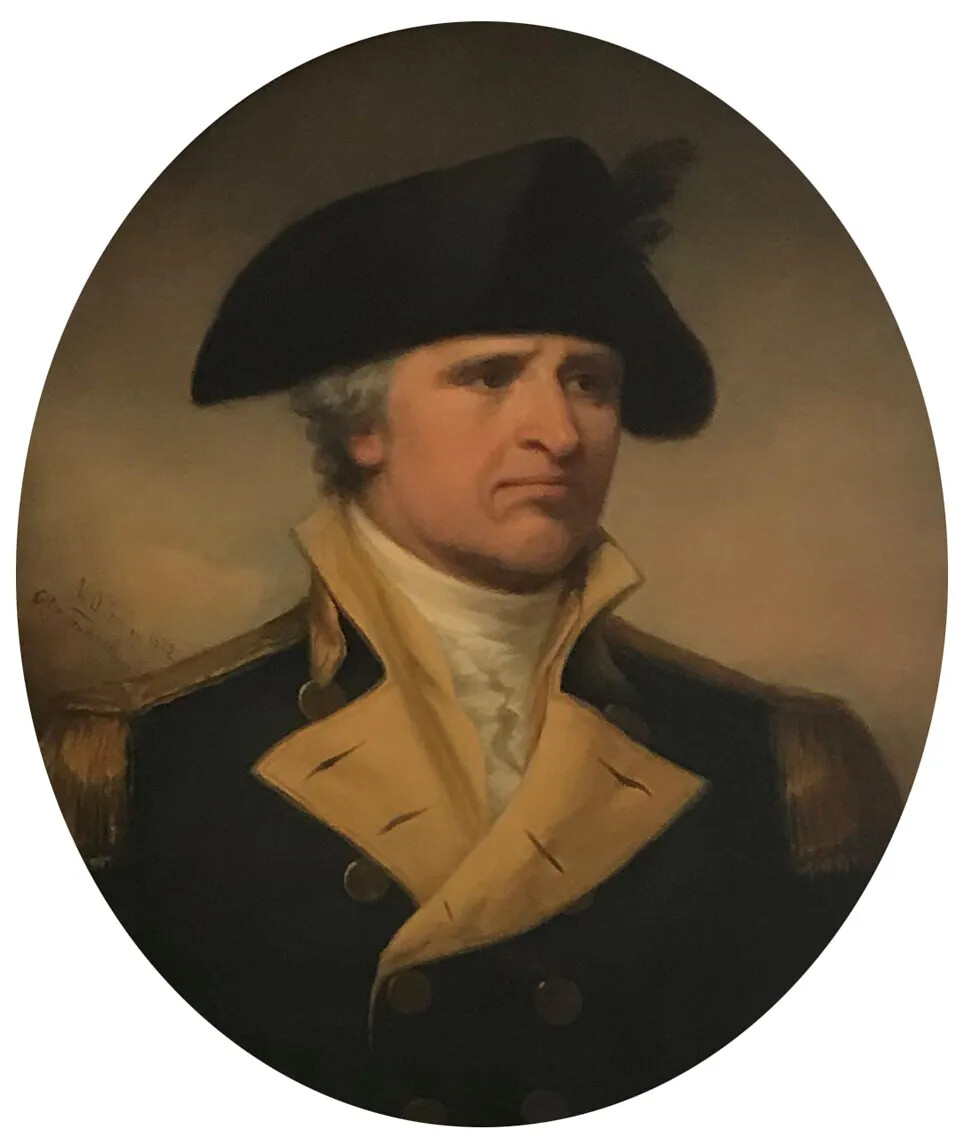In the late 18th century and early 19th century, many changes occurred in New Hampshire that affected the way people lived in the Granite State and how they interacted with people in other communities. New Hampshire developed a transportation network, began industrializing its economy, and started to establish a state culture. As you learn about New Hampshire in this period, think about the following questions:
- How did the movement of goods and people change during this time?
- How did New Hampshire develop a state identity or culture in the years after the American Revolution?
transportation network
noun
A system where goods or people pass from one place to another; transportation can be provided by animals (like horses) or machines (like railroads or cars). Transportation networks usually include roads, bridges, rail lines, canals, and other manmade improvements to the land.
- A TRANSPORTATION NETWORK
- EARLY NH INDUSTRY
- THE MARKET REVOLUTION
- NEW SETTLEMENTS AND BOUNDARIES
- DEVELOPING A STATE CULTURE
A Transportation Network
How did people get around the state during this period?
Most towns in southern New Hampshire were settled by 1783, when the American Revolution ended. Each town had a town center, which included a meeting house, a town common, and a cemetery. Towns people used the meeting house for town meetings, for church services, and for the town school.
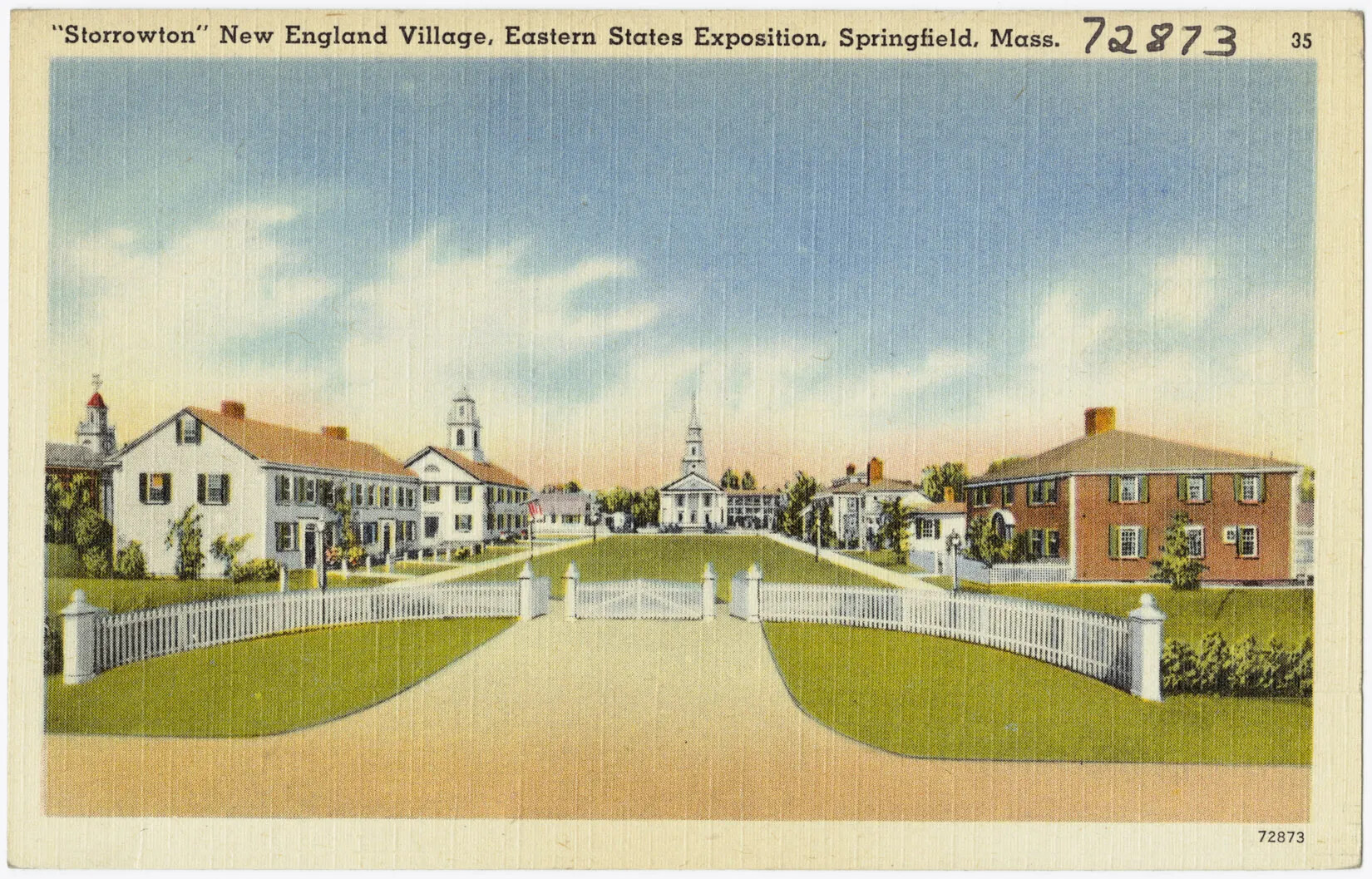
Caption:
This postcard shows a typical colonial New England village. Notice that the main public buildings, like the meeting house or church, were centered around the town commons. A commons is a public area, usually flat and grassy, that is used by all members of a community. Storrowton Village Museum is a recreated village of 18th and 19th century buildings from Massachusetts and New Hampshire. All of the buildings were originally located in different places, but they were moved to Springfield, Massachusetts, and set up like a colonial village. That way modern visitors can see what it would have looked like in the 1700s and 1800s.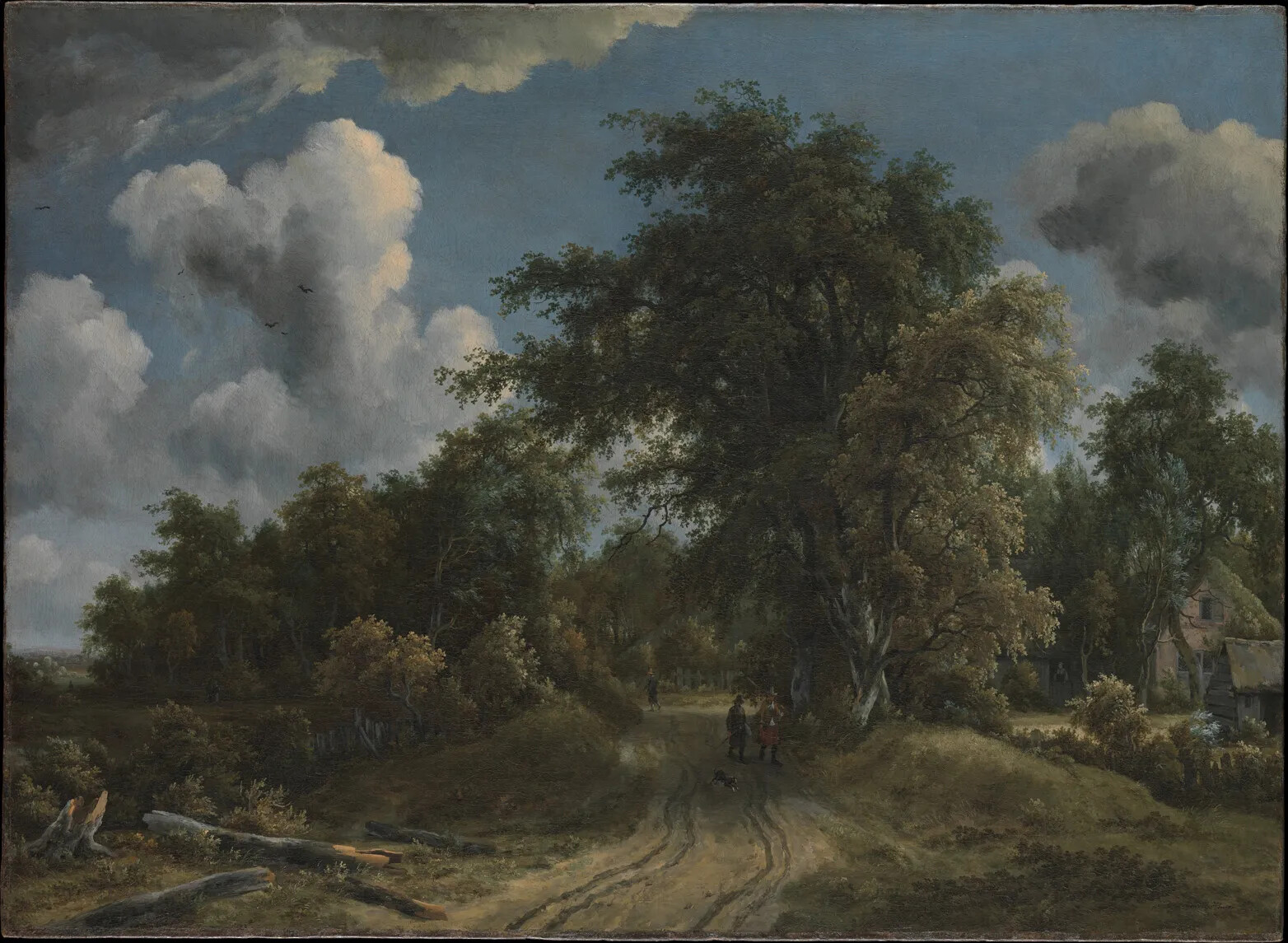
Caption:
This painting shows what a typical road looked like during the 1600s, 1700s, and early 1800s. Roads had to be cut through the forest, field, or marshland by hand. They were rough and not always straight. But they were very important! Roads were used to transport people, animals, and products from place to place.Roads. Each town also had its own roads to help people get around the town. Most of us don’t think about roads very often, but roads are important to our everyday lives. They help us get from one place to another so we can go to school or to see friends or visit a store. All the things that are in the store were brought there on roads. And everything we make or sell has to travel on roads to get to other people.
In the 18th century, roads were very rough. They were made of dirt and full of rocks, and some of them were so narrow they looked more like paths than roads. It took a long time to get from one place to another. But roads were important for people to move around their town and get to the town center where they could meet with other people.
The people in each town were in charge of taking care of their roads. They decided where roads would go. They built bridges over rivers and cut roads over mountains and around lakes. They also were responsible for clearing the roads of rocks and tree branches. It was a lot of work to maintain the town’s roads.
People also used roads to travel from one town to another. In southern New Hampshire, most town centers were about 8 miles apart, so it would take people about 3 or 4 hours to travel on foot or horseback from one town center to another on the rough, rocky roads.
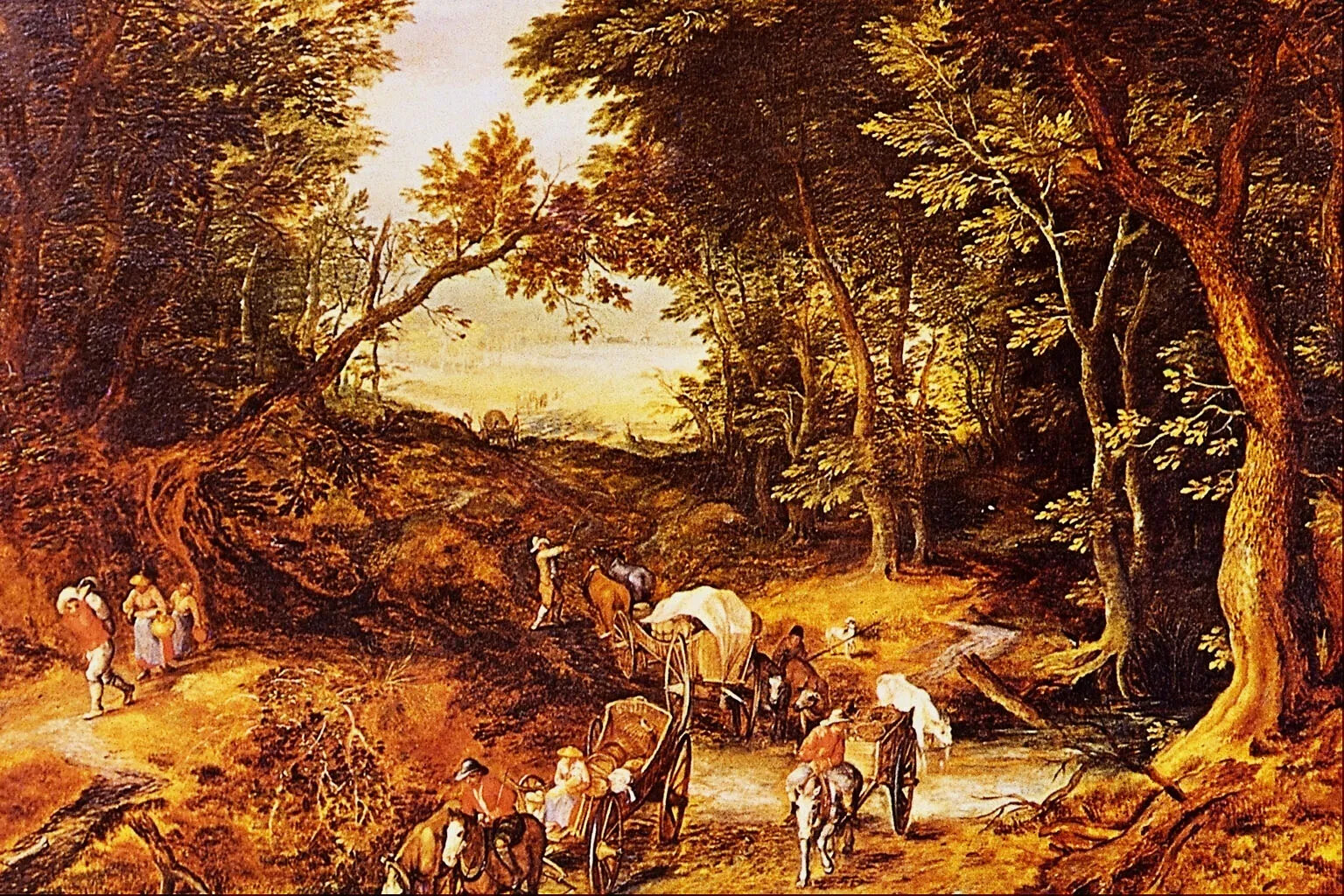
Caption:
Roads in the 17th and 18th centuries were very rough, but important. People, animals, and products traveled from place to place on roads. The people in each town were responsible for taking care of their roads. They decided where the roads would go and they built them. They kept them clear of rocks and tree branches. It was hard but important work.In the late 1700s, the state of New Hampshire decided to build bigger roads that linked communities together. These roads were called turnpikes, and they helped people move faster throughout the state.
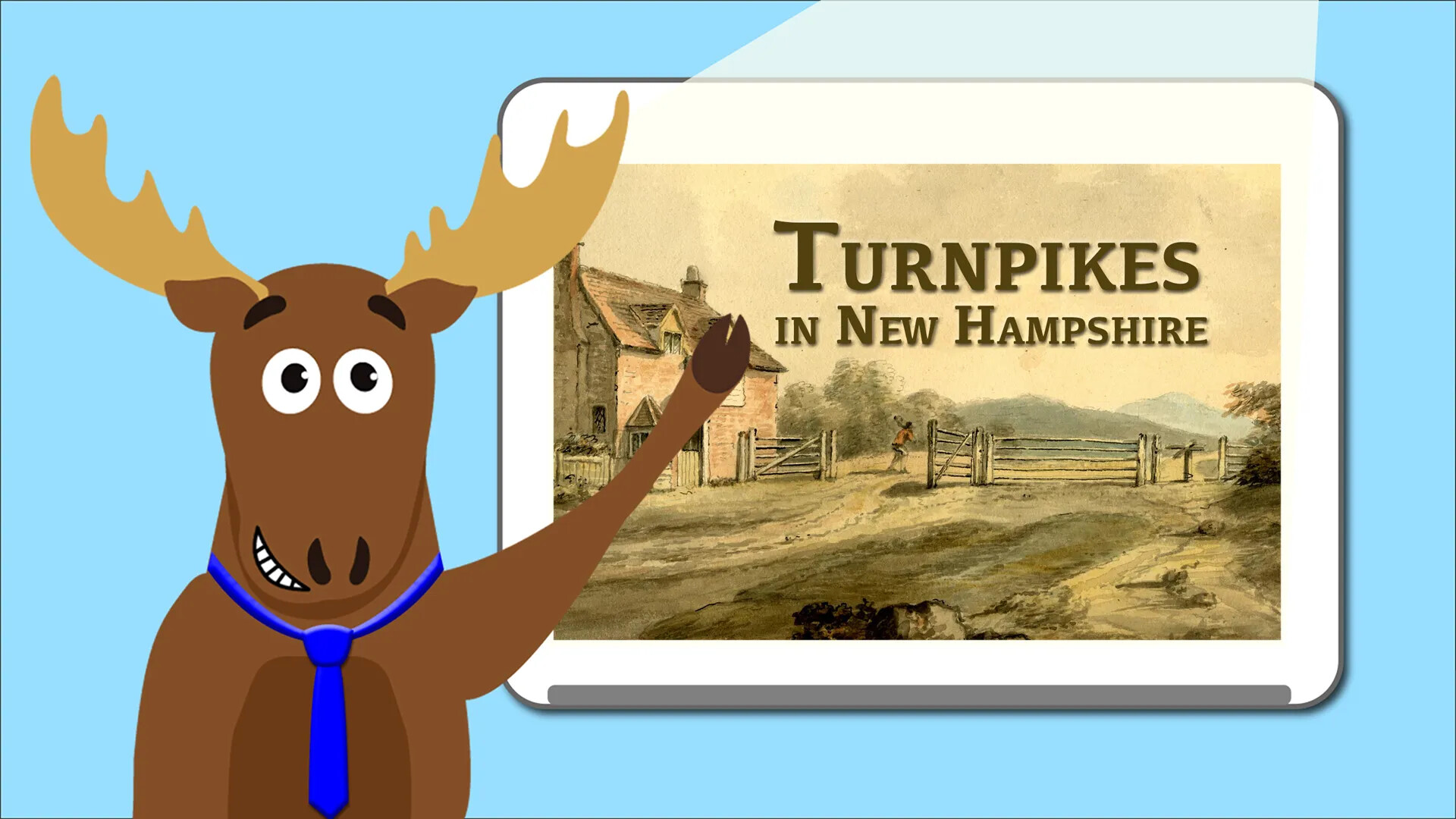
Mason Explains: Turnpikes in New Hampshire
Traveling the Roads
Other parts of the country also built turnpikes around this time to make it easier to move people and goods. In fact, the U.S. government even built a turnpike called the National Road, which went over the Appalachian Mountains to connect Virginia to Kentucky. Roads connected people all over America.
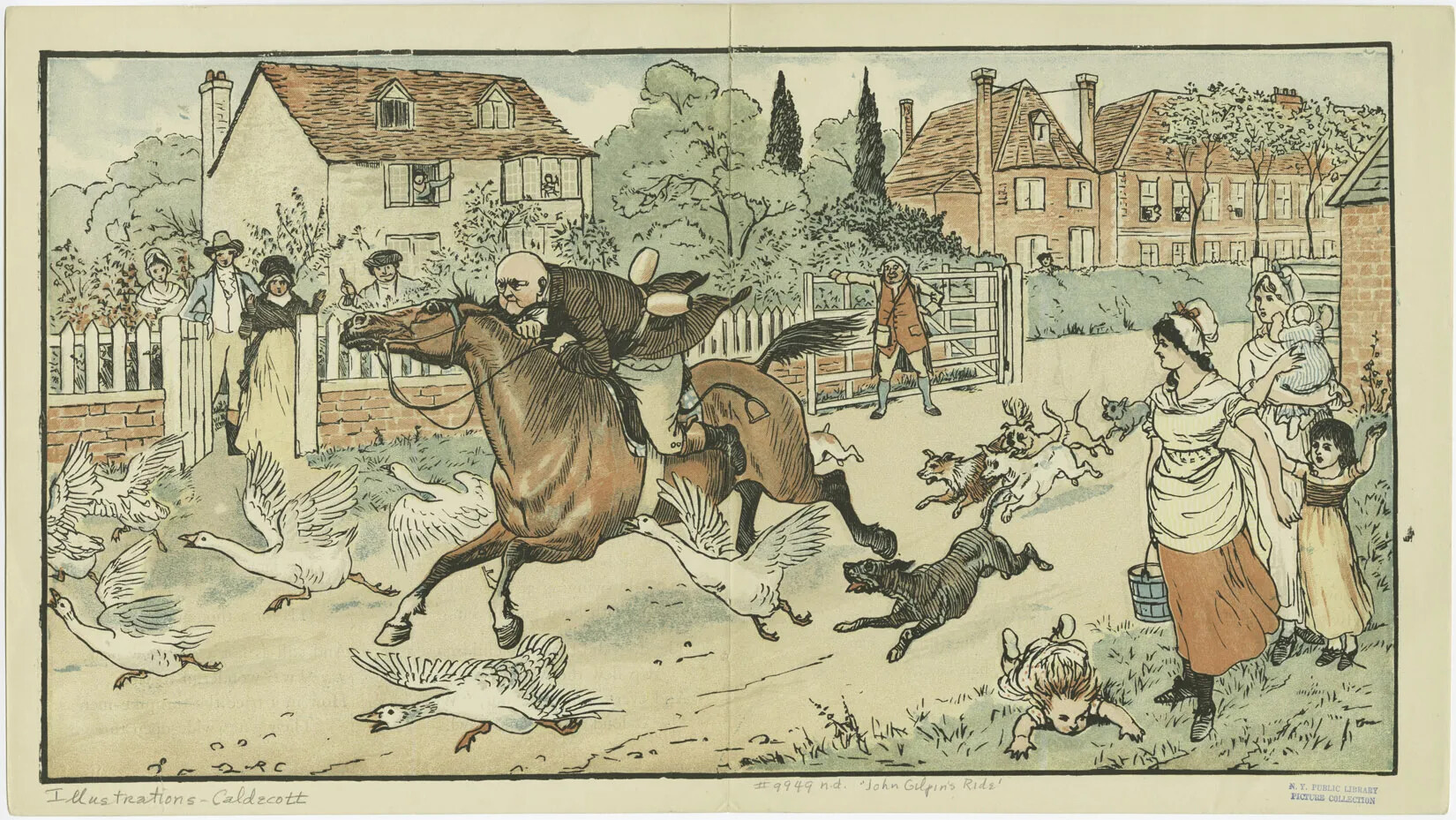
Caption:
A turnpike is a road built for heavy travel where travelers pay a toll. The toll pays for the supplies and labor to build and maintain the road. Tolls were collected at toll gates built across the roadways. Travelers could not go through the gates until they paid the toll. The state of New Hampshire started building turnpikes in the late 1700s. This picture is an illustration from a children's book printed in 1912, but it tells the story of a man who lived in the 18th century. He must have been in a hurry!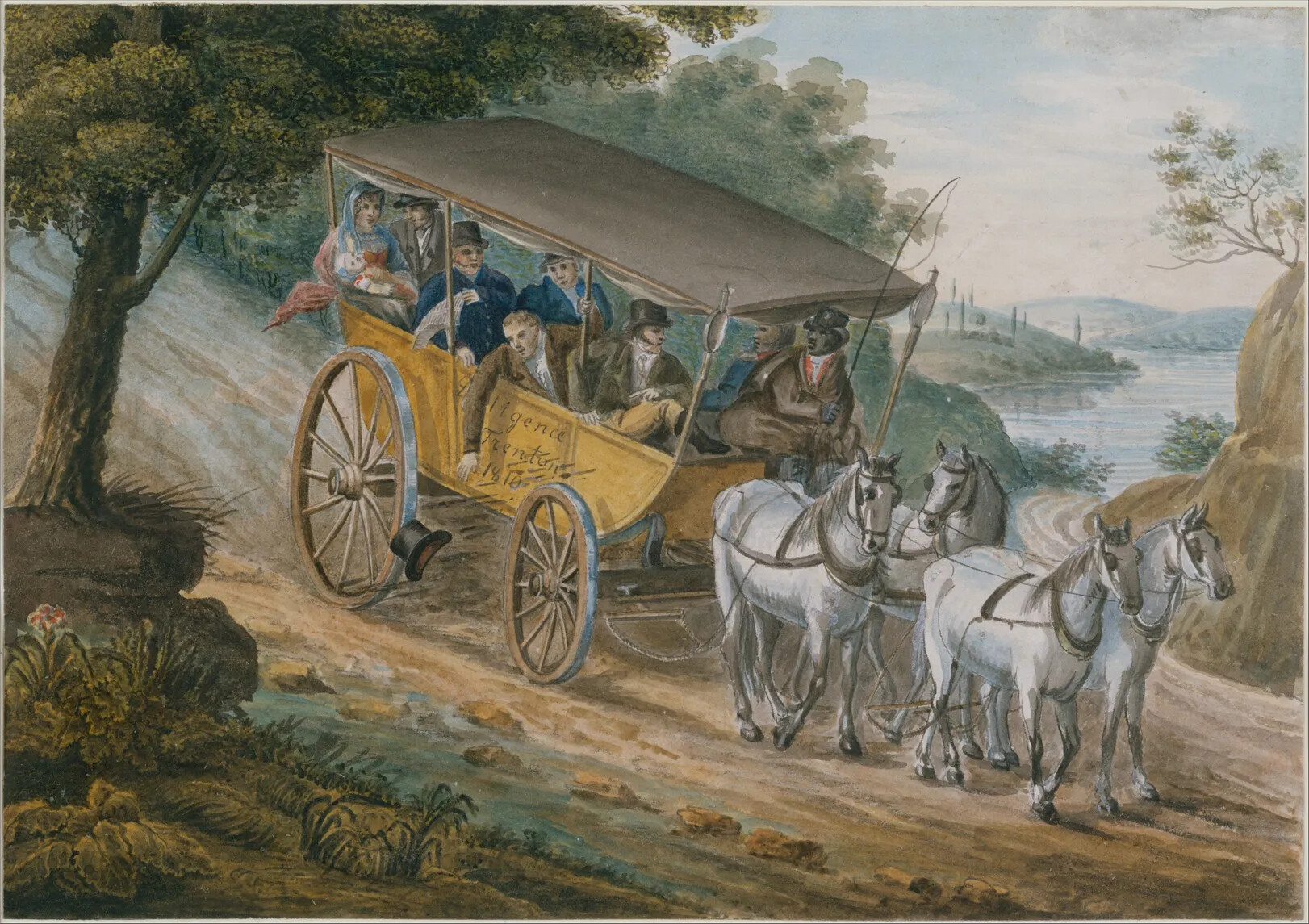
Caption:
Stagecoaches were the first form of public transportation in New Hampshire. A stagecoach is a large horse-drawn carriage that carries many people. People who didn't have their own wagons or horses could buy a ticket on a stagecoach to travel from place to place. It was much faster than walking, although coaches were usually crowded and the roads were bumpy. This painting shows a scene in New Jersey, but these types of stagecoach roads were used all over the northeastern United States.Stagecoaches. By the early 1800s, people and goods could use the turnpikes to move around the state faster than ever before, although it was still pretty slow compared to how fast we can travel on our roads today.
Not everyone had their own horse and wagon or carriage, though. Instead, people rode in stagecoaches, which were the first form of public transportation in New Hampshire. A stagecoach is a large carriage that carries many people. Some of the biggest stagecoaches could carry up to 16 people, with some passengers riding inside the stagecoach and some passengers riding on the top of the stagecoach! Riding on a stagecoach was often crowded and uncomfortable, because the road was bumpy. But it was faster to take a stagecoach than it was to walk, so many people paid for tickets to ride on stagecoaches.
In the late 1820s, two craftsmen in New Hampshire named Lewis Downing and J. Stephens Abbot came up with an idea to make riding in a stagecoach more comfortable. They designed a stagecoach that allowed the cab of the stagecoach—where the passengers rode—to swing gently back and forth instead of bounce up and down. They opened a business in Concord called the Abbot-Downing Company in 1828. Their stagecoaches became known as Concord coaches, and this type of stagecoach became the most popular stagecoach in the world.
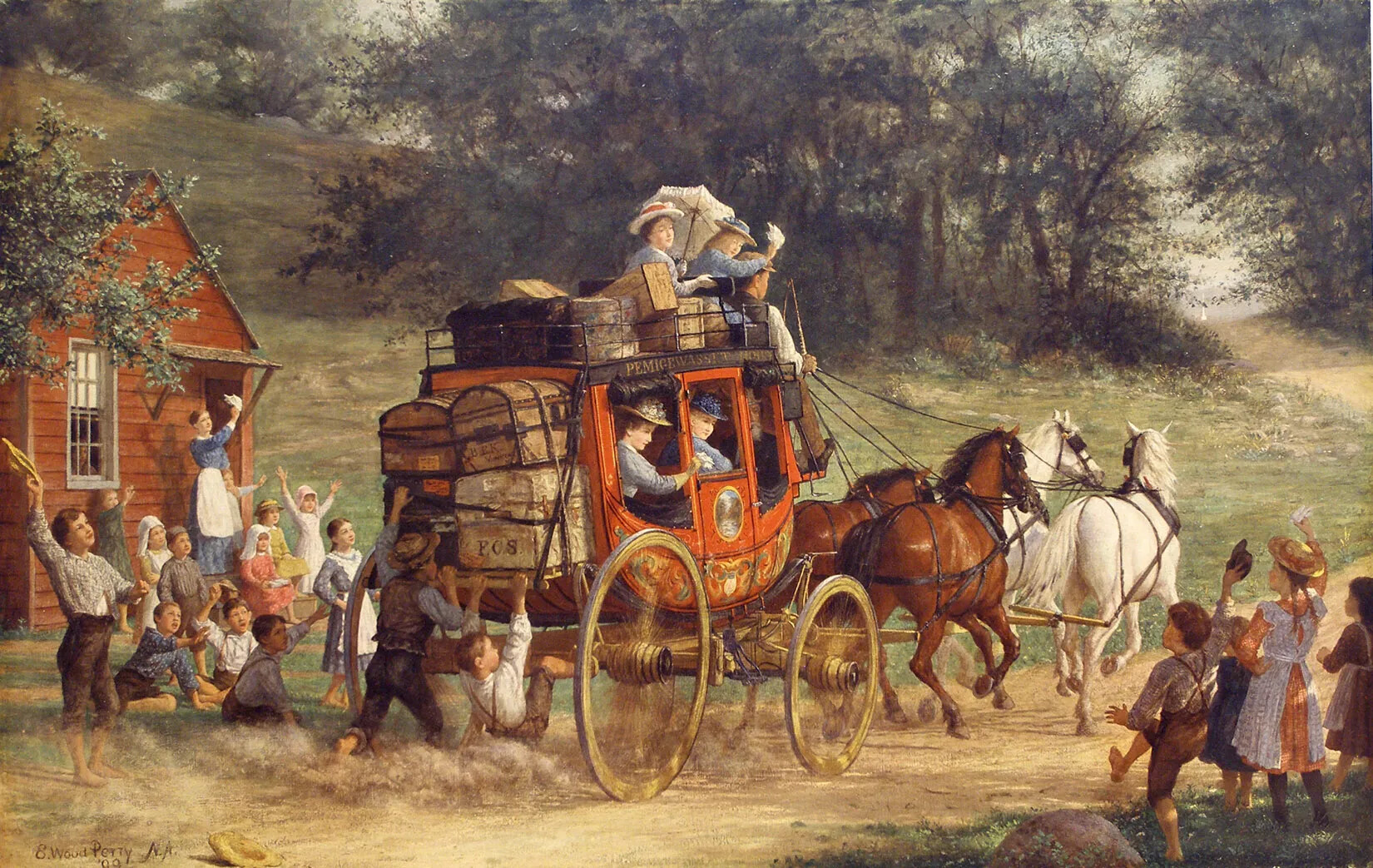
Caption:
This painting shows a Concord coach heading off on a journey. A stagecoach is a large horse-drawn carriage that carries many people. The Concord coach is a specific type of stagecoach. It was designed by two men in New Hampshire, Lewis Downing and Stephen Abbot. They designed their coach so that the cab, where passengers rode, swung gently back and forth instead of bouncing up and down on the rough roads. Concord coaches were manufactured in Concord, New Hampshire, and became the most popular stagecoaches in the world.Caption:
A Concord coach is a type of stagecoach that made travel easier and more comfortable for people in the 19th century. The Abbot-Downing Company of Concord became famous for making the best and most luxurious stagecoaches of the century. They designed their coaches so that the passenger compartment swayed gently with the motion of the horses rather than bouncing up and down. Concord coaches were widely used in the eastern portion of America until railroads became popular. Most people think of them in connection with the American West, where they were used for most of the 19th century. They were used all over the world, though, in places as far away as Australia. Wells Fargo Bank adopted the Concord coach as its symbol, which is still in use today.
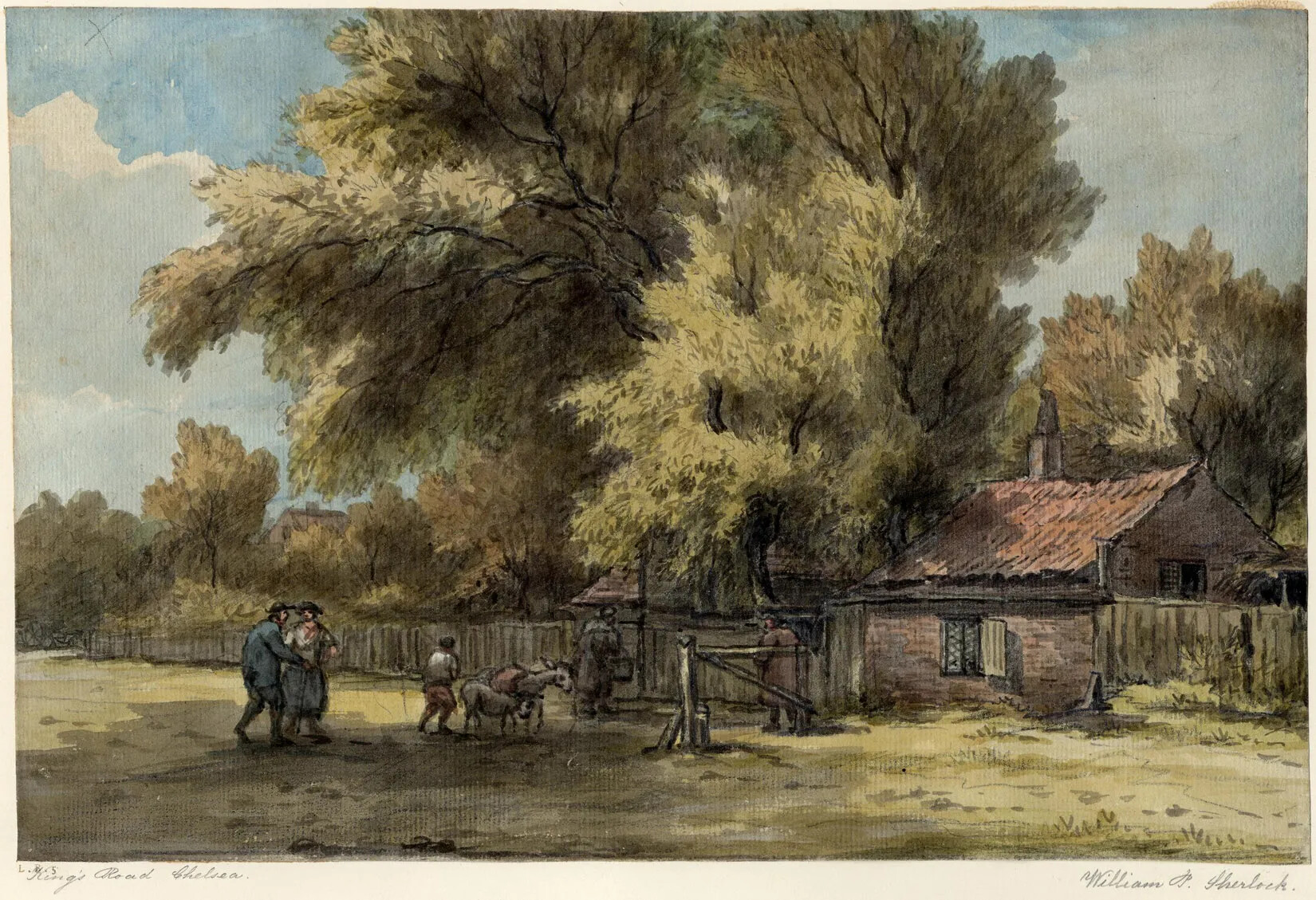
Caption:
More and more roads were built across New Hampshire in the early 19th century. People were able to travel from town to town more often. This helped people feel connected to other towns besides their own. Although this drawing shows a road in England in the early 1800s, the type of road and the type of travel at that time were very similar in New Hampshire.With a better road system throughout New Hampshire, people started traveling more from town to town to do business or to meet with family and friends. The roads helped people feel more connected to each other because they could see one another more often. People started looking beyond their own towns to make connections to people in other towns and parts of the state.
Canals. People also found other ways to travel in the early 19th century, such as using the state’s many rivers. For thousands of years, the Abenaki used New Hampshire’s rivers like highways because it was faster to travel by water in canoes than it was to travel by land on foot or horseback.
New Hampshire is full of rivers. In fact, there are over 40,000 miles of rivers in the state. Many of these rivers were not navigable, though. They have waterfalls that boats can’t get around. And not all of the rivers are connected either, so sometimes it’s hard to get from one part of the state to another part of the state by water.
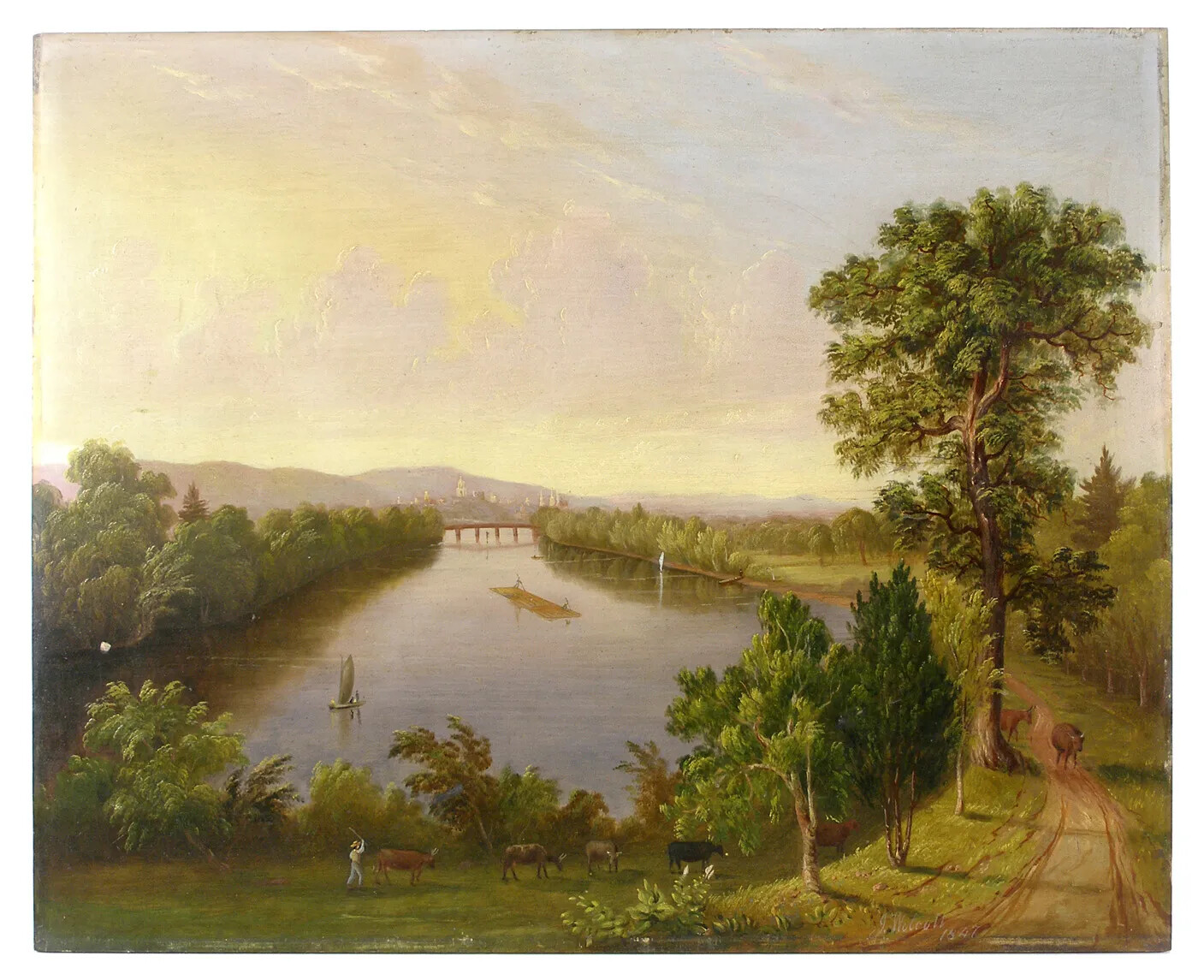
Caption:
New Hampshire is full of rivers. In fact, there are over 40,000 miles of rivers in the state! This painting shows a section of the Merrimack River just south of Concord.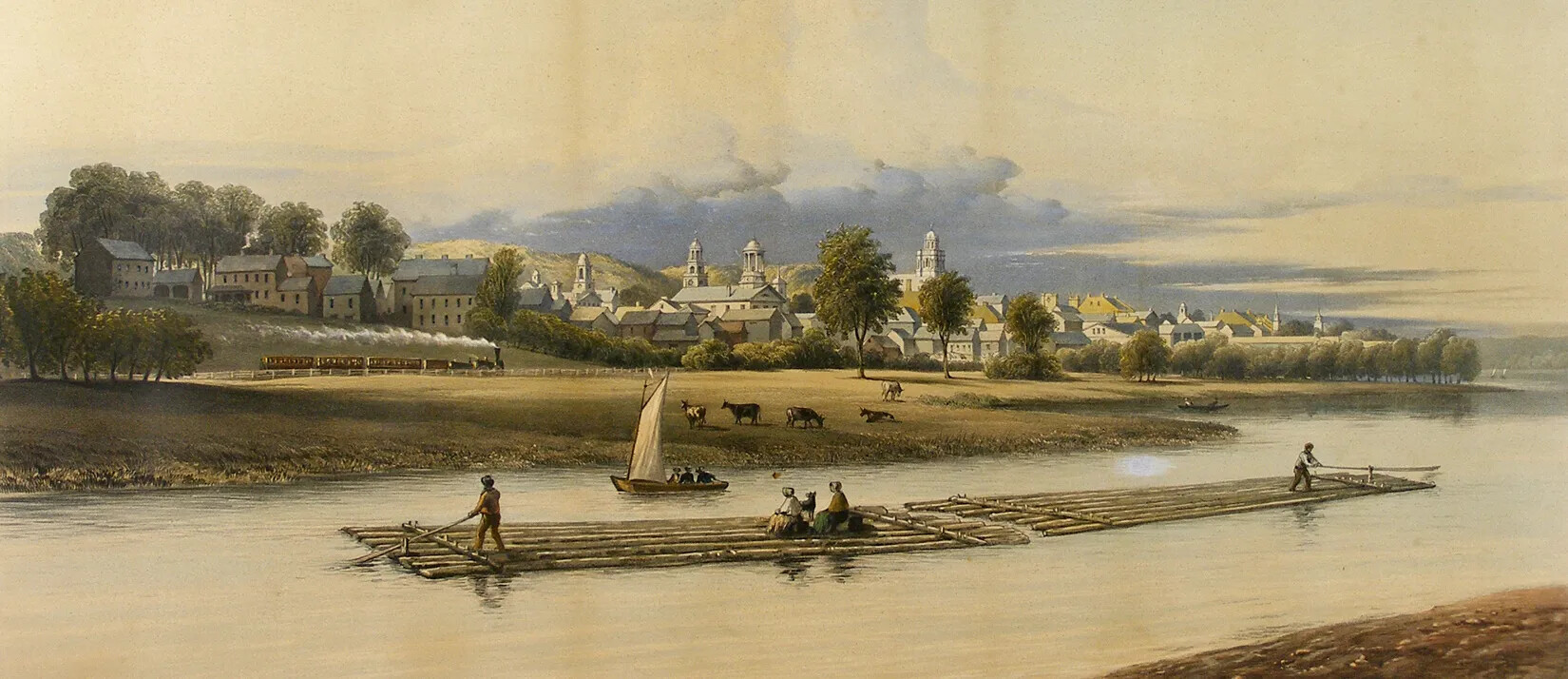
Caption:
Before trains and highways, rivers were an important form of transportation in New Hampshire. People and products moved from place to place on barges or rafts like those shown in this painting. They were made out of logs fastened together, and steered by men using long oars. Several rafts could be linked together to make one long raft. The scene in this painting is the Merrimack River in Concord, New Hampshire.Caption:
The Merrimack River is the largest river in New Hampshire. At a time when it was still difficult and slow to travel on roads, water travel was the fastest way to move goods and people from one place to another. People used rivers almost like they use highways today. The Merrimack River was an important highway because it was so big and it went through the center of the state. But it had many waterfalls and rough water which boats couldn’t get around, especially between Manchester and Concord. In the early 1800s, a series of locks and canals were built so boats could navigate around the falls. These changes made it possible for a boat to travel all the way from Boston to Concord.
Around 1800, people in New Hampshire started to build canals to make it easier to travel on the state’s rivers. Some canals helped boats go around waterfalls, while other canals linked rivers and lakes together. There were plans to build canals all over the state, but only a few of them were ever completed. The most important canals were on the Merrimack River, especially the canal that went around Amoskeag Falls. These waterfalls, which are in Manchester, are the biggest waterfalls in the state.
By 1815, the Merrimack River was navigable up to Concord. Boats could travel on the Merrimack River from Concord, which is in the middle of New Hampshire, all the way to Boston, which had a big harbor on the Atlantic Ocean. With boats able to travel between Concord and Boston, people in central New Hampshire could trade goods with merchants all over the world!
New Hampshire wasn’t the only place to build canals in the early 19th century. In fact, America was in the middle of what they called “Canal Fever” during these years. People built canals all over the place, linking communities and allowing people and goods to move around much more easily than before. The most famous canal in America was the Erie Canal, which connected the Great Lakes with the Hudson River and New York City.
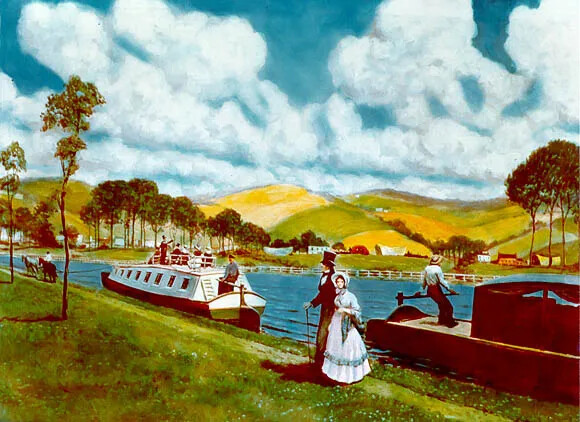
Caption:
A canal is a manmade waterway. During the early 19th century, America had "canal fever." Canals were built all over the place to connect rivers and ports. This helped people and products move from place to place more quickly. The most famous canal was the Erie Canal, which connected the Great Lakes with the Hudson River and New York City.Railroads. Just when “Canal Fever” was going strong, a new way to travel was invented that was even faster—by train.
Railroads were first invented in Great Britain. In 1827, the first railroad in America was built. it was called the Baltimore & Ohio Railroad. Soon railroads were being built all over the United States. The first railroad in New Hampshire opened in 1838.
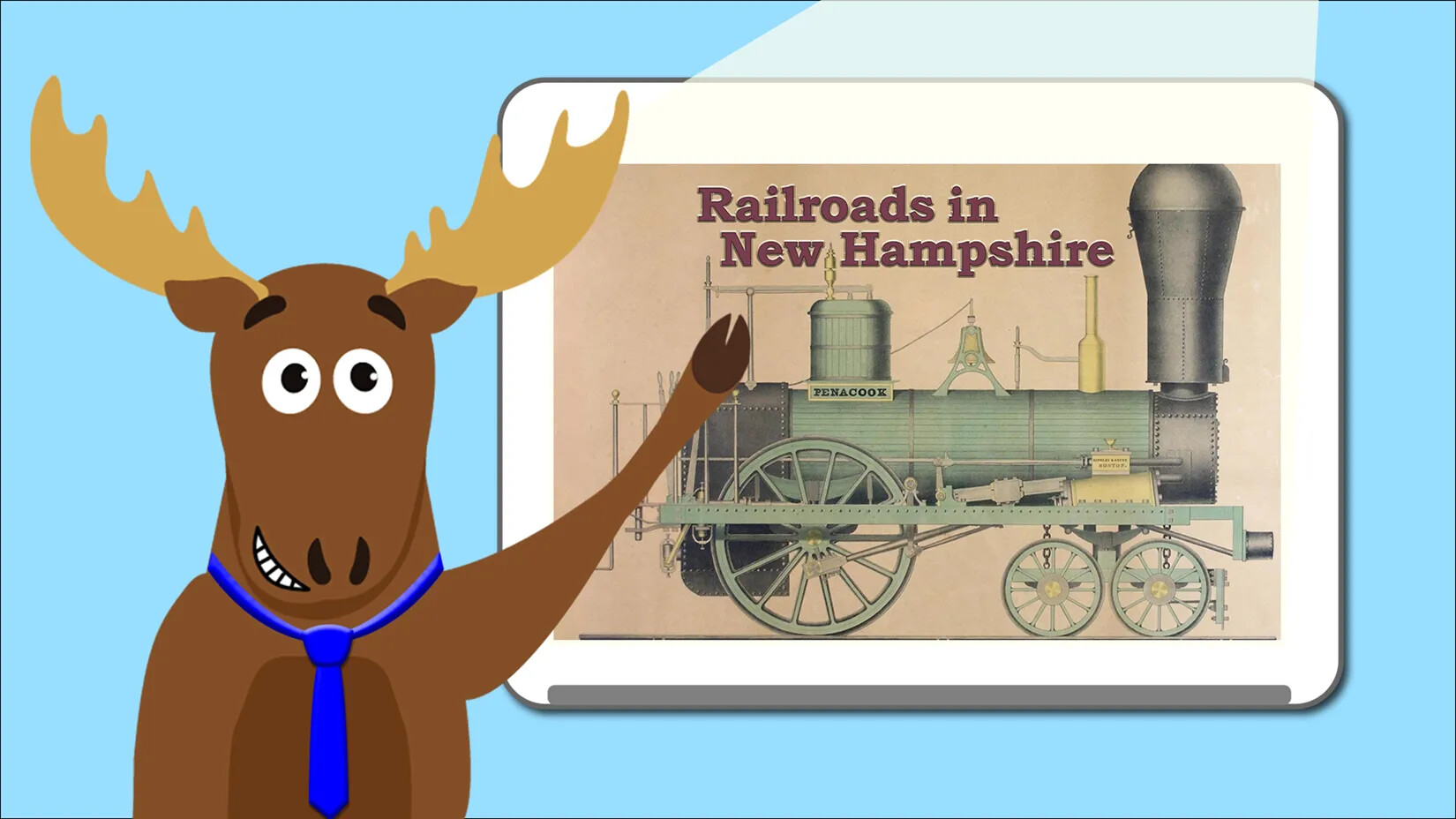
Mason Explains: Railroads in New Hampshire
Trains All Over the State!
Railroads took a lot of work to build, but once they were built, they offered the fastest form of transportation. They could cover great distances in just a fraction of the time it took to travel by boat or on horseback. They could also carry more people and goods than a boat, wagon, or stagecoach. And it was more comfortable to travel by train.
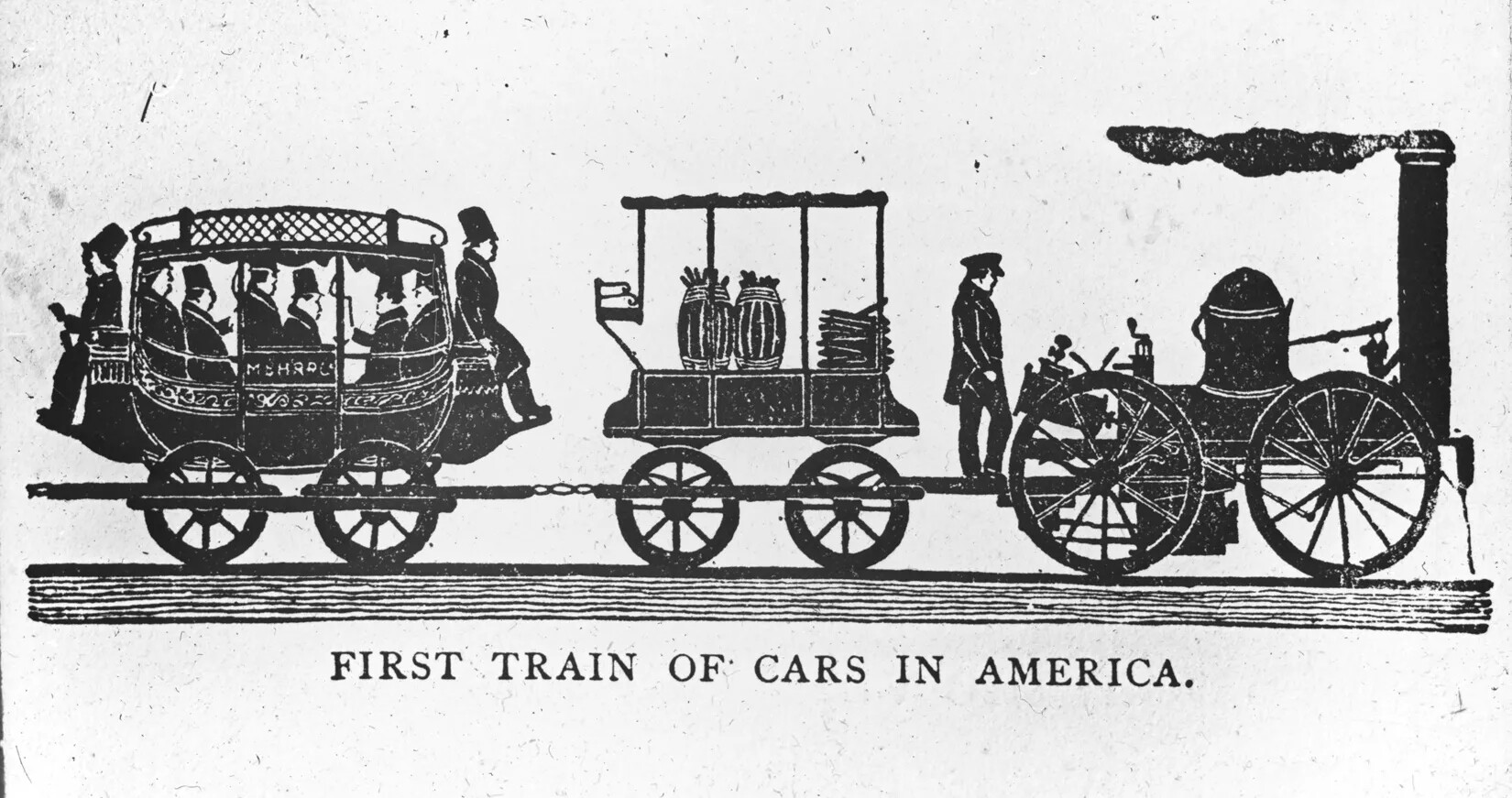
Caption:
The first steam-powered train to carry passengers in the United States ran in 1831. It took people between two towns in New York state. The first passenger cars were based on stagecoaches, but because they were running on tracks instead of rough roads, they were more comfortable than coaches. As railroads grew and the technology improved, trains became more and more comfortable for passengers.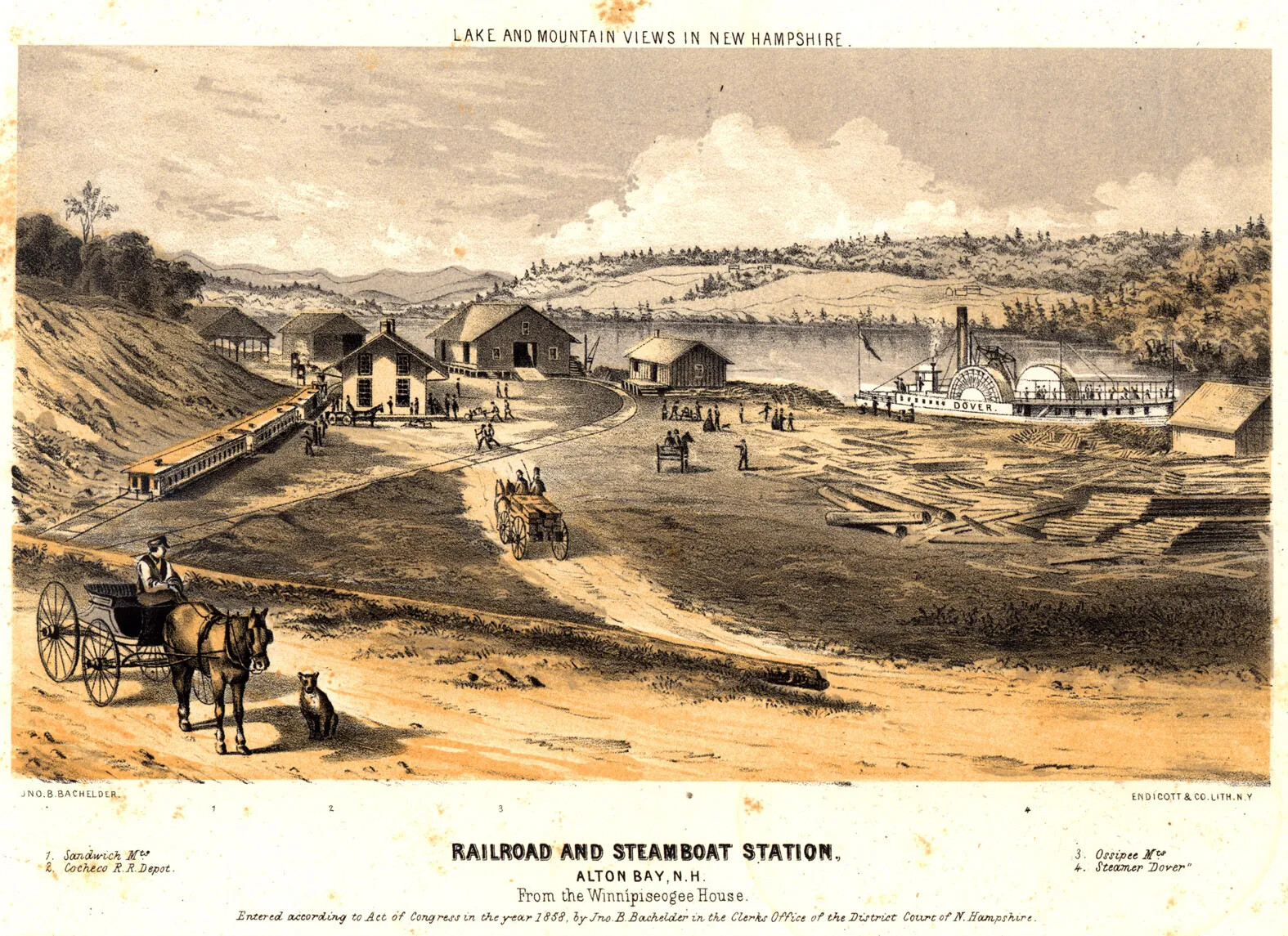
Caption:
There were so many new developments in transportation in the 19th century—turnpike roads, canals, steamboats, railroads. These improvements in transportation meant that Granite Staters were more and more connected with people outside their towns and outside their state. This is a picture of Alton Bay, New Hampshire, in the middle of the 19th century. How many forms of transportation do you notice?With all of these new ideas and new inventions, New Hampshire had a transportation network in the early 19th century that helped communities feel connected to one another. People could easily travel from one town to another throughout the state or even travel to another state. They could also buy things from elsewhere and bring them to New Hampshire. Or they could sell things they made in New Hampshire to other places in the world.
transportation network
noun
A system where goods or people pass from one place to another; transportation can be provided by animals (like horses) or machines (like railroads or cars). Transportation networks usually include roads, bridges, rail lines, canals, and other manmade improvements to the land.
Let's Review!
What are the big ideas in this section?
Transportation Network
In the early 1800s, New Hampshire built a transportation network that helped move people and goods from one part of the state to another. The transportation network also helped people feel more connected to people living in other towns.
Turnpikes
People built roads that linked towns together and made travel around New Hampshire faster. Stagecoaches were an early form of public transportation, and New Hampshire craftsmen developed the famous Concord coach to make traveling by stagecoach more comfortable.
Canals
Canals were built around New Hampshire and the United States to make it easier to travel by water. Canals helped boats go around waterfalls or linked different bodies of water together.
Railroads
By the middle of the 19th century, railroads had been built across New Hampshire. They offered the fastest way to move lots of goods and people around.
Early New Hampshire Industry
How did industry come to New Hampshire?
Until the early 1800s, almost everyone in New Hampshire was a farmer. Farming in the state was hard work. Before farmers could plant crops, they had to clear fields, which meant cutting down trees and removing all the rocks. The climate in New Hampshire resulted in a short growing season. Crops don’t start growing in New Hampshire until May, which is when it finally warms up. But by October, it’s pretty cold again, so crops don’t grow well in the fall either. Even though these were difficult conditions for agriculture, farmers still grew crops in New Hampshire such as wheat, corn, and rye.
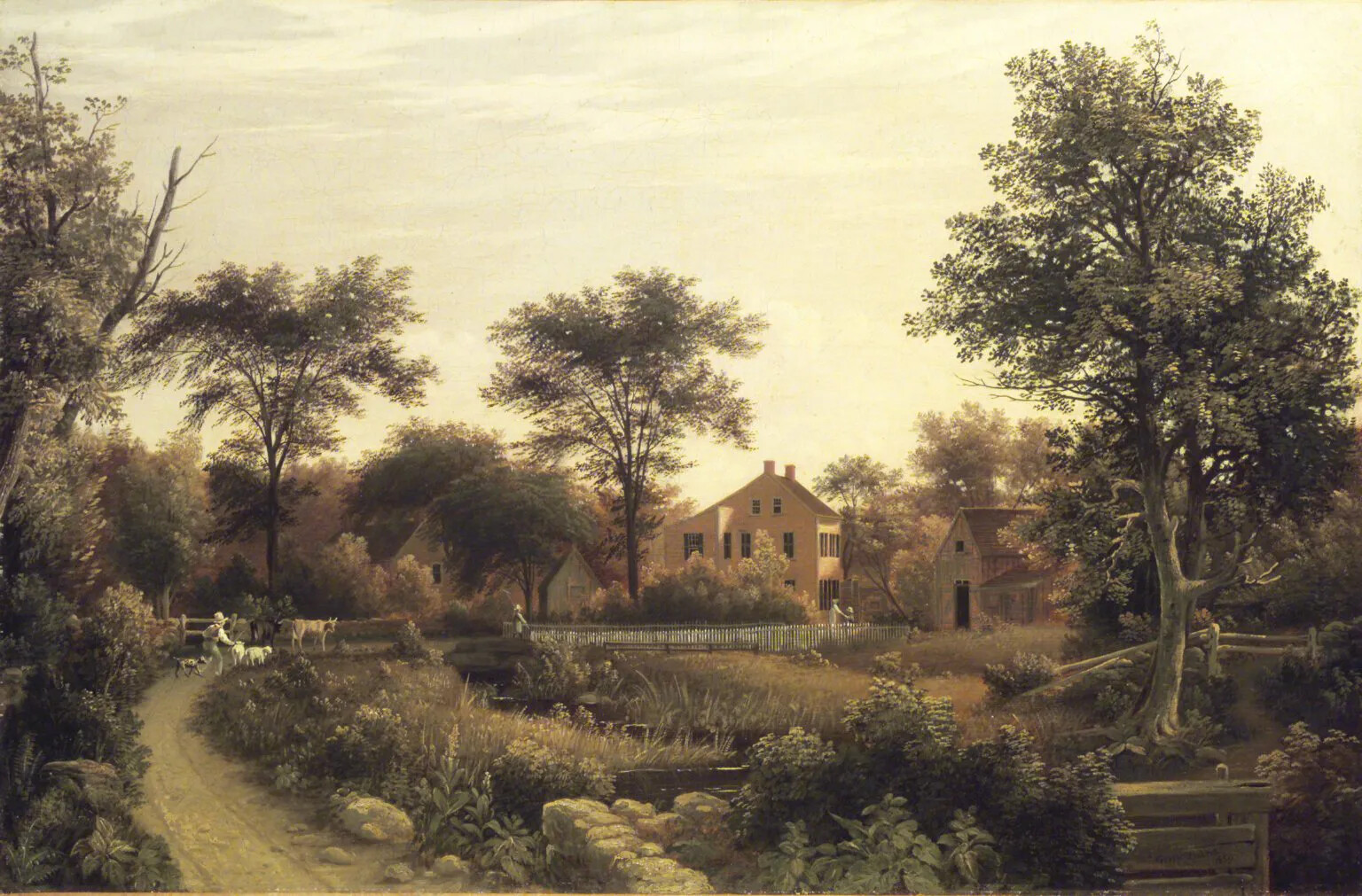
Caption:
Farming has a long and important history in New Hampshire. In the woodland period, the Abenaki planted crops. The early English settlers had to grow food to eat. Until the early 1800s, nearly everyone in New Hampshire was a farmer! Granite Staters grew all sorts of crops, including grains like wheat and corn, vegetables like squash and carrots, and they had orchards of apples and pears. They also raised livestock, like sheep, cows, and chickens, to provide milk, eggs, and meat. Agriculture continues to be important in New Hampshire today. This painting shows a very typical farmstead in New Hampshire in the early 1800s.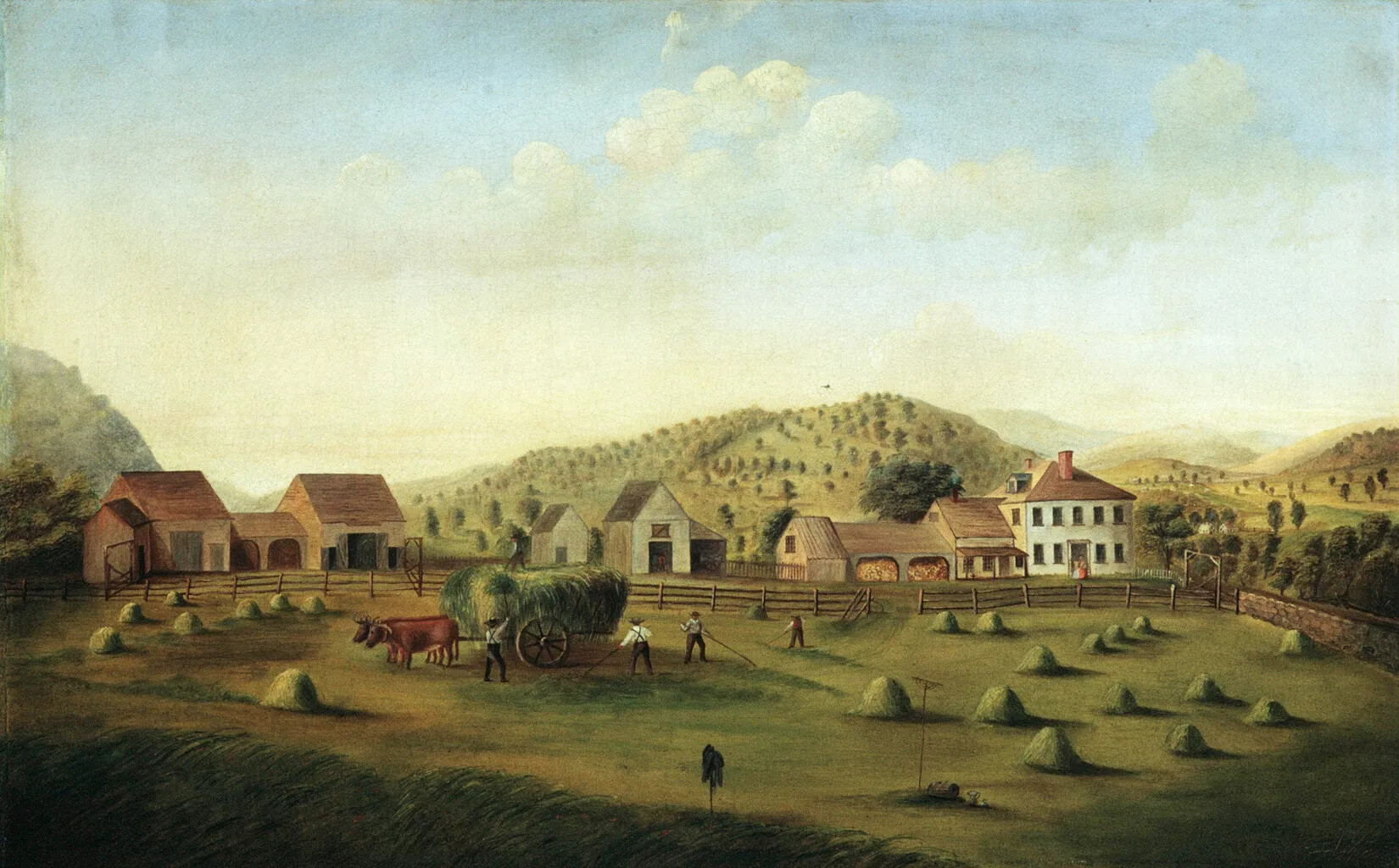
Caption:
Farming has a long and important history in New Hampshire. In the woodland period, the Abenaki planted crops. The early English settlers had to grow food to eat. Until the early 1800s, nearly everyone in New Hampshire was a farmer! Granite Staters grew all sorts of crops, including grains like wheat and corn, vegetables like squash and carrots, and they had orchards of apples and pears. They also raised livestock, like sheep, cows, and chickens, to provide milk, eggs, and meat. Agriculture continues to be important in New Hampshire today. This painting shows a very typical farmstead near Claremont, New Hampshire, in the early 1800s.In the early 1800s in New Hampshire, farming involved everyone in the family. Men and older boys worked in the fields and with large animals like horses, cows, oxen, and sheep. Women and older girls took care of the house, sewed clothing, tended the garden, prepared all the food, and watched over the children. Even very young children had important jobs to do on a farm, such as taking care of small animals like chickens or helping their mothers around the house.
Farms in New Hampshire produced many goods in addition to crops of wheat, rye, and corn. There were orchards of apples and pears. There were lots of farm animals to produce meat, leather, and other goods like wool (from sheep) or eggs (from chickens). Farm families had gardens to grow all kinds of vegetables, like beans, squash, and corn. They hunted and fished to provide food for their families. They also gathered wild fruit and berries. They kept bee hives to produce honey and made maple syrup from tree sap.
Most farmers in New Hampshire produced enough to support their families and often had some goods left over to barter with their neighbors or sell at market.
As their farms became settled and prosperous, farmers’ houses got bigger. Most farms started off with a small house but then added to it. Farm families who were doing well built a bigger house at the back of the small house or built a room that linked the house to the barn. These types of buildings are called connected houses because the different parts of the house are connected together.
Although farming was important to New Hampshire throughout its history, people found a new way to make their living in the early 19th century.
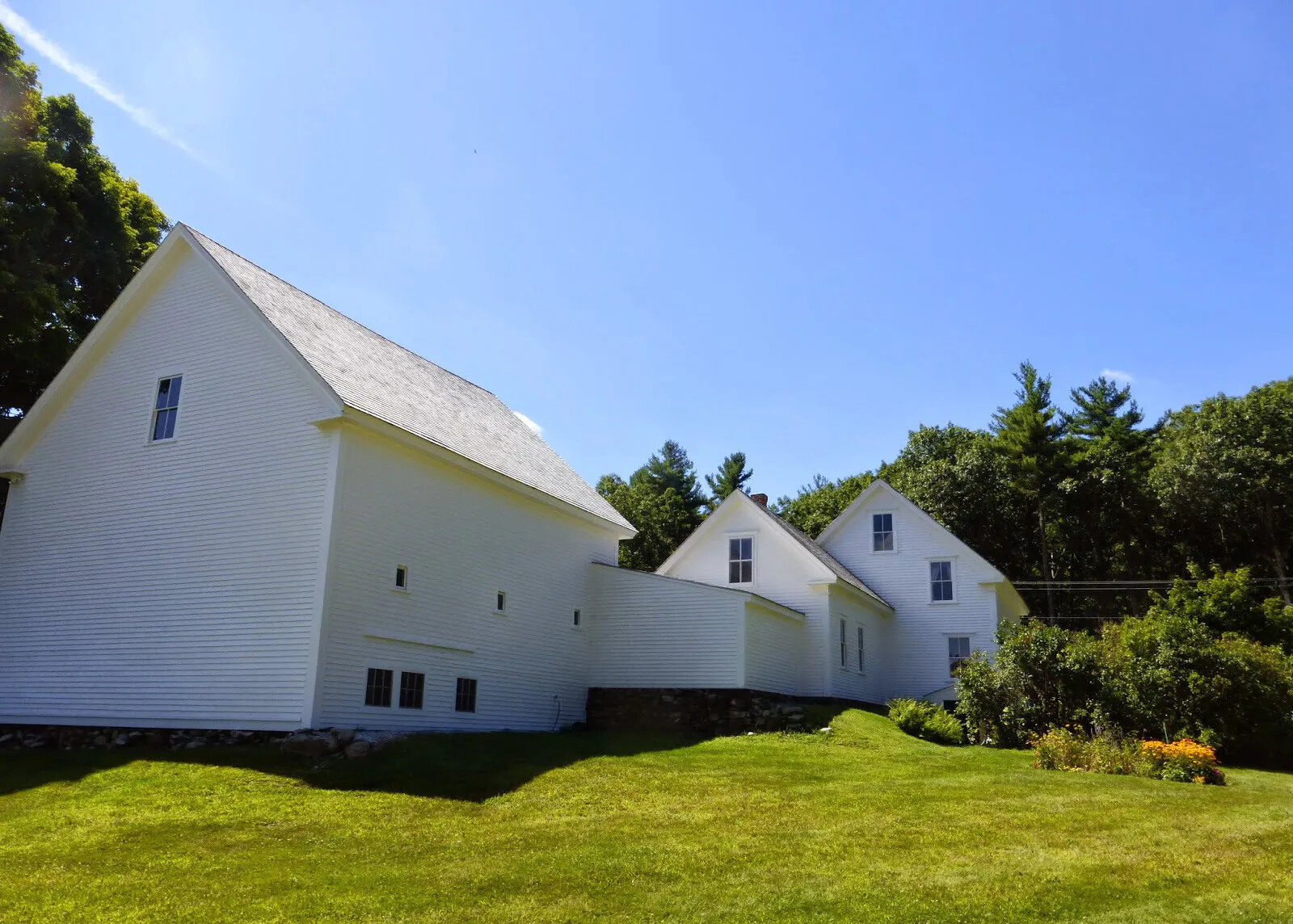
Caption:
This picture shows a connected farm. This type of housing style was popular on New England farms in the late 1700s and 1800s. Most farms started off with a small house but then added to it as the farm produced more goods. Farm families who were doing well built a bigger house onto the small house. Sometimes they also built a room that linked the house to the barn. This was called a connected farm because the different parts of the house are connected together. This was known as "big house, little house, back house, barn." This connected farm in Derry, New Hampshire, was built in the 1880s and later owned by the Frost family. A famous writer, Robert Frost, lived there with his family from 1900 to 1911.Textiles. It all started with textiles, or the production of cloth. People use cloth for all sorts of things, like clothes and bedding. In early New Hampshire, though, there weren’t stores where you could buy these things. Instead, families had to make these items themselves. Women did most of this work. They had to take the wool from sheep and turn it into clothing or other textile goods.
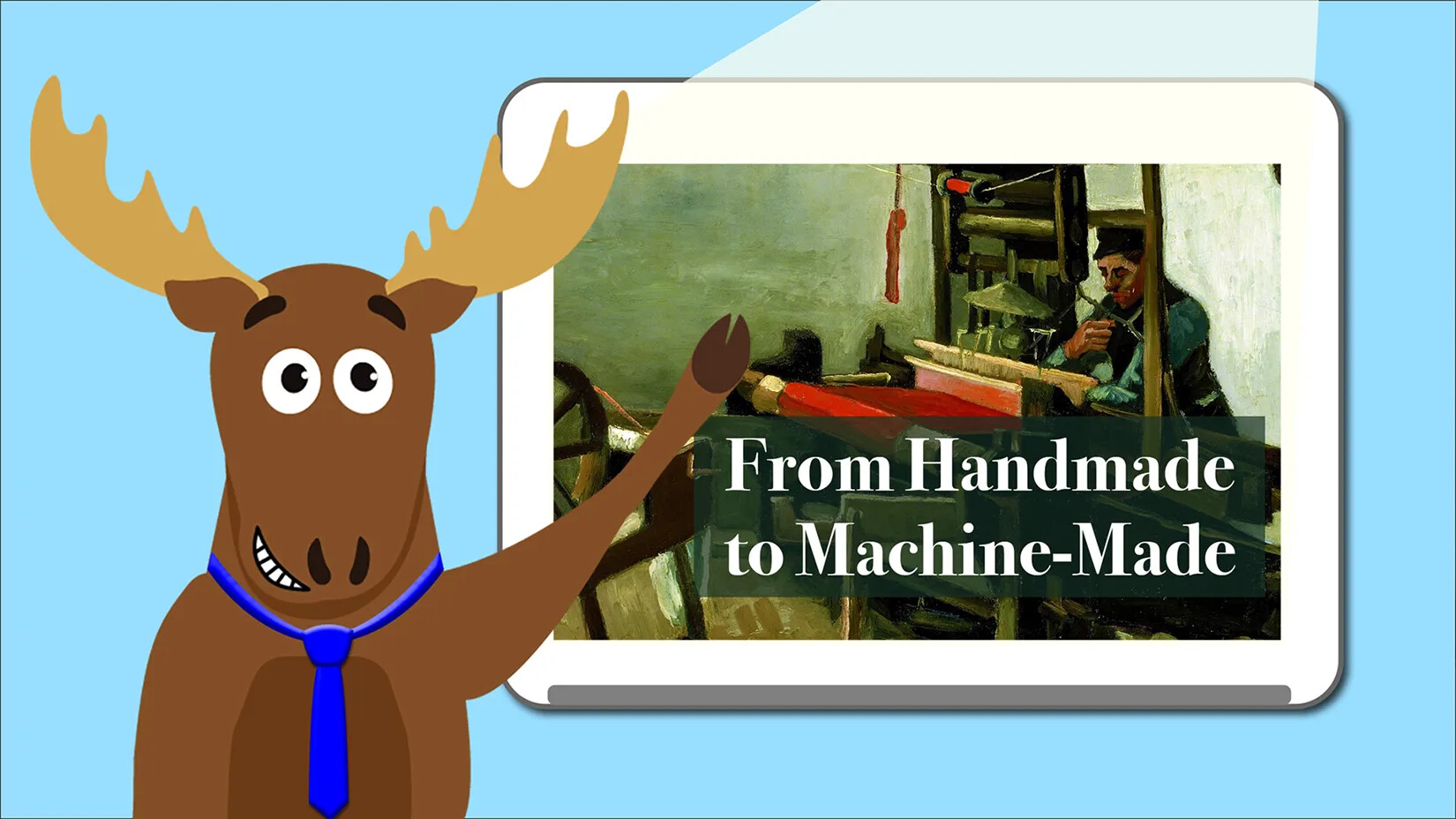
Mason Explains: From Homemade to Machine-Made
Making Cloth by Hand and Machine
In the 1790s and early 1800s, Americans realized that they could use water power and new inventions to speed up the process of textile production. The British had already started making textiles this way, and they had invented new technology to turn wool and plants like cotton or flax into cloth. But they wanted to keep this technology secret so that everyone would have to buy their textiles from British factories.
In 1789, a young British man named Samuel Slater left Great Britain and sailed for America. He had worked for a British textile factory, and he memorized the design of the new technology before he left Great Britain. When he got to the United States, he helped Americans recreate this technology and build their first textile mills in Rhode Island. The British were very angry that Slater had given away their secret inventions and called him “Slater the Traitor”! But the Americans understood that he had helped them start their own factories and mills. They called him the “Father of the Industrial Revolution.”
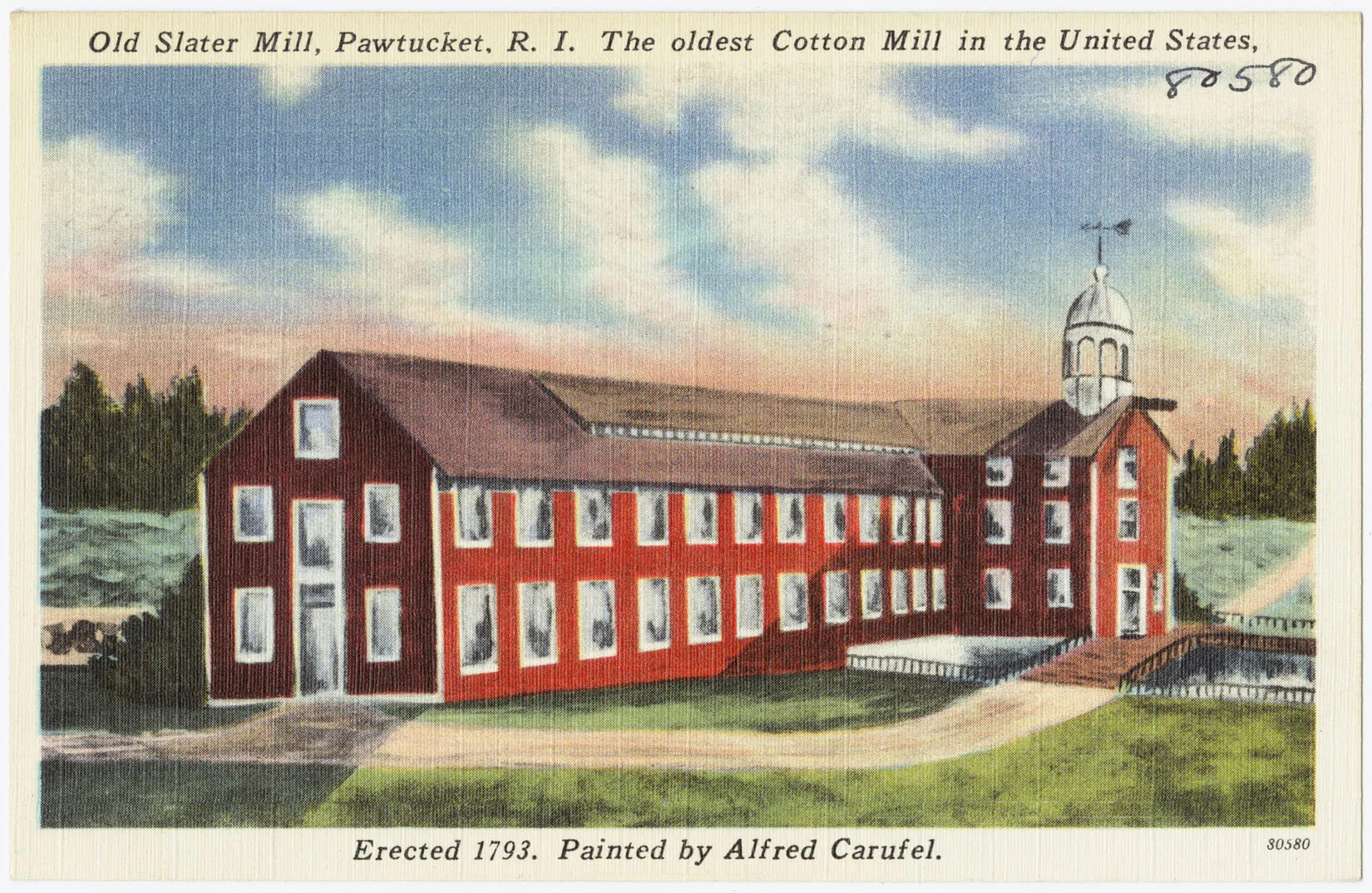
Caption:
The Slater Mill was built in Rhode Island in 1793. It was the first textile mill in America. It was named after Samuel Slater. Slater was a young British man who had worked for a British textile factory. He memorized the design of this new technology before he left Great Britain. When he got to the United States, he helped Americans recreate this technology and build their first textile mills.Caption:
The first cotton mill in New Hampshire was built in New Ipswich in 1803. It was a small mill, but it used giant machines, known as looms, to weave cloth, which would normally take a long time to weave by hand. The looms were powered by water. Because the looms could make more cloth faster, the owners of the mill made more money. The success of the mill encouraged others across the state to open their own textile mills. Eventually there were mills all over New Hampshire.
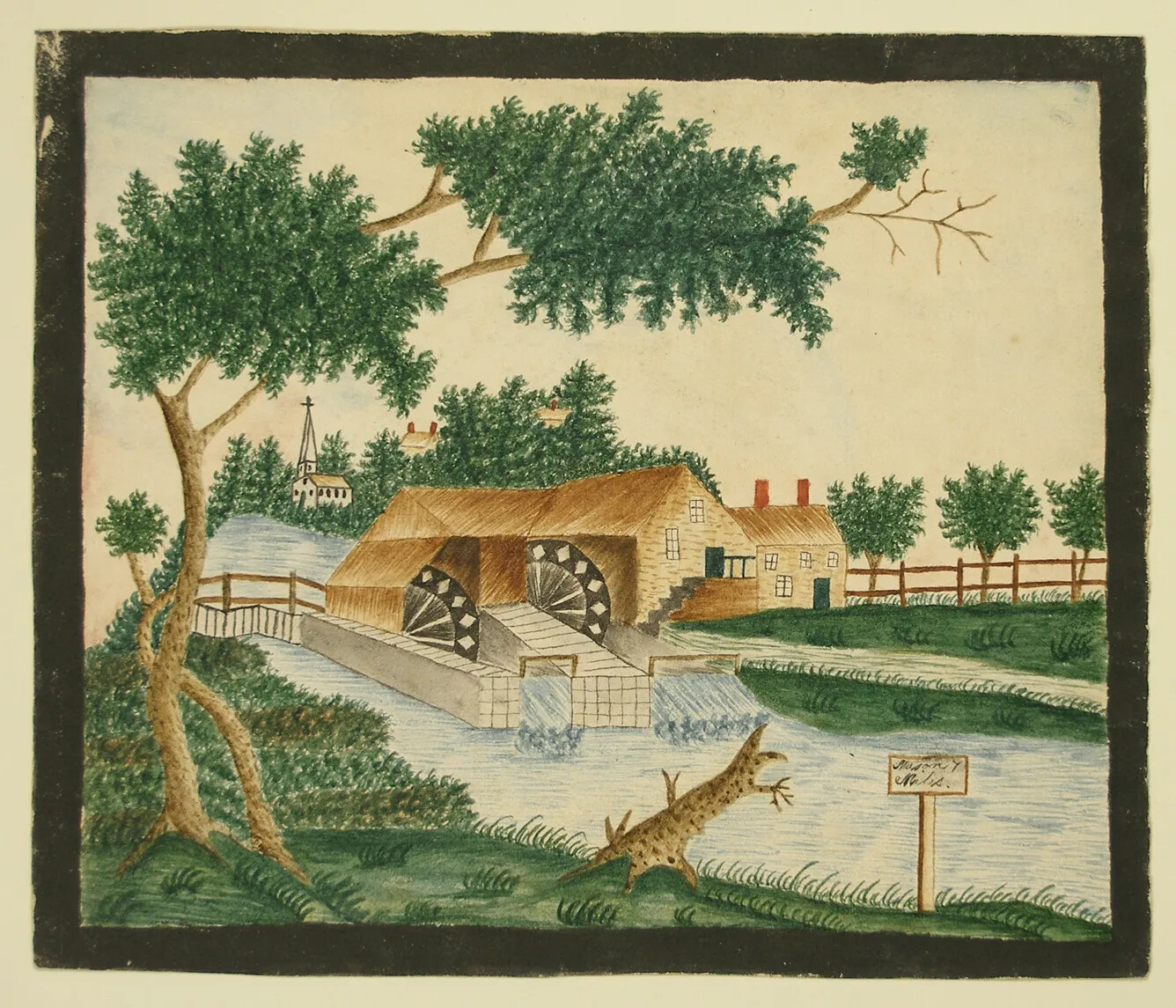
Caption:
The mill at New Ipswich, NH, opened in 1804 and was the first cotton spinning mill in New Hampshire. It used machines to spin cotton into yarn. The machines were powered by water. The river ran through a waterwheel, which was attached to a machine. When the waterwheel turned, it powered the machine.New Hampshire was the perfect place to build mills because there were so many rivers, and those rivers produced lots of water power. In 1803, Samuel Slater helped build a textile mill in New Ipswich, New Hampshire, on the banks of the Souhegan River. The New Ipswich mill used an invention called a spinning frame to turn wool into yarn faster than could be done by hand.
This step was the only part of the process that was done in a factory. Farmers would take their wool to the mill and pay the millowner to spin the wool into yarn. The rest of the work to produce textiles was still done in people’s homes using hand looms to weave the yarn into cloth.
The New Ipswich mill was just the start of factories in New Hampshire. Other places also built mills to turn wool, cotton, or flax into thread and yarn. After just a few years, textile mills had been built in Manchester, Exeter, Walpole, Cornish, and Meredith.
In the years that followed, people invented more technology to turn raw materials into textiles, and more factories were built all over the state. By the 1820s, the biggest textile mills in New Hampshire were at Somersworth and Nashua, but many towns had small factories of their own. By the 1830s, there were more than 100 textile factories in New Hampshire.
Eventually, factories created textiles from start to finish, turning wool or cotton into clothing or bedding. None of the work was done in people’s homes anymore.
New Hampshire became famous for its textile factories. In fact, the Amoskeag Manufacturing Company in Manchester eventually became the biggest textile producer in the entire world.
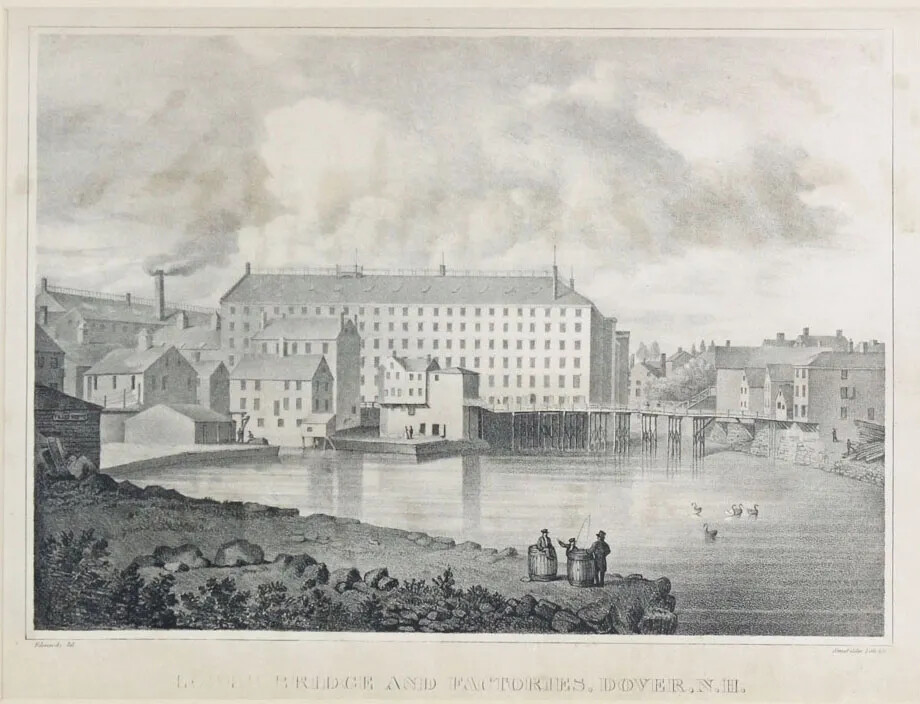
Caption:
The town of Dover, NH, has used the water power of the Cocheco River for centuries. In the 1600s it powered a sawmill and in the 1800s it powered cotton mills. This picture shows textile factories along the Cocheco River in the early 1800s.New England Mill Girls. As the factories got bigger, they needed more workers, so they hired lots of young people who didn’t want to stay on their families’ farms. At the time, women did not do the same kind of work on a farm that their brothers did, most of which required a lot of physical strength. Many people thought women could be more productive and earn more money if they worked in factories. These workers, who were usually teenage girls, became known as New England mill girls.
At first, factories gave jobs to women who lived nearby. They worked in the factories during the day and went home to their parents’ farm at night. But the factories soon got so big and needed so many workers that they had to hire women who lived farther away, which meant these girls had to leave their families and live near the factories.
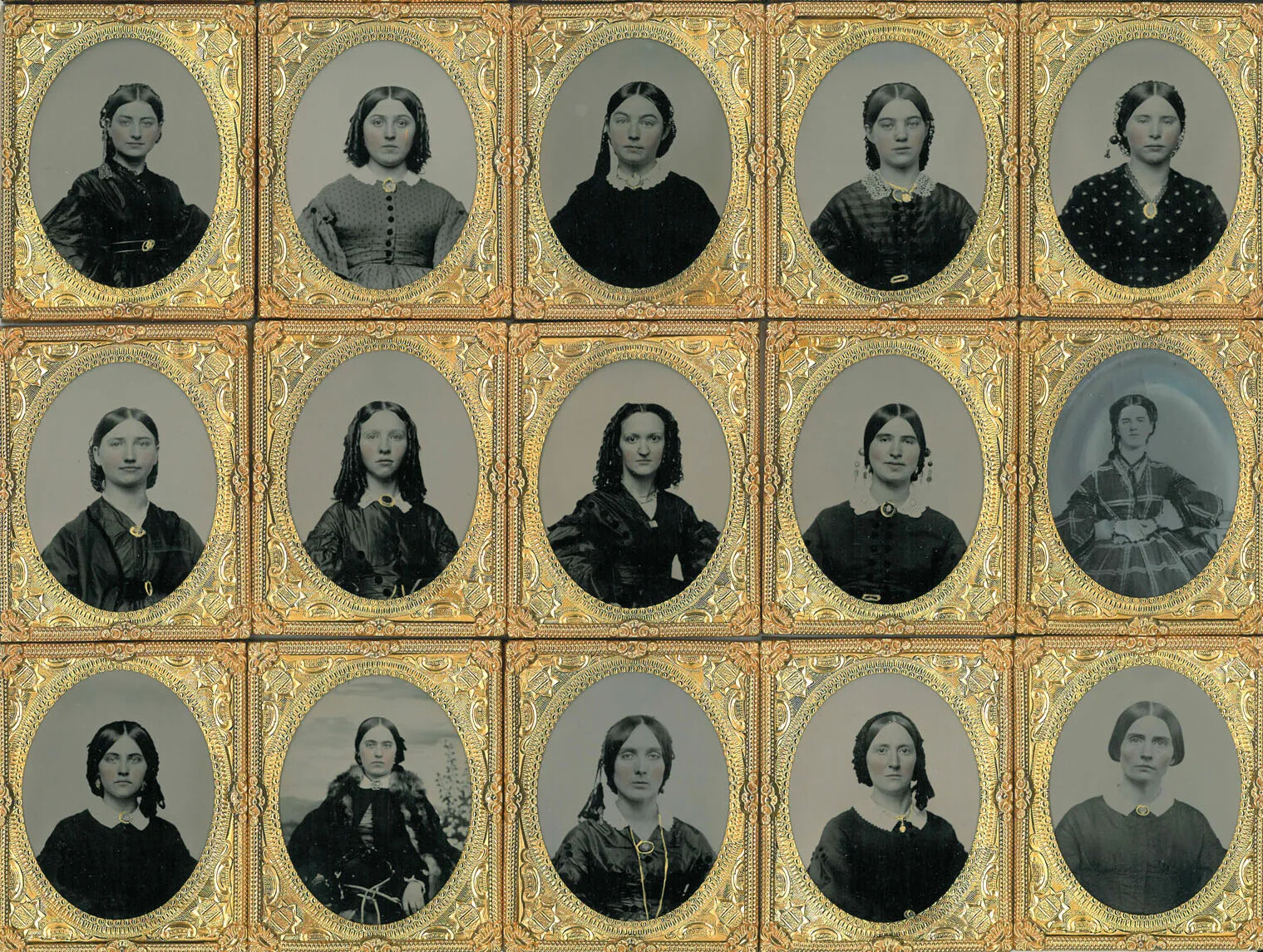
Caption:
During the early part of the Industrial Revolution, many workers in New Hampshire's textile mills were young women and girls from nearby farm towns. They were called "mill girls." They usually worked for a few years until they got married. They often sent most of the money they earned home to their families and lived in boardinghouses run by the textile companies. These women all worked together in one part of the Amoskeag Manufacturing Company.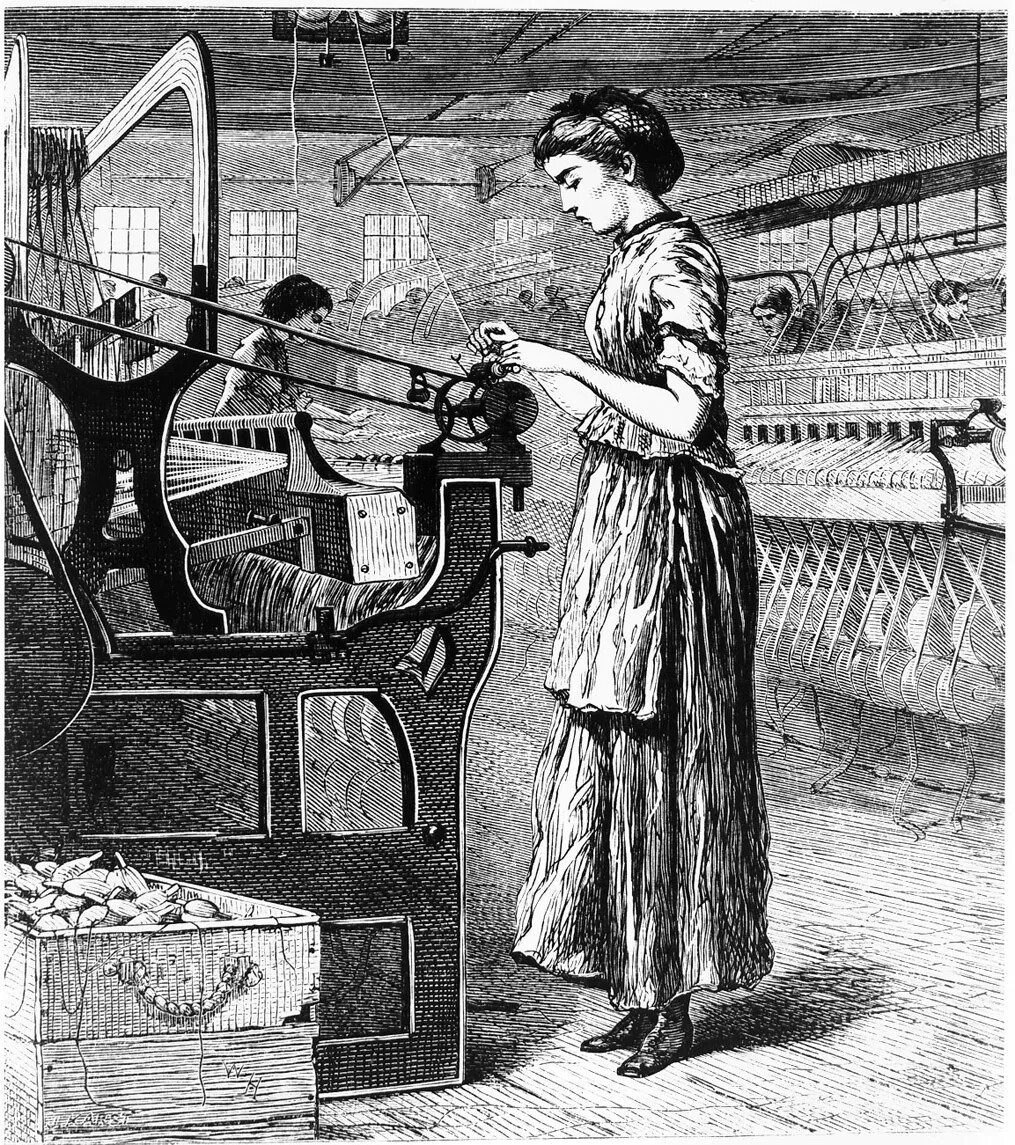
Caption:
"Bobbin girls" were young women who worked in textile mills. Their job was to wrap the thread around empty bobbins, which were wooden cylinders or cones. The full bobbins were then loaded onto shuttles. The shuttles were then put onto power looms and the thread was woven into cloth. Although the young woman in this drawing is working in a mill in Lowell, Massachusetts, many "bobbin girls" worked in mills in New Hampshire.
The first strike by women workers in the United States was in Dover, New Hampshire in 1828. A textile factory reduced the pay of the women workers, but not the men. So hundreds of mill girls went on strike. They marched through the town banging on drums and singing songs. Because they needed their jobs so badly, they had to go back to work for the lower pay. But they showed how important mill girls were to the textile factories.
Few parents in the 19th century would allow their daughters to live on their own without supervision. So the companies that owned the factories often provided housing for the girls and agreed to look out for them when they moved near the factory.
The girls lived in boardinghouses run by the company, and there was a matron (an older woman), who would take care of them. They ate their meals together in the boardinghouse and lived by strict rules that said where they could go when they weren’t working and what time they had to be back at the boardinghouse every night. The girls were sometimes allowed to go to approved activities, like church, a concert, or a lecture.
The girls earned just a few dollars a week, even though they worked 10 to 12 hours a day, six days a week. The company often sent the money the girls earned home to their parents. Once the girls got older, they usually got married and stopped working in the factories so they could take care of their husbands and children. Other girls from the farms would take their place.
Great Sheep Boom. The textile industry also changed farming in New Hampshire. As the factories began making textiles faster and faster, they needed more wool to turn into thread and eventually cloth. The farmers of New Hampshire and Vermont changed the way they farmed so they could provide factories with the wool they needed. Many farmers stopped growing crops and turned their fields into pastures where they kept flocks of sheep.
To keep the sheep from wandering away, farmers built stone walls around their pasture lands. The walls were 3 or 4 feet high. It was during these years that most of the stone walls in New Hampshire were built. In fact, you can still see many of these walls today all over the state, even up in the hills and mountains. Almost all of those stone walls were built to keep sheep in the pastures during the Great Sheep Boom. The stone walls are much lower today than they were back in the 19th century because the soil has built up around them.
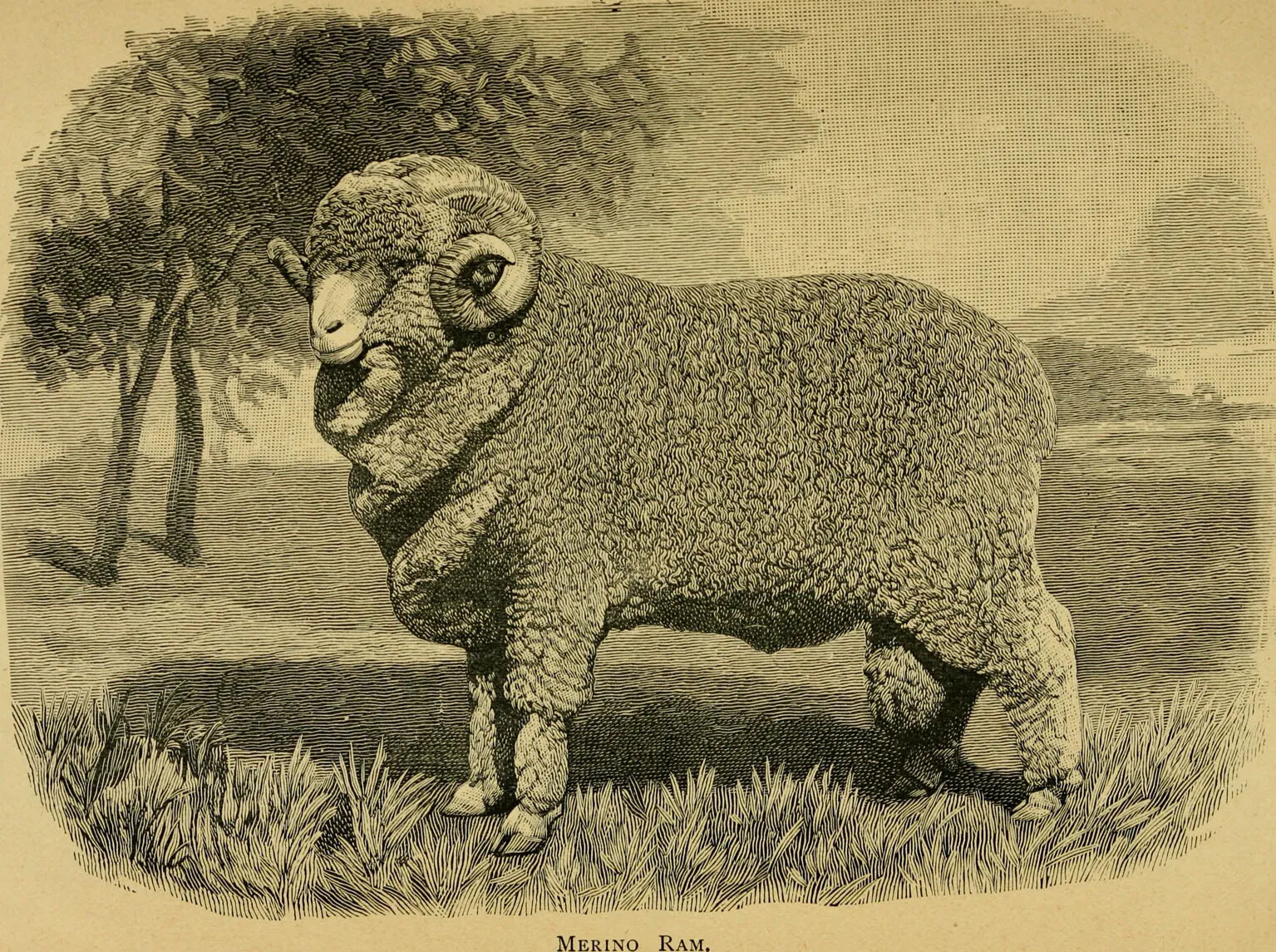
Caption:
In the early 1800s, many farmers in Vermont and New Hampshire started raising sheep. They could sell the wool from the sheep to the new textile factories. There were more sheep than people in New Hampshire! This is known as the Great Sheep Boom. Merino sheep were a popular breed of sheep to raise during this time. Merino sheep were known for being very sturdy and for producing fine wool.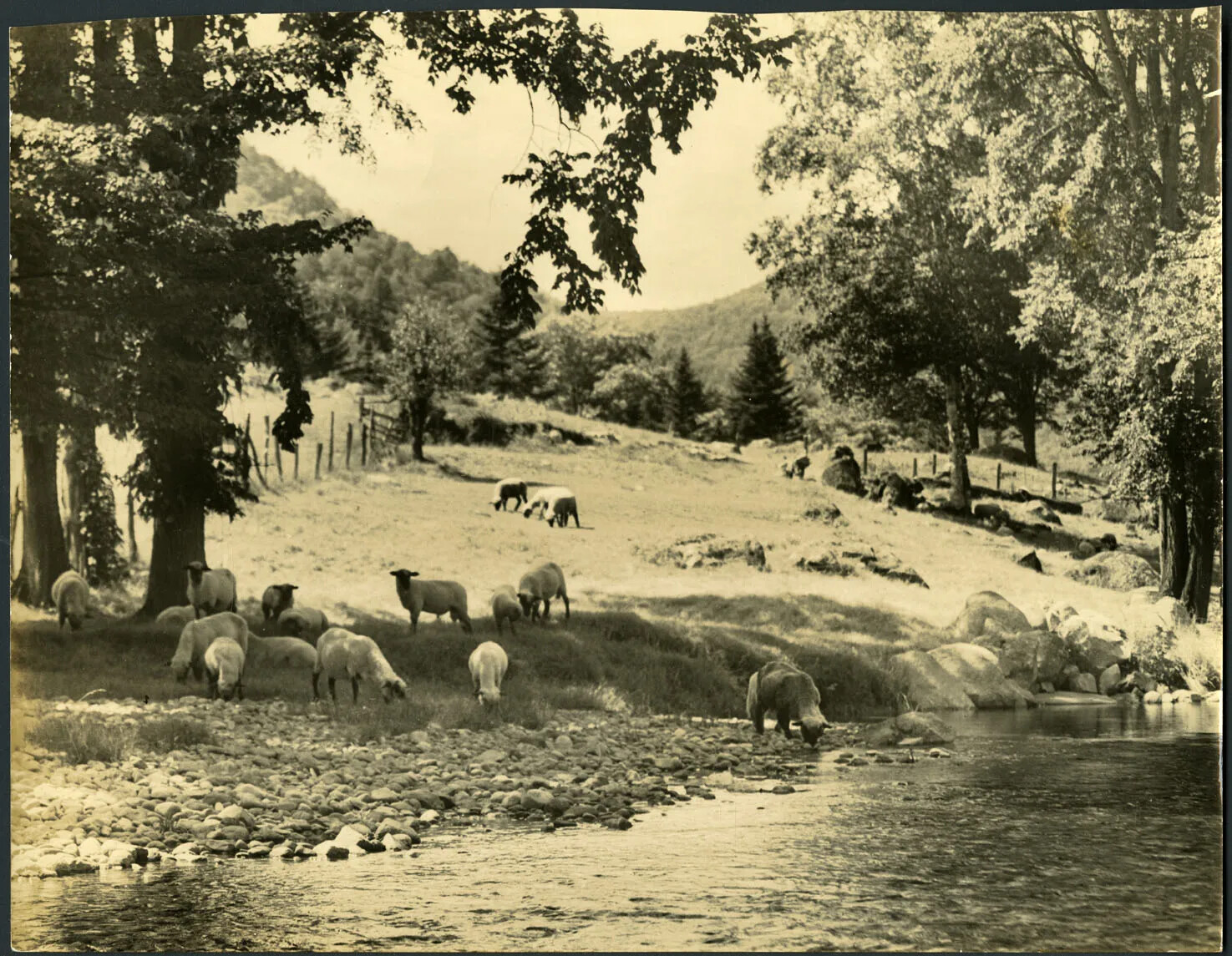
Caption:
Have you ever noticed old stone walls in your town or along country roads in New Hampshire? Many of them were built in the early 19th century to keep sheep penned in. There was so much sheep farming in New Hampshire that farmers were said to have "sheep fever." Many trees were cut down to provide land for sheep to graze on. By 1840 there were more than 600,000 sheep in New Hampshire. That's more sheep than people!In some parts of New Hampshire, farmers raised so many sheep that they didn’t grow enough food to feed themselves anymore. Instead, they had to buy their food from stores and markets. Almost every farmer in the state kept a flock of sheep and sold the wool to the textile factories. The Great Sheep Boom peaked in 1836 when there were half a million sheep living in New Hampshire. There were twice as many sheep as there were people!
After the 1830s, cloth made from cotton became more popular than cloth made from wool, so farmers in New Hampshire gradually stopped keeping so many sheep on their farms. The cotton was shipped from the southern states, where cotton was grown on big plantations by enslaved people. Textile factories still used wool but not as much as they had in the 1830s and 1840s. The Great Sheep Boom was over by 1850, but most farmers in New Hampshire still kept flocks of sheep and sold the wool to textile factories until the end of the 19th century.
Other Manufacturing. Textiles weren’t the only things that were made in New Hampshire factories. During the 1800s, all sorts of goods that used to be made in people’s homes or in small shops began to be made in factories. People found that they could produce more goods faster if they worked together. It was very different from how people had worked before.
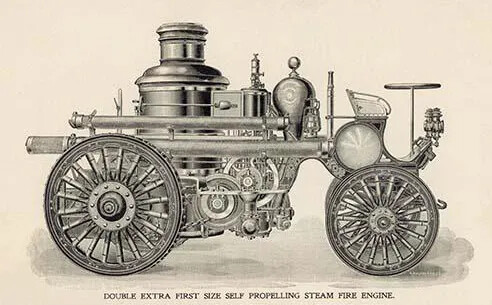
Caption:
The Amoskeag Manufacturing Company manufactured more than textiles. They also made locomotives, fire engines, sewing machines, and rifles. The Amoskeag Company had a big machine shop where they made all of their own machines for producing textiles. In the late 1850s, they decided to try to make the best steam-powered fire engine in the United States. At first they made fire engines with one or two large pumps that sprayed the water out. These could be pulled by horses or men. Then in 1867 they invented a fire engine that used steam power to move and to pump the water out, called self-propellers. These were some of the earliest motor vehicles. They could travel 10 or 12 miles per hour.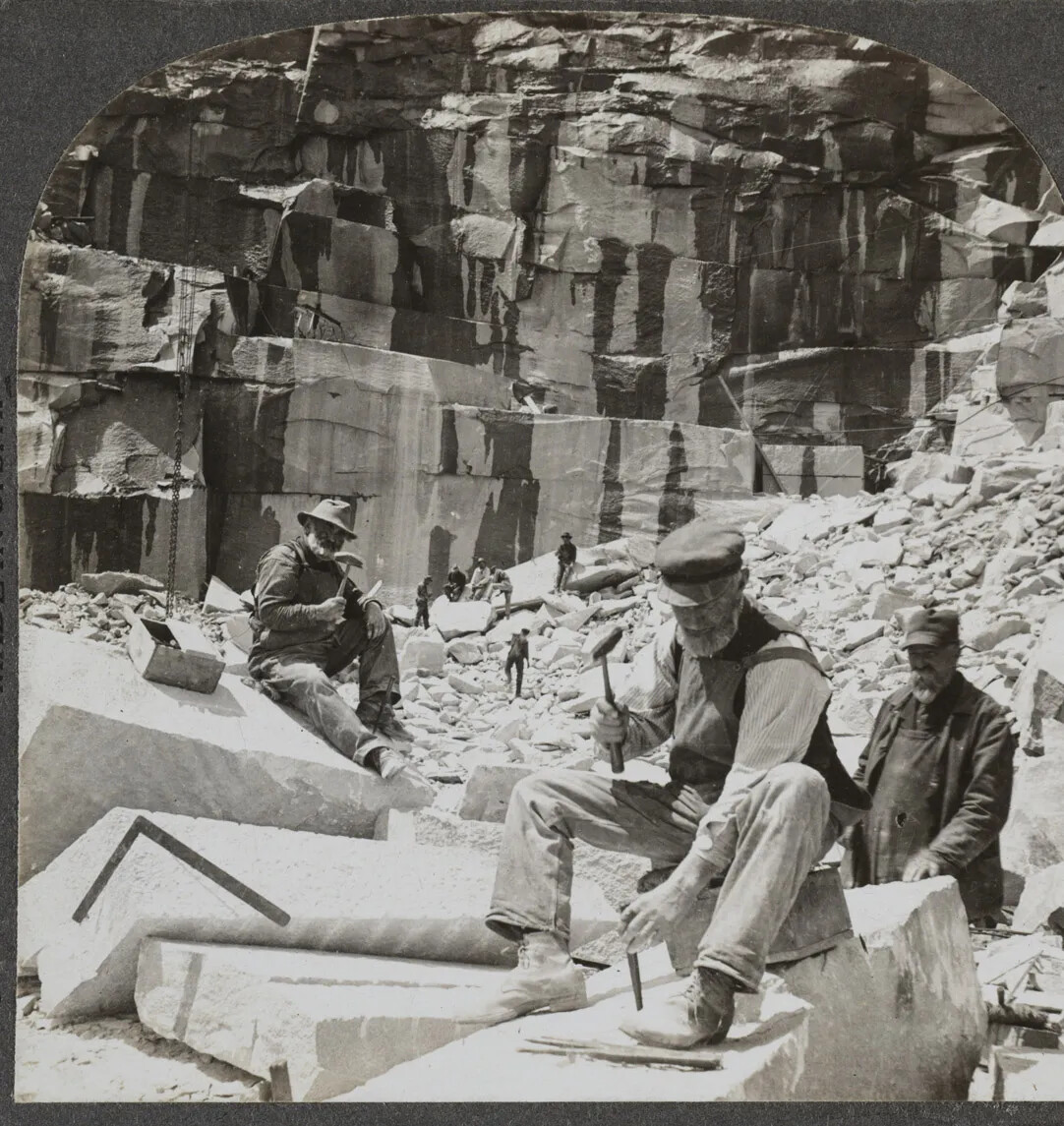
Caption:
Quarrying for granite was hard physical work. Many immigrant men held this job, which involved digging deep into the ground to remove the granite. Quarry workers, like those at the Concord Granite Company in Concord, used hand tools to split the granite into smaller pieces. Then they hammered the pieces into different shapes and sizes so they could be used for building. Granite from New Hampshire was used as a building material in many cities across the United States, as well as for the New Hampshire State House and the New Hampshire Historical Society.
Monadnock Paper Mills in Bennington, New Hampshire, is the oldest paper mill in the United States that is still in business today. It opened in 1819. The company first made paper from flax, which is a type of plant. They boiled the flax with water from the nearby Contoocook River and then flattened the flax into paper. Later they used linen rags instead of flax, and then they started using wood pulp to make the paper. The Monadnock Paper Mills still produces paper today!
Different parts of New Hampshire became known for making different types of goods. Factories in the Monadnock region made a lot of glass and paper. Concord and Amherst became centers for furniture makers and clock makers. In Bedford factories made bricks, and Manchester factories made cigars. The area around Concord became well known for its granite quarries, which were shaped into all sorts of things, like building blocks and tombstones or monuments.
By the middle of the 19th century, New Hampshire had lots of different industries. Those industries grew throughout the 19th century, and eventually New Hampshire had factories all over the state, mostly where there were rivers to provide water power that would make the new technology or machines work. This period of time was called the Industrial Revolution, when machine power replaced people or animal power to make things and most of the things people needed were made in big factories instead of small shops or their homes.
Cities grew up around the factories because of all the people who moved to be near their place of work. New Hampshire’s first city was Manchester. It became a city in 1846 because of all the factories and workers there.
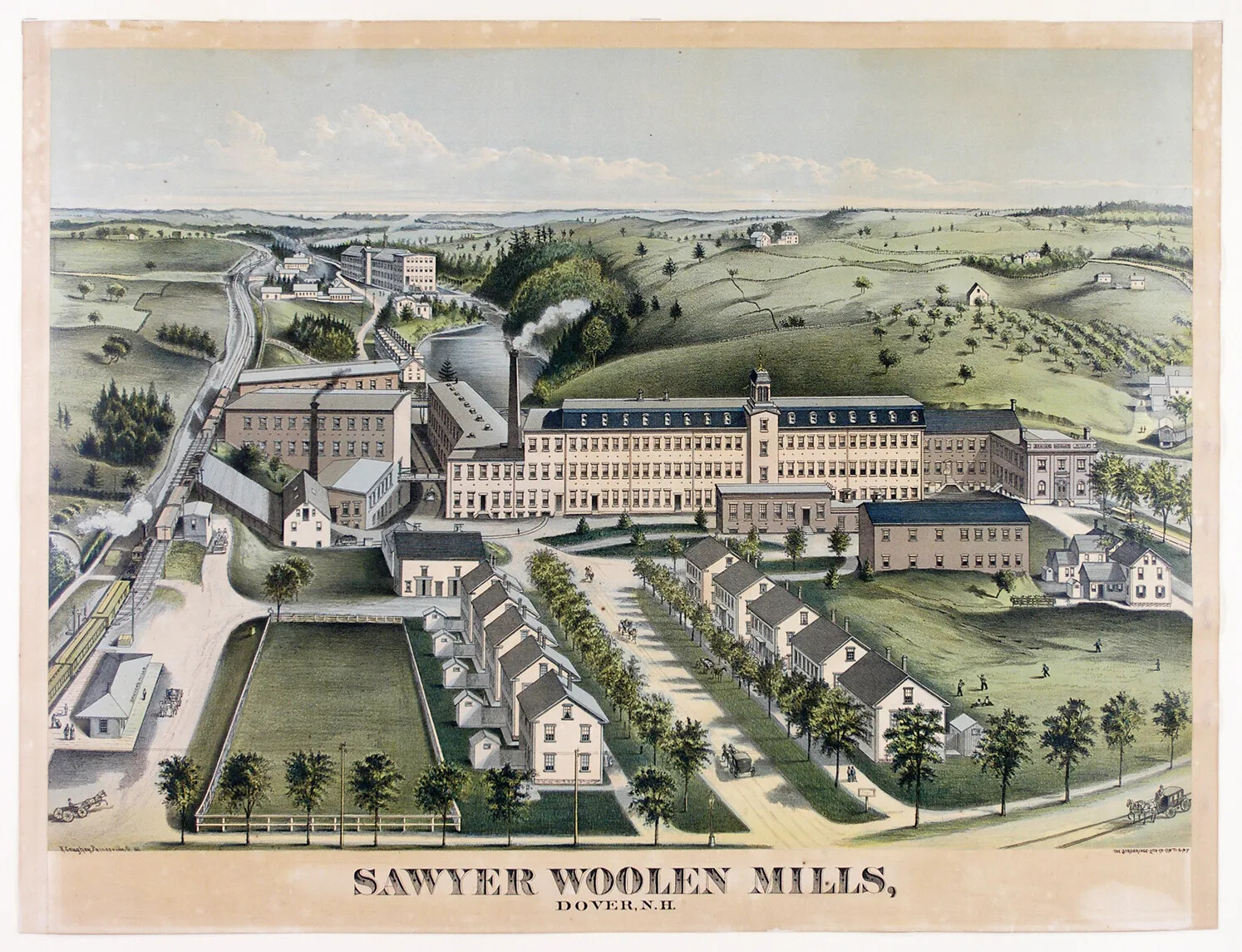
Caption:
The Sawyer Woolen Mills in Dover, NH, opened in the 1820s and was the largest wool textile factory in the country in the 1880s, until Amoskeag Mills got bigger. It is on the banks of the Bellamy River.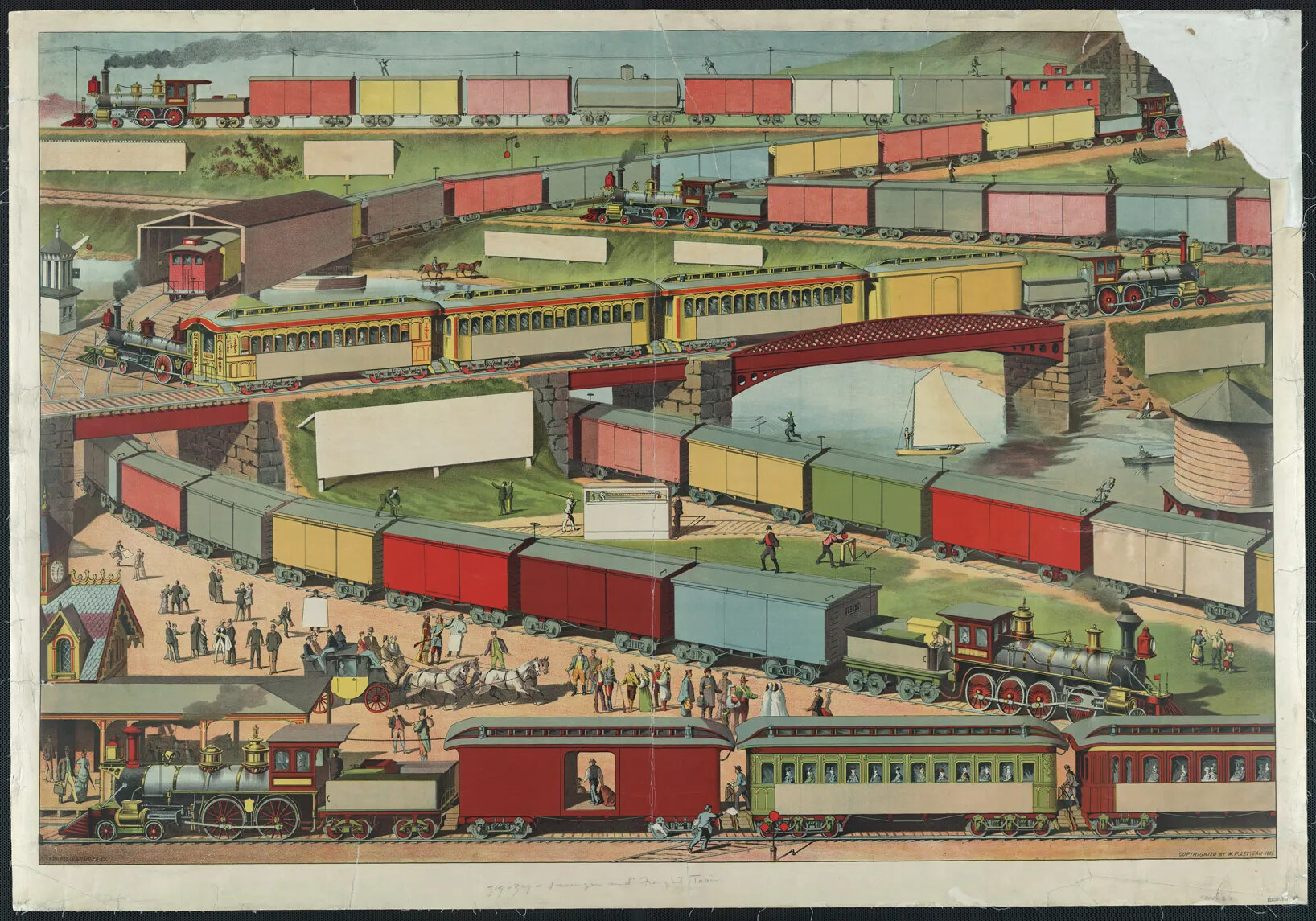
Caption:
The first railroad in New Hampshire started running in 1838. Railroads had a huge impact on the way people lived in New Hampshire and all over the country. People and products could travel more quickly and cheaply from town to town. Trains brought tourists to the seacoast, Lakes Region, and White Mountains. And the railroads also helped New Hampshire's industry grow. They brought raw materials like cotton from the South to New Hampshire's factories, and then they brought the finished products to all sorts of places to be sold. They also brought workers to the factories, like immigrants who came from Canada or people from small towns who came to work in factories in the big cities.The factories depended on the state’s transportation network for their businesses, especially the railroad. The railroad brought raw materials to the factories, like cotton from the South. And then the railroads took the finished products that had been made in the factories to other places around the country to sell. Railroads also brought workers to the factories. For places that didn’t have a railroad, the roads allowed goods and people to be moved from one place to another.
transportation network
noun
A system where goods or people pass from one place to another; transportation can be provided by animals (like horses) or machines (like railroads or cars). Transportation networks usually include roads, bridges, rail lines, canals, and other manmade improvements to the land.
Let's Review!
What are the big ideas in this section?
Farming
Most people in New Hampshire were farmers in the early 1800s. New Hampshire farm families produced a wide variety of goods to survive.
Textile Factories
Factories started to appear in the state in the early 1800s, using water power to produce textiles by machinery rather than by hand. Girls from New Hampshire farms worked in the textile factories.
Great Sheep Boom
As the factories produced more textiles, they needed more raw materials like wool. Most New Hampshire farmers stopped producing food and began raising large flocks of sheep so they could sell their wool to the factories.
Other Manufacturing
Craftsmen started producing all sorts of goods in the early 1800s for people to buy. Different parts of New Hampshire became known for making different types of products.
The Market Revolution
How did people’s ideas about money change in the early 19th century?
Industrialization changed the way people earned their living and changed the way people thought about money.
Before the Industrial Revolution, most people produced enough goods on their farms to support themselves and their families. Sometimes, they even had a little left over that they could sell at a market or trade with their neighbors. One farmer might grow more apples than his family could eat, so he would trade the extra apples with another neighbor who had grown a big crop of corn. This kind of economic exchange is called the barter system. Instead of using money to buy things, people trade what they have for what they want.
People even paid the minister in their town by providing him with food and supplies rather than giving him money. And sometimes people paid their taxes to the town by doing work for the town, like fixing a road or building a bridge. Most people did not use money very often. Instead, they bartered with people.
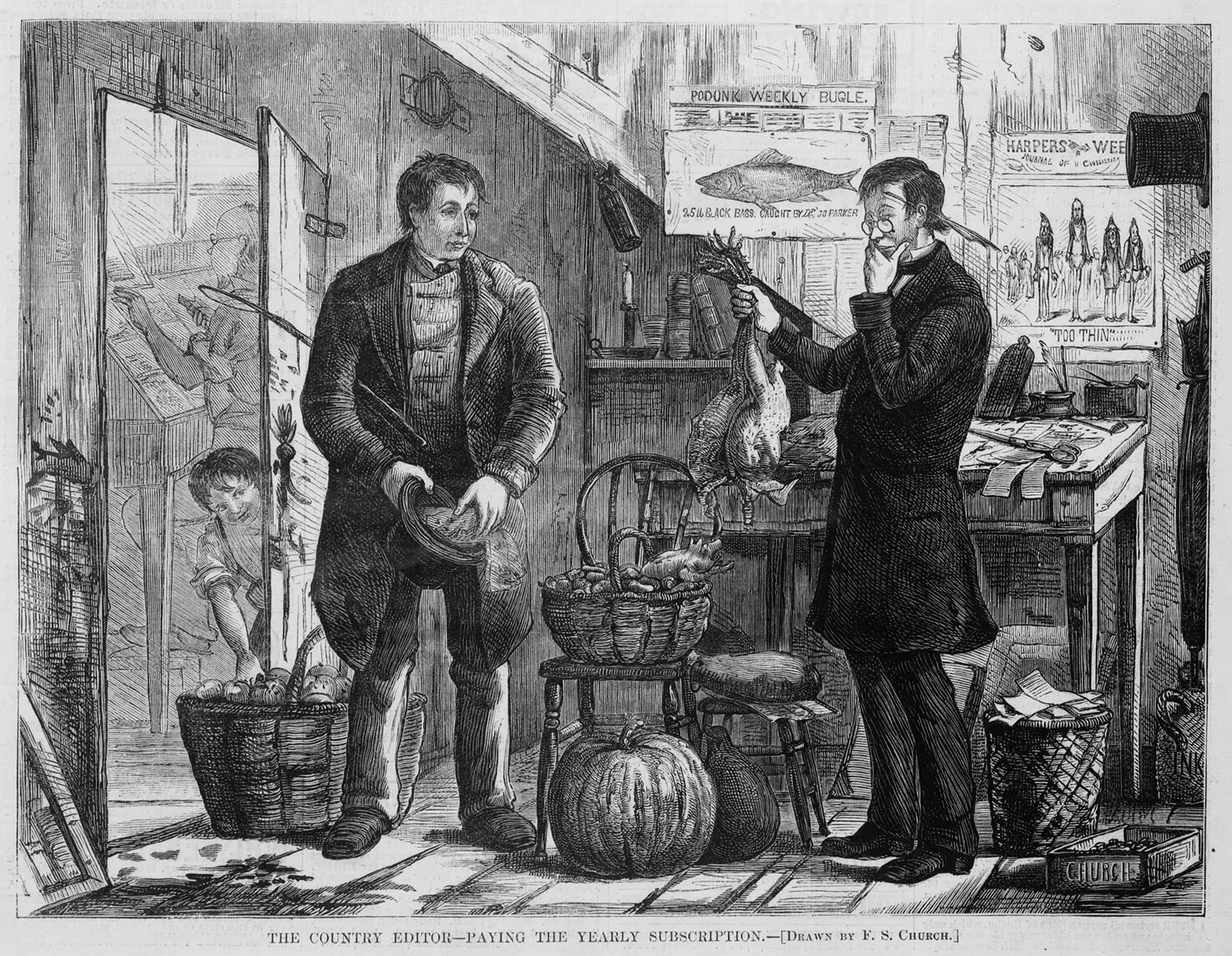
Caption:
Before industrialization, most people in New Hampshire did not use money to buy things. Instead, they bartered with their neighbors. Bartering means to exchange goods and services you have for the goods and services you need. In this newspaper illustration from the 1870s, a man is paying a newspaper editor for his yearly subscription. He is exchanging his farm goods, like apples, a pumpkin, and chickens, for the newspaper.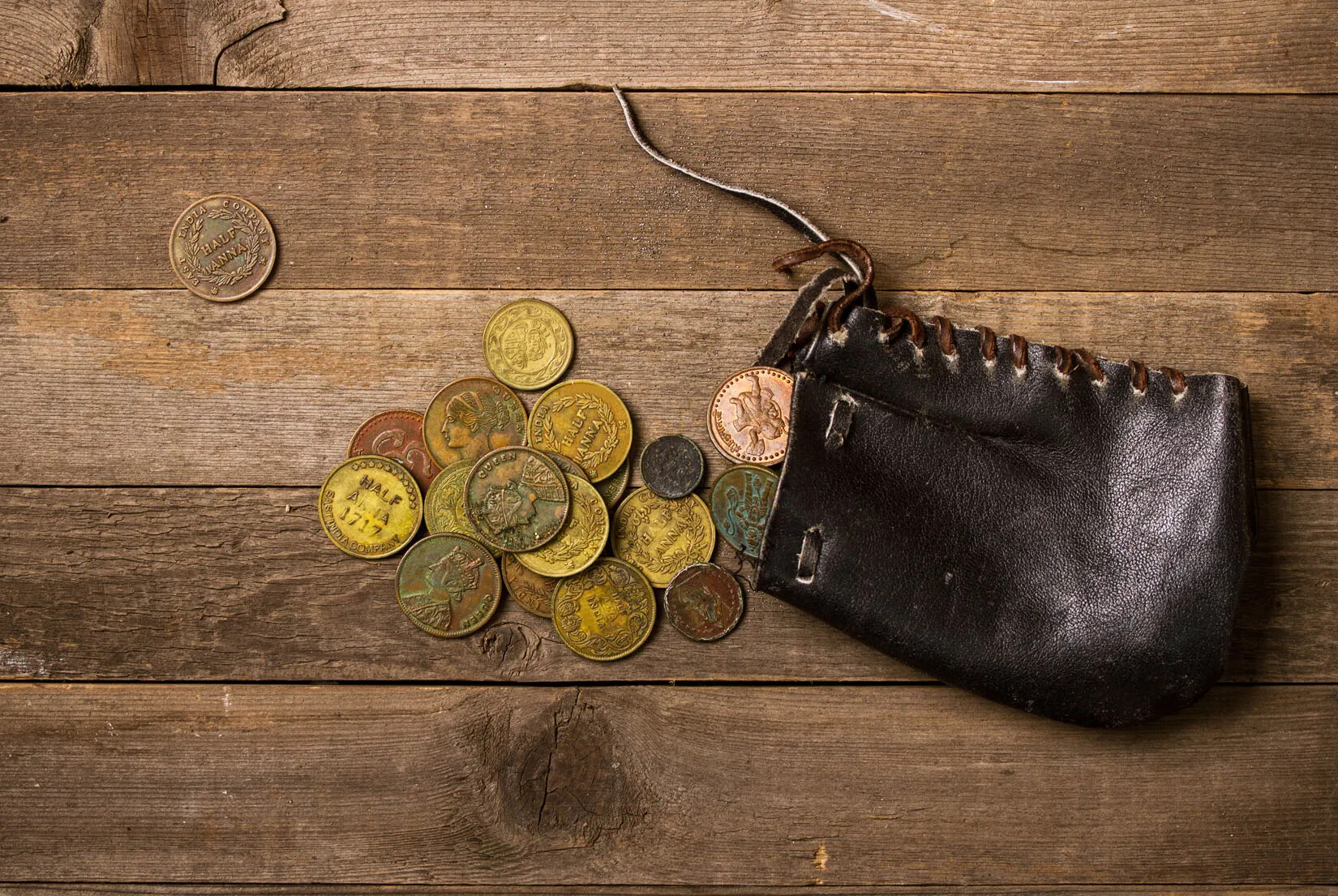
Caption:
Before industrialization, farming families in New Hampshire didn't have to use currency, like coins and bills, very often. They produced many of the things they needed on their own farms, and could usually barter for other goods and services. When people went to work in factories, though, they were paid with money. They used the money to buy things that they needed, like food, clothing, or a place to live. This is one example of how industrialization changed people's daily lives.But the Industrial Revolution changed all that. When people worked in factories, they were paid with money that they used to buy food and clothing and pay for a place to live. Even farmers used the barter system less after industrialization because they sold their wool to the mills for money. They used the money to pay for their food since they weren’t producing enough food on their farms to survive. They were too busy producing wool for the factories to grow what they needed to eat.
People also started working in different kinds of jobs other than just on the farm or in the factory. Starting in the 19th century, more people earned their living by being doctors, lawyers, bankers, shopkeepers, or craftsmen. There were more professions than there had been before industrialization. All of these people were paid for their work with money that they used to buy the things they needed.
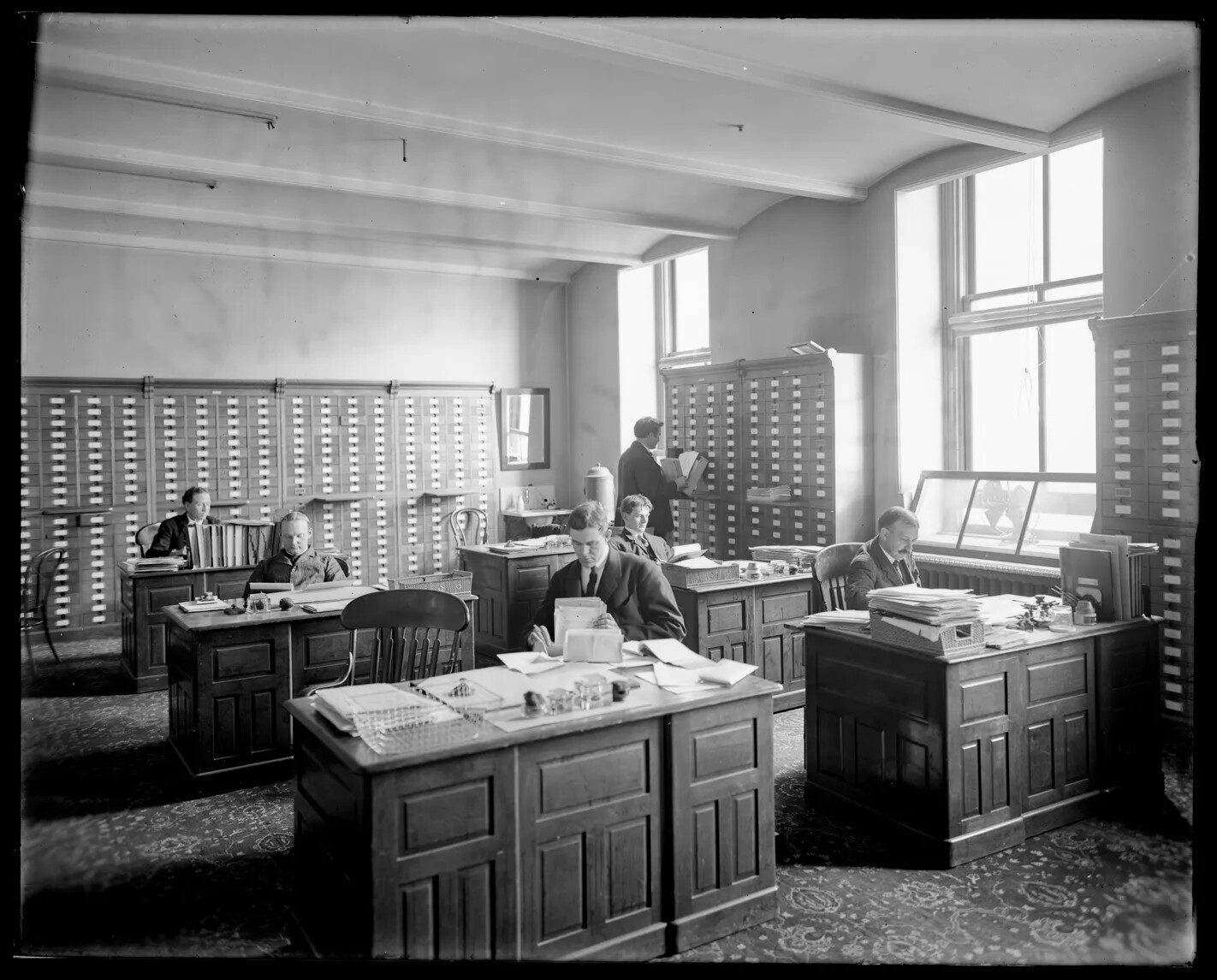
Caption:
The way that people worked changed with the Industrial Revolution. Many people were still farmers, but others went to work in factories. The factories needed workers who made the products. They also needed workers to manage the factories, so more people started working in offices. For example, factories needed workers to order the raw materials and arrange for the finished products to be shipped to market. They also needed workers to hire and train other workers, and keep track of everyone's wages. This picture from the early 20th century shows a government office.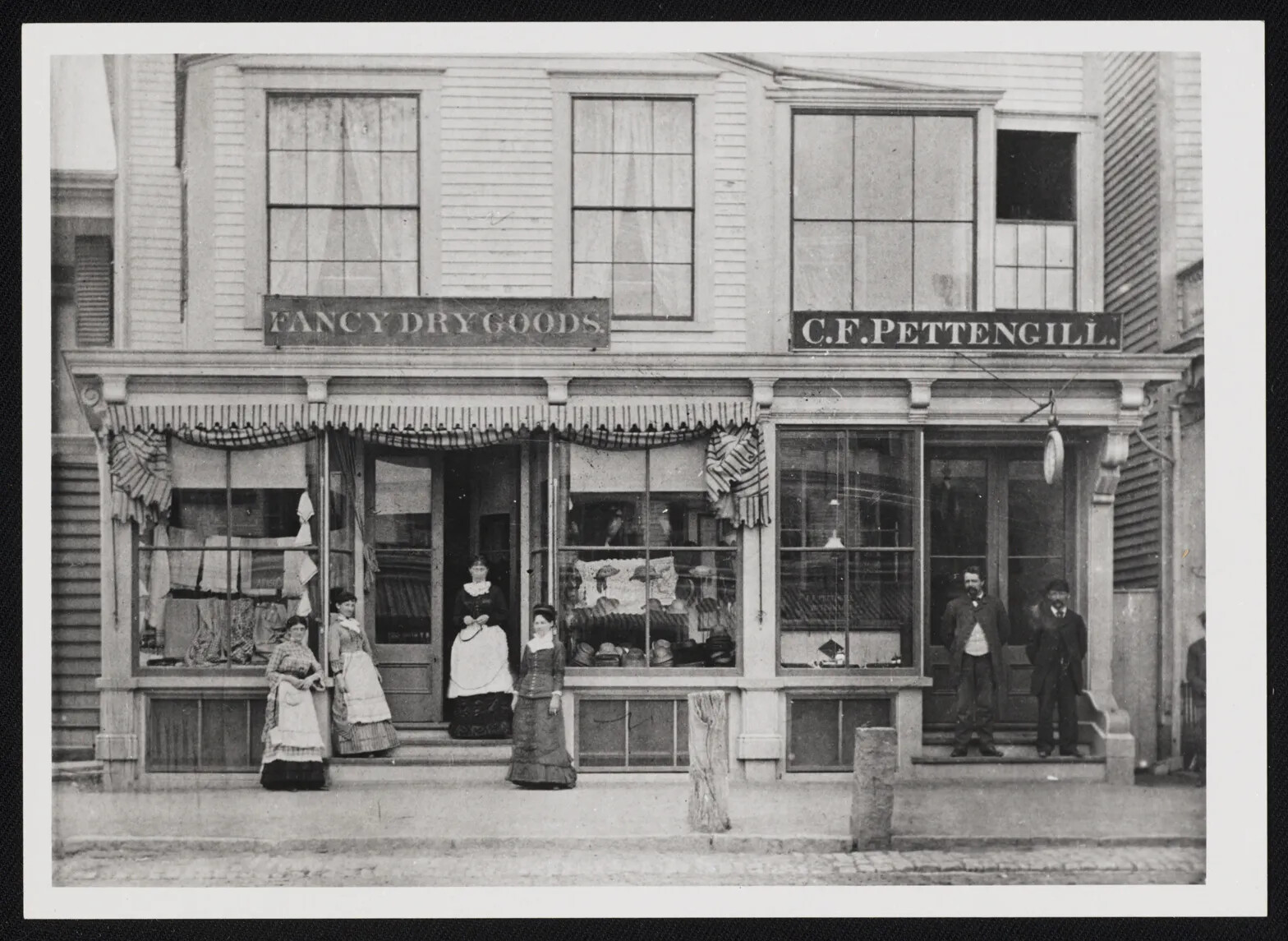
Caption:
This photograph shows a dry goods store somewhere in New Hampshire. (We don't know which town it was in!) A dry goods store sold textiles, like fabric and ready-made items made out of fabric, like napkins, tablecloths, and clothing. Sometimes they also sold boots and shoes or grocery items, such as coffee, tea, flour, and sugar. Customers used cash to pay for the items in the store, which was a big change from bartering.Since people were working in their jobs, they no longer had time to make the items they needed, like clothes, furniture, and household items. They bought these things from stores instead. To meet the demand to buy things, more stores were established throughout New Hampshire, in both big cities and small towns. Stores only took money for the goods they sold. Shopkeepers weren’t willing to barter or trade with people for their goods. So everyone started using money more often.
People also started buying more goods than ever before because factories could make products more cheaply than if they were made by hand. Since goods were less expensive, people bought more. For example, before the Industrial Revolution, most people only owned 2 or 3 sets of clothes and maybe just 1 pair of shoes. People got these goods by making them themselves or trading with someone else who made them by hand. But once factories started making those products, they became cheaper, and people could afford to have many more clothes and shoes. People also started buying more books, toys, and household items.
This change from a barter economy to one where people needed money to purchase what they needed was called the market revolution.
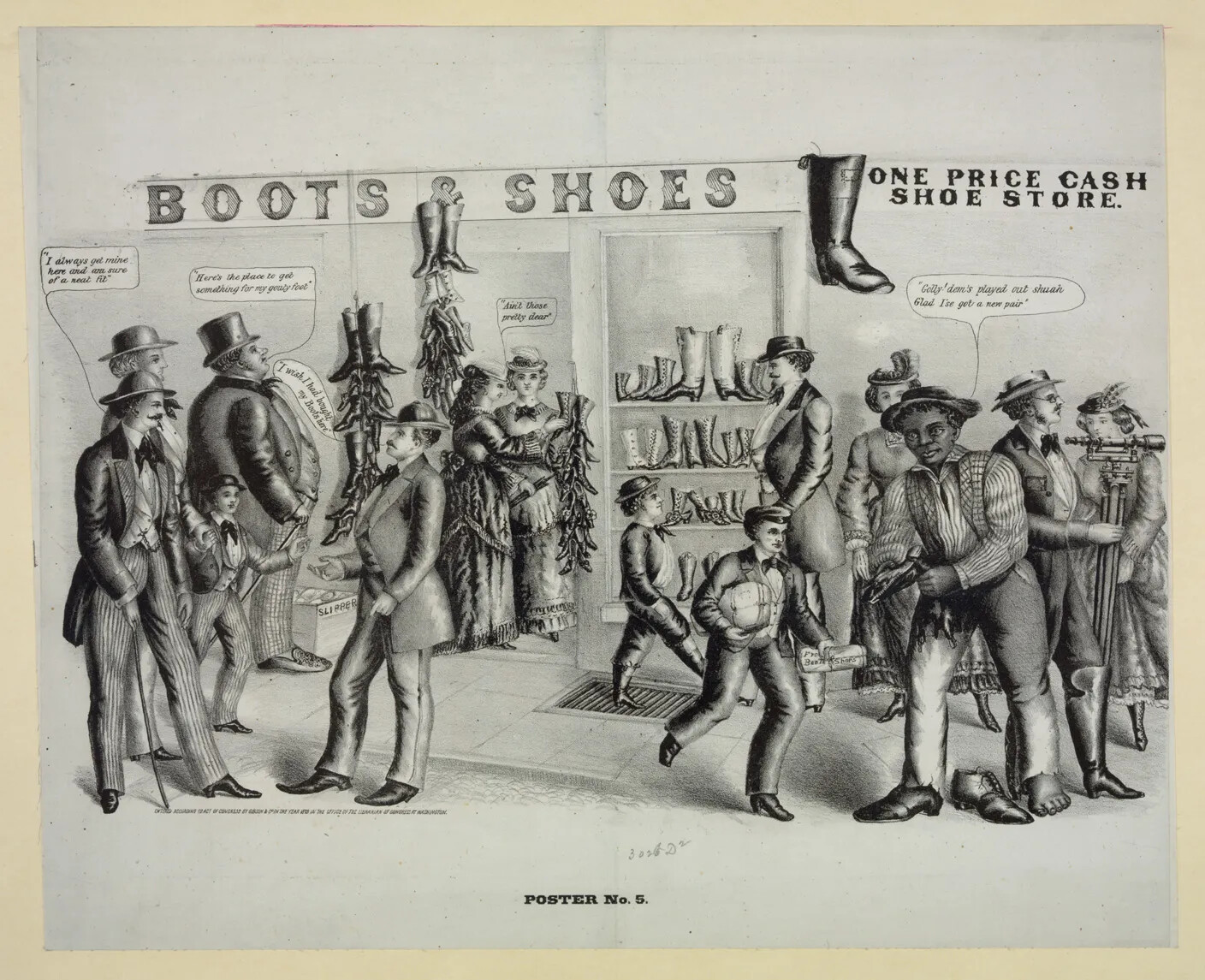
Caption:
This illustration is an advertisement for a shoe store. Notice that the store says "one price cash." This means that the store has set the same price for every customer, and they will only accept cash as payment. This was a new way for people to get the goods they needed. Before industrialization, people would usually barter with their neighbors for goods. For example, someone might trade some eggs and butter from their farm for some shoes made by a neighbor. Now that people were working in factories and getting paid in cash, they could buy goods in stores with money.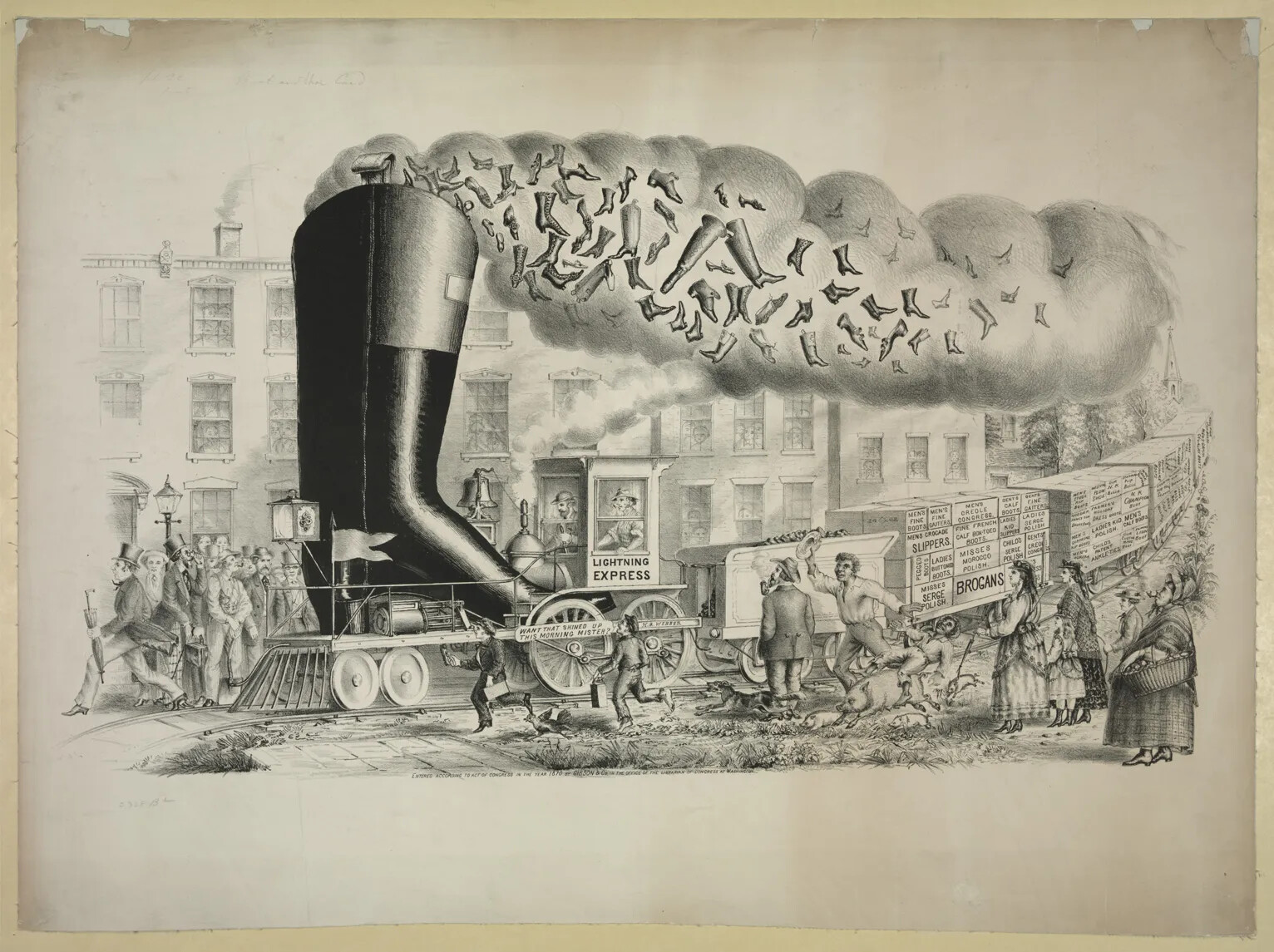
Caption:
This cartoon shows how important railroads were to industrialization. Trains brought raw materials to factories, and shipped the finished products out to markets. The train in this cartoon is bringing all sorts of shoes and boots to a town. The artist imagined that the train actually looked like a boot!Once again, the transportation network was very important, just like it was for industrialization. Good roads that ran through every town and community helped move goods to stores so people could buy things that had been made in factories that were far away. Railroads also helped move goods from factories to the people who wanted to buy them.
transportation network
noun
A system where goods or people pass from one place to another; transportation can be provided by animals (like horses) or machines (like railroads or cars). Transportation networks usually include roads, bridges, rail lines, canals, and other manmade improvements to the land.
Let's Review!
What are the big ideas in this section?
Barter System
In the 1600s and 1700s, most people traded with other people to get the things they needed instead of buying goods from a store.
Industrialization
Factories made things quickly and sold them in stores. Instead of trading for the things they needed, people began to buy them.
Market Revolution
Stores only accepted money for their goods, so people stopped using the barter system as the state industrialized. Even farmers changed the things they produced so they had goods to sell rather than trade.
Railroads
The market revolution required a transportation network to carry things people made in factories and get them to stores so other people could buy them. Railroads were very important because they could carry lots of goods at a time, like bringing raw materials to factories and finished goods to stores.
New Settlements and Boundaries
Why did New Hampshire settlements grow during this period?
New Hampshire’s transportation network also helped people settle in areas of the state that hadn’t been organized into towns yet, like in the Upper Connecticut Valley, in the White Mountains, and in the Great North Woods. For example, when the Tenth New Hampshire Turnpike opened through the White Mountains in 1803, it allowed people to travel to the North Country more easily than ever before.
transportation network
noun
A system where goods or people pass from one place to another; transportation can be provided by animals (like horses) or machines (like railroads or cars). Transportation networks usually include roads, bridges, rail lines, canals, and other manmade improvements to the land.
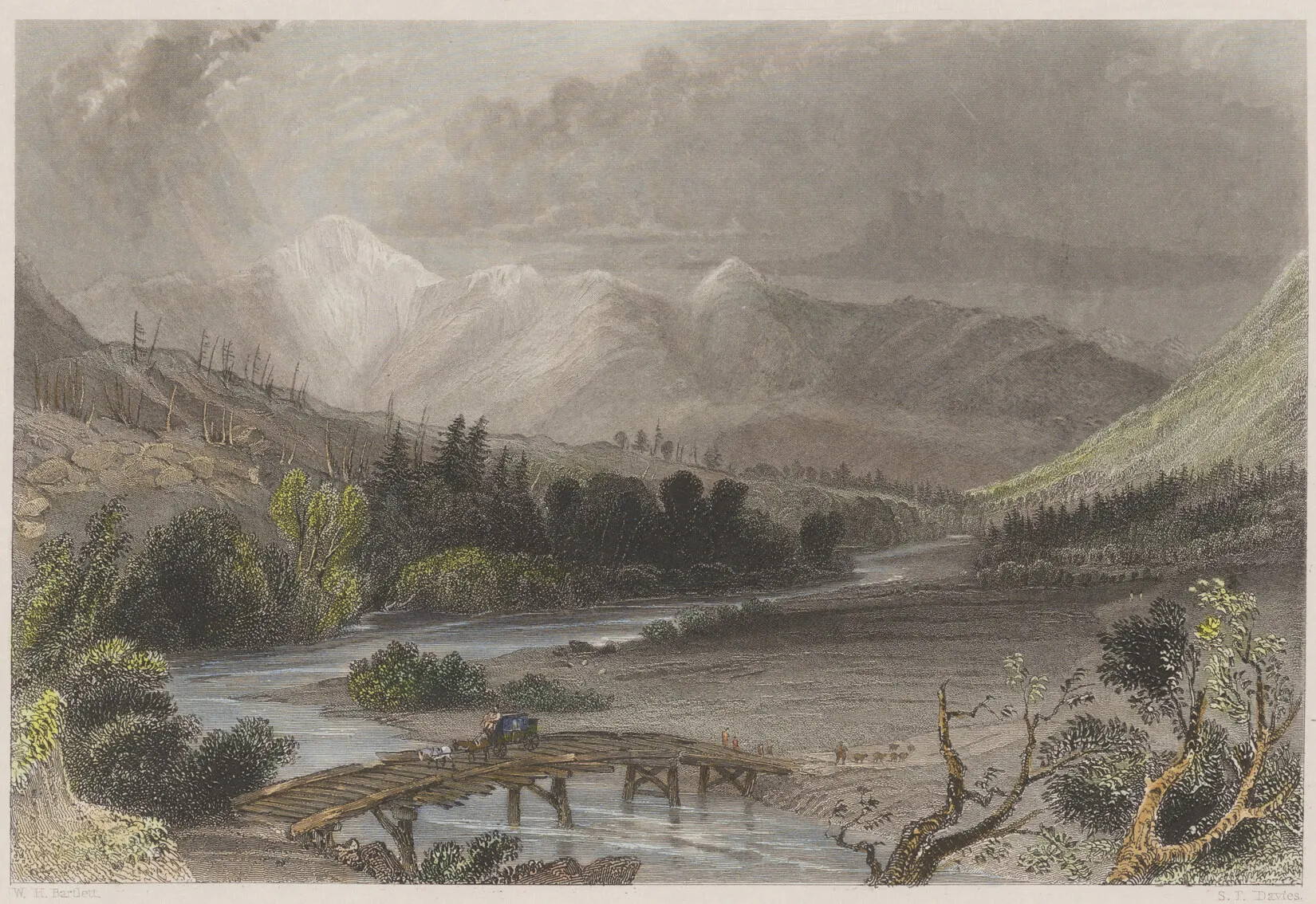
Caption:
The Tenth New Hampshire Turnpike opened in 1806. Its route went through Crawford Notch in the White Mountains. This allowed people to travel to the northern part of New Hampshire much more easily. This picture shows a stagecoach traveling on a road over the Saco River in Crawford Notch. Do you think that would have been a comfortable journey?The Abenaki knew this northern part of New Hampshire well, as many of them moved to this area in the late 1600s and early 1700s. But other settlers did not push this far north until the late 1700s and early 1800s.
There is a legend about some of the first settlers to journey into the White Mountains. The story goes that in 1771 a hunter named Timothy Nash chased a moose into the White Mountains and accidentally found a pass through the mountains, which is called a notch. The notch made it a little bit easier for people to get over the mountains.
Twenty years after Timothy Nash found the notch, two men named Eleazer Rosebrook and Abel Crawford came to the White Mountains and opened inns at either end of the notch. The Crawford family stayed in this area for many years and built roads, hotels, and even the first hiking trail to the top of Mount Washington. The family became so well known in the White Mountains that everyone started calling the notch after them: Crawford Notch.
Caption:
Abel Crawford moved to the White Mountains in 1790 and spent the rest of his life promoting the mountain region. At the time, very few people lived there, but he and his father-in-law, Eleazer Rosebrook, both opened inns near a pass in the mountains where travelers could cross the mountains. The pass was originally called the Notch, but now it is known as Crawford Notch after the Crawford family. Abel loved the mountains and explored them more than anyone else had done at that point. He was known for telling wild stories about what he found in the White Mountains, including tales of encountering bears and other animals. With his son Ethan Allen Crawford and other family members, Abel built taverns and inns where tourists could stay, cut hiking trails through the mountains, and led guided tours to interesting noteworthy places.
Caption:
This photographic print is of Crawford Notch in the White Mountains.
The Crawford Path was created in 1819 by Ethan Allen Crawford, and it goes all the way to the summit of Mount Washington. It is the oldest hiking trail in the United States that is still in use. Over the past 200 years, thousands of people have hiked it and enjoyed the beautiful views it offers of the White Mountains.
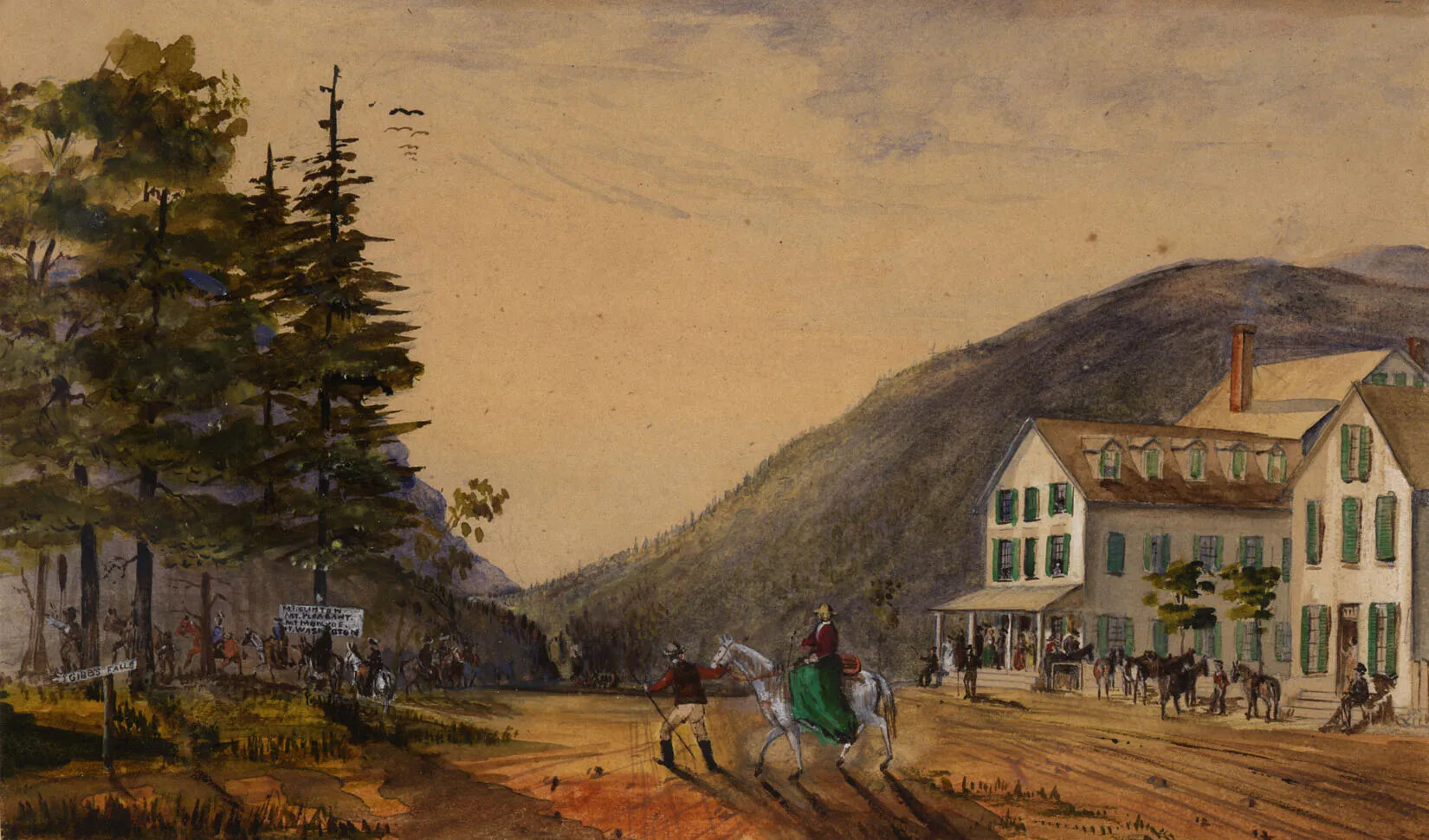
Caption:
Early visitors to the White Mountains stayed in taverns or inns. Visitors relied on the beauty of the scenery for entertainment, and only returned to these taverns to eat and sleep.Once people could pass through Crawford Notch, they settled towns in the White Mountains and the Great North Woods, and later people started visiting the area to see the mountains. By the middle of the 19th century, this area had become very popular for tourists who wanted to explore New Hampshire’s natural beauty.
One of the things tourists came to see was the Old Man of the Mountain, which was a rock formation in the White Mountains located at another pass—or notch—through the mountains. Some workers building a road gave the rock formation that name in 1805 because they thought it looked like the craggy face of an old man. It became one of the most popular tourist sites in the state.
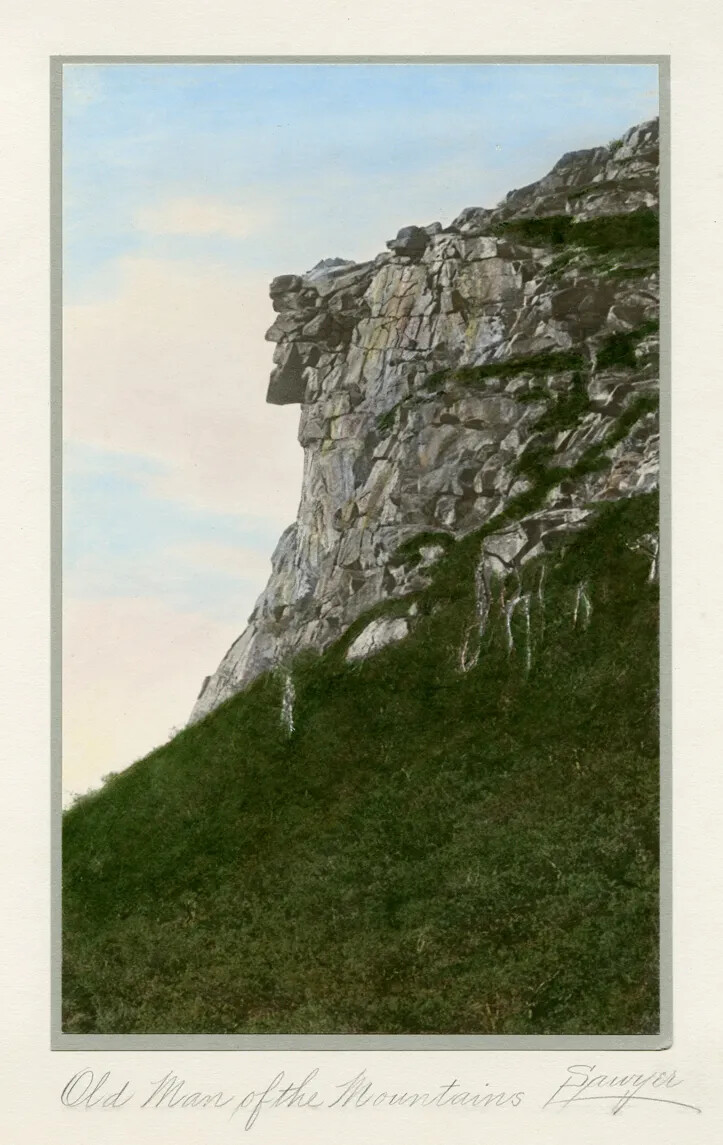
Caption:
The Old Man of the Mountain was an important New Hampshire landmark. It was a series of five layers of granite that looked like the profile, or side, of a man's face. It became well-known starting in the 1930s and people came from all over the country to see it. It became a symbol of New Hampshire. Unfortunately the granite that made up the Old Man fell to the ground in 2003.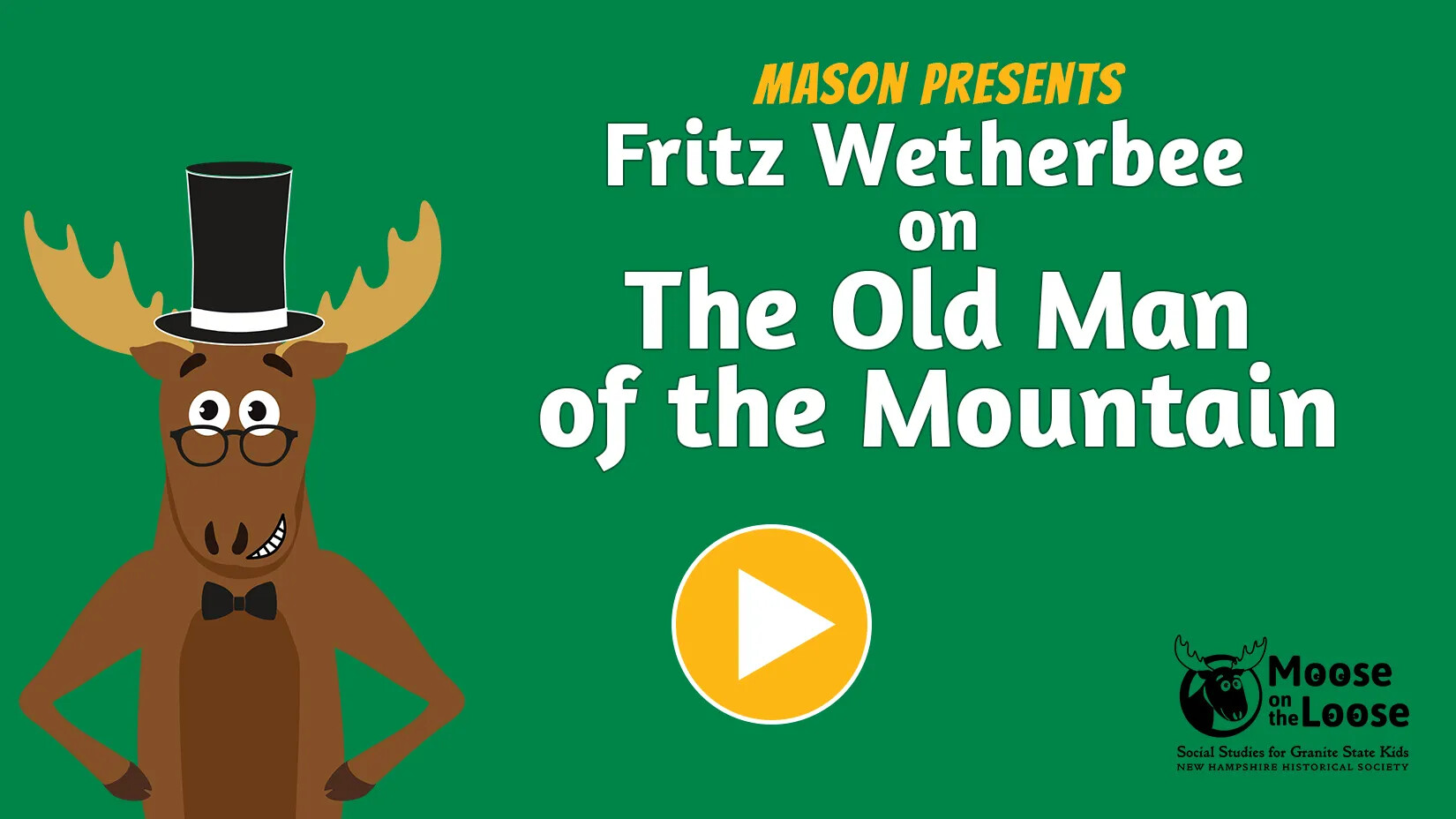
Caption:
Granite State storyteller Fritz Wetherbee shares the tale of the Old Man of the Mountain. Note: This audio clip was recorded before the Old Man fell, on May 3, 2003.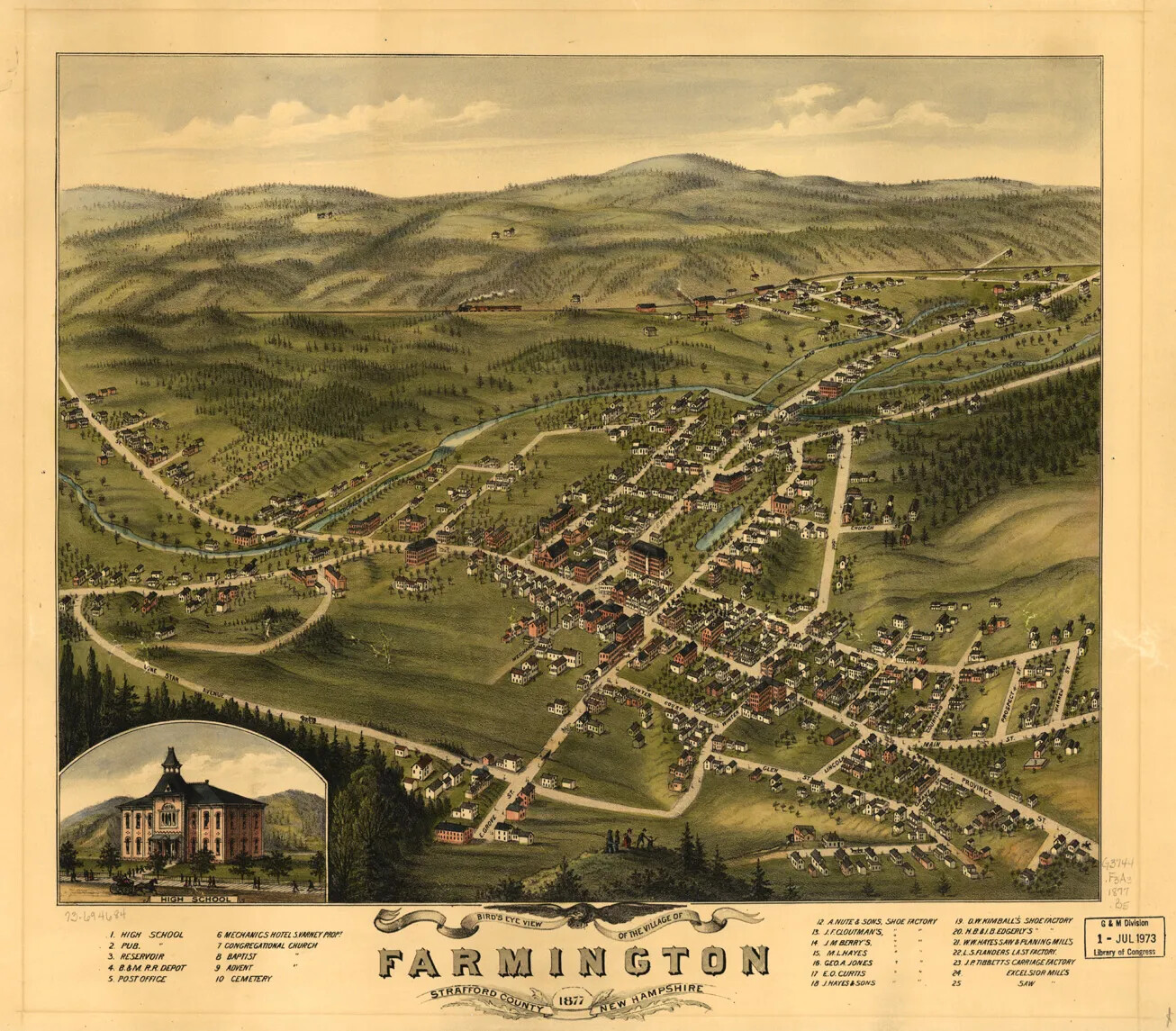
Caption:
"Bird's eye" views of towns and villages like this one were very popular in the late 1800s. These illustrations showed what a community looked like from above. New Hampshire's population grew and grew from the late 1700s through the 1800s, so communities were getting bigger and bigger. This bird's eye view shows Farmington, New Hampshire.With all these new areas being explored and towns being settled, more people came to New Hampshire in the late 18th century and the early 19th century. In fact, New Hampshire’s population grew faster during the 1780s and 1790s than it did at any other time in its history. The state’s population growth slowed in the early 19th century, but it was still a period when lots of people moved to New Hampshire. In fact, by 1850 there were five times more people in New Hampshire than there had been in 1770.
By the middle of the 19th century, there were 210 towns and cities in New Hampshire, which is almost as many as there are today. People were living in every part of the state, and almost all of the land had been claimed and settled. With so many new settlements, the state added five new counties, bringing the total number up to 10 counties, which is the same number New Hampshire has today.
How were New Hampshire’s borders set in the early 19th century?
By the early 19th century, most of New Hampshire’s borders had been established, except for its northern border. Once a lot of people started moving to this area of the state, though, it became more important to establish a border between New Hampshire, Vermont, and Canada.
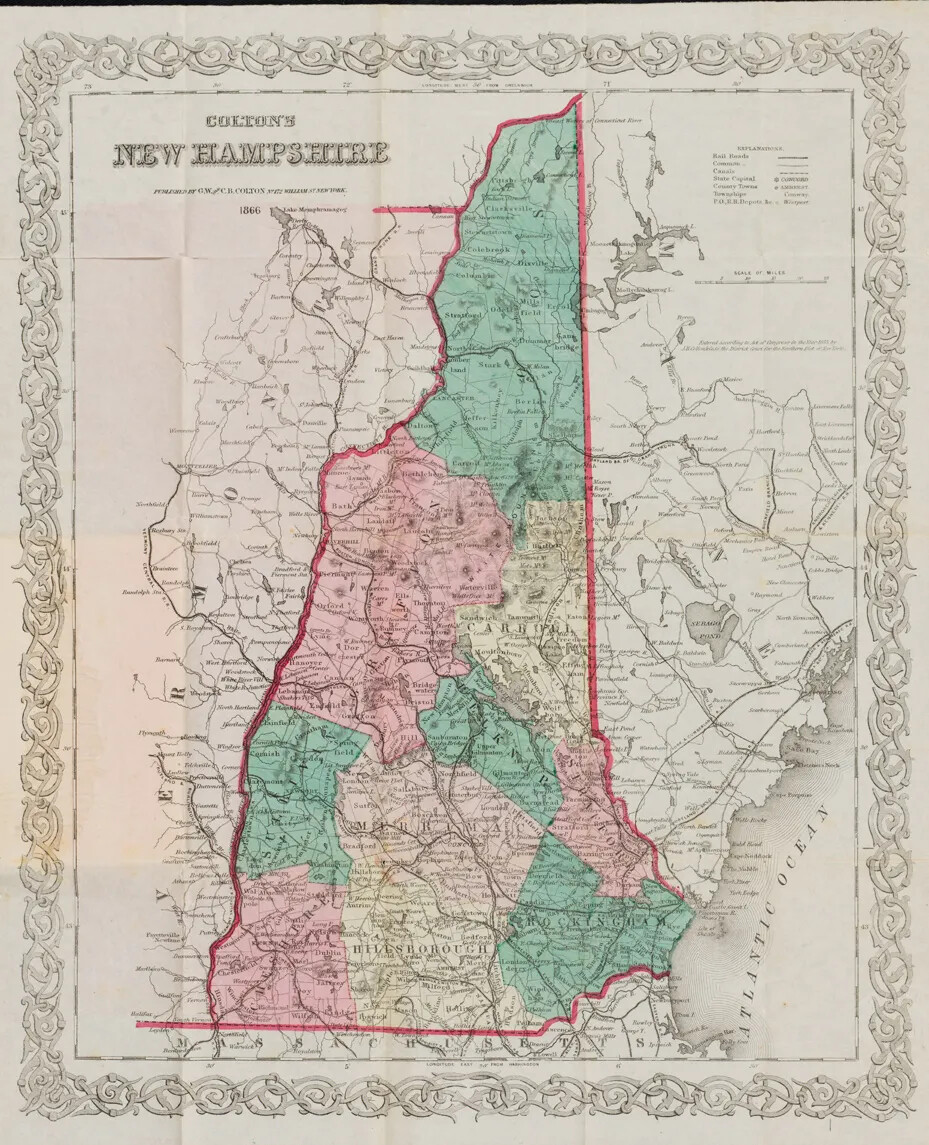
Caption:
This map shows New Hampshire in 1866. The state had grown so much in the last one hundred years! Originally there were just five counties. By 1866, the population had grown so much that there were ten counties, which are all shown on this map. The map also shows all the towns, as well as New Hampshire's borders with Canada, Maine, Massachusetts, and Vermont.Indian Stream Republic. In the 1830s, a town in the most northern portion of New Hampshire even tried to become its own country! At that time, no one was quite sure who owned the land in that part of New Hampshire. Was it part of the United States or Canada? No one was quite sure.
The 300 settlers who lived there decided to be independent from both countries and start their own. They called their country the Indian Stream Republic. They even wrote a constitution and created a government for their country. The state of New Hampshire claimed this land, though, so it forced the Indian Stream Republic to become part of New Hampshire as the town of Pittsburg.
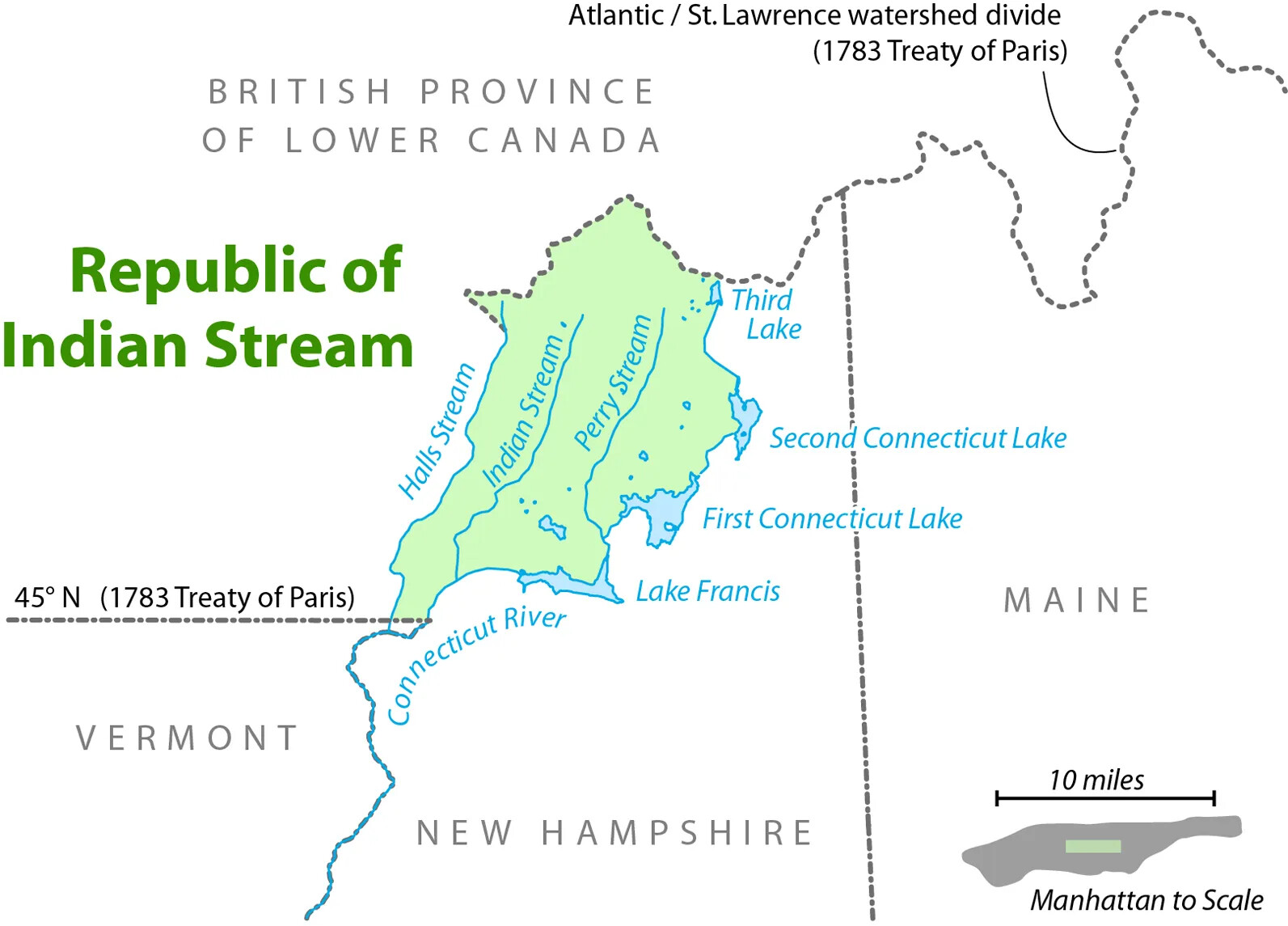
Caption:
Have you ever heard of the Indian Stream Republic? In the 1830s, this town in the northernmost part of New Hampshire tried to become its own country! Back then, no one was quite sure whether the land belonged to Canada or the United States. So in 1832 the town decided to create their own republic. After three years the state of New Hampshire claimed the land and forced the town to become the town of Pittsburg, New Hampshire.Webster-Ashburton Treaty. Even after the Indian Stream Republic, there was still confusion between the United States and Canada about where the border was between the two countries. In 1842, a very famous politician named Daniel Webster helped settle where the border should be. Daniel Webster was born in New Hampshire and once served in the U.S. Congress as New Hampshire’s representative. When he resolved the border issue between the United States and Canada he was the secretary of state of the United States, which is a very important job.
Daniel Webster worked with the Canadian government to establish the U.S. border where it still is today, extending all the way from Maine to Montana. The agreement he reached with the Canadian government was called the Webster-Ashburton Treaty. Once it was settled, all of New Hampshire’s borders were established as they remain to this day.
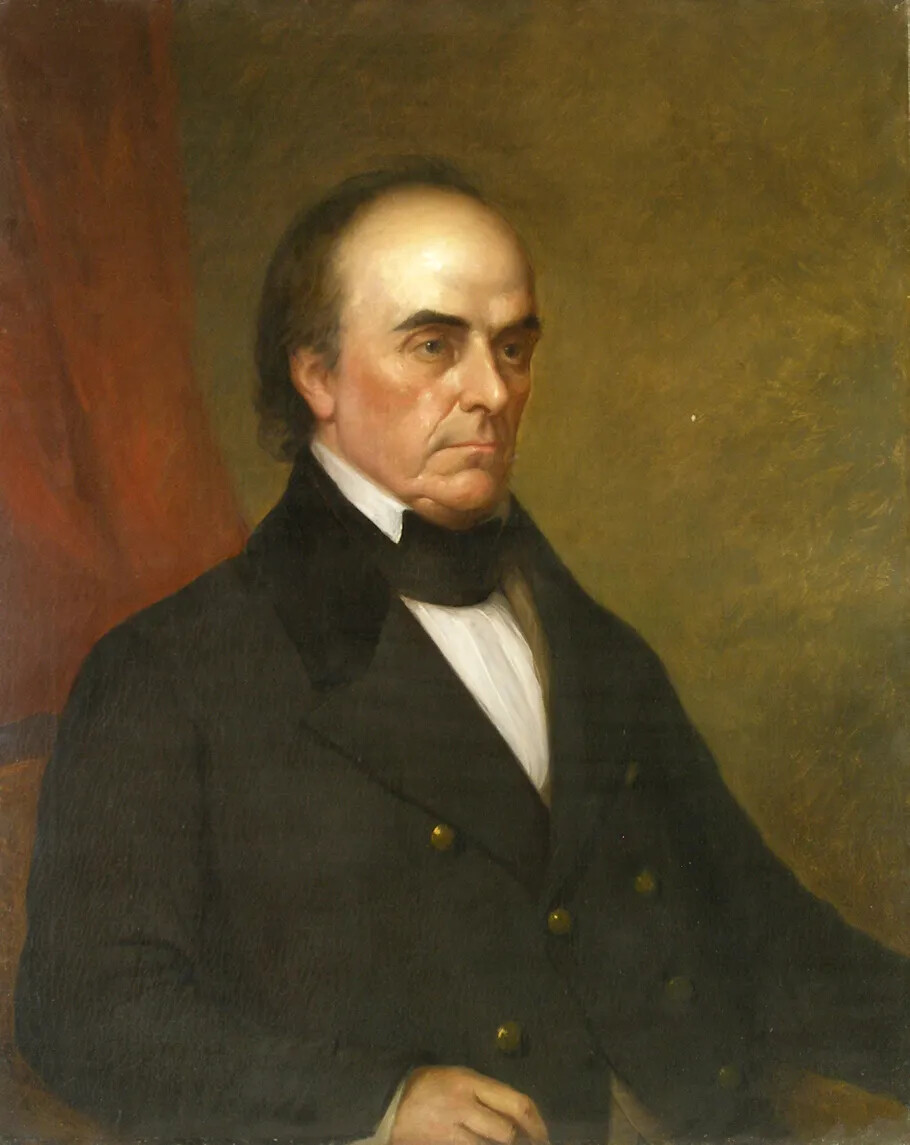
Caption:
Daniel Webster was a famous American politician who was born in New Hampshire. He went to Dartmouth College, and served as New Hampshire's representative to the U.S. Congress. He later moved to Massachusetts and was elected a U.S. Senator. He was also a U.S. Secretary of State! One of the projects he did while secretary of state was to settle the border between Canada and the United States. This finalized the northern border of New Hampshire.Let's Review!
What are the big ideas in this section?
Settling New Towns
In the early 1800s, towns were established in areas of the state like the White Mountains, the Great North Woods, and the Upper Connecticut Valley.
Population Growth
New Hampshire’s population grew a lot in the late 1700s and early 1800s. The state’s 5 counties were reorganized into 10 counties instead, the same 10 counties we have today.
Indian Stream Republic
The northernmost part of New Hampshire declared itself independent in the 1830s and formed its own country. The Indian Stream Republic became part of New Hampshire again after a few years.
State Borders
The last of New Hampshire’s borders was finally set in 1842 by a treaty with Canada. The state has the same borders today.
Developing a State Culture
What was New Hampshire’s state culture?
Many of the changes that occurred in New Hampshire in the late 18th century and early 19th century encouraged people to look beyond their own towns to the other people who lived in the state. The people of New Hampshire set up a state government in the 1780s and even adopted a state constitution to explain how the government functioned. But other than the state government, there weren’t any statewide organizations in the years after the American Revolution.
Gradually in the decades after the American Revolution the people who lived here became more aware of a common culture and history that the people in New Hampshire shared. And they started to define symbols that represented the state and the character of its people.

Caption:
A constitution is a written document that explains the social contract the people have made with the government. It states what the government can and cannot do. Constitutions also limit the power of government because the government’s powers are written down for everyone to see.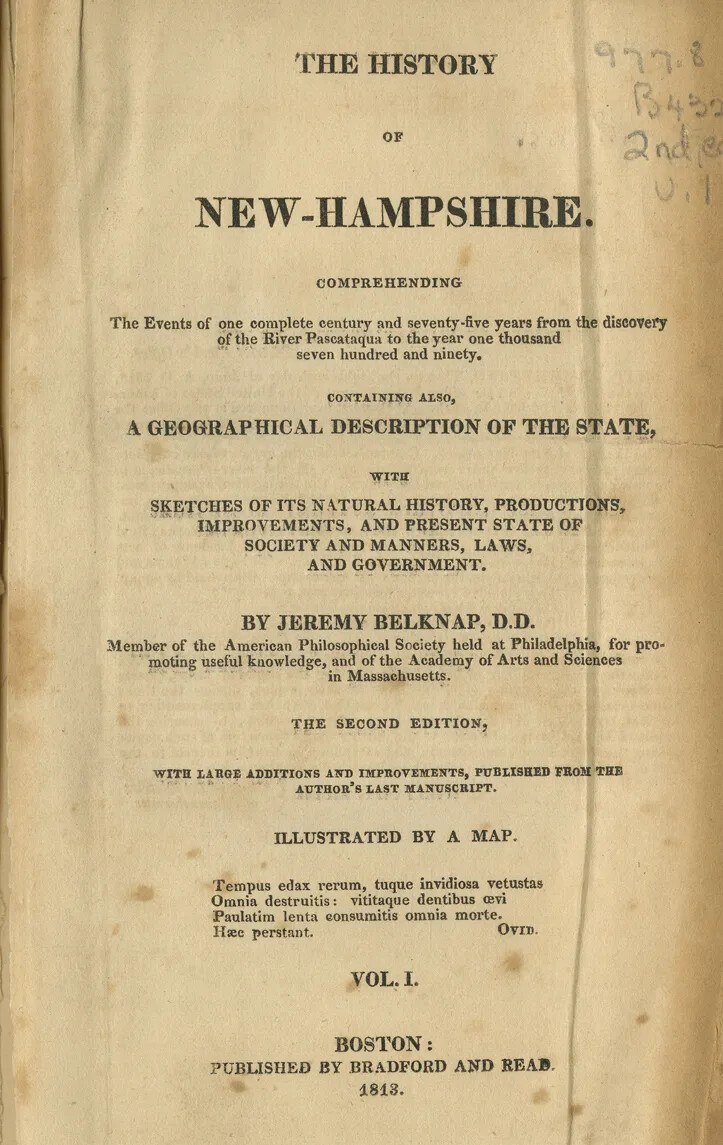
Caption:
This is the first history book written about New Hampshire. It was written by a minister named Jeremy Belknap, who traveled all over New Hampshire for 20 years to research its history. He told the story of the state from the first English settlement all the way up to 1812, when the book was published. It took three volumes to tell the whole story! This is the title page from the second edition of the book. It was printed in 1813. It was owned by Charles Corning, who was a mayor of Concord, New Hampshire, and a member of the New Hampshire Historical Society.State History. One of the first things to make the people of New Hampshire feel united was an interest in New Hampshire’s history. In the late 18th century, a minister from Dover named Jeremy Belknap published the story of New Hampshire up to that point.
Caption:
Jeremy Belknap wrote the first history of New Hampshire. He was born in Boston and studied at Harvard College. As a young man, he moved to New Hampshire and became a minister. He also loved to research and write about history. He traveled all over New Hampshire and studied its past. In 1784 he published the first part of the History of New Hampshire. He had done so much research and learned so much that it took two more books to tell the whole story! This was the very first history book written by an American. New Hampshire’s Belknap county is named after him.A few decades later, a group of men from all over the state came together to form the New Hampshire Historical Society to collect objects and documents about New Hampshire’s past and save them for future generations.
By preserving and sharing the history of New Hampshire, people celebrated their common heritage. It helped them see how they were connected to other people in the state and how they were part of a larger story.
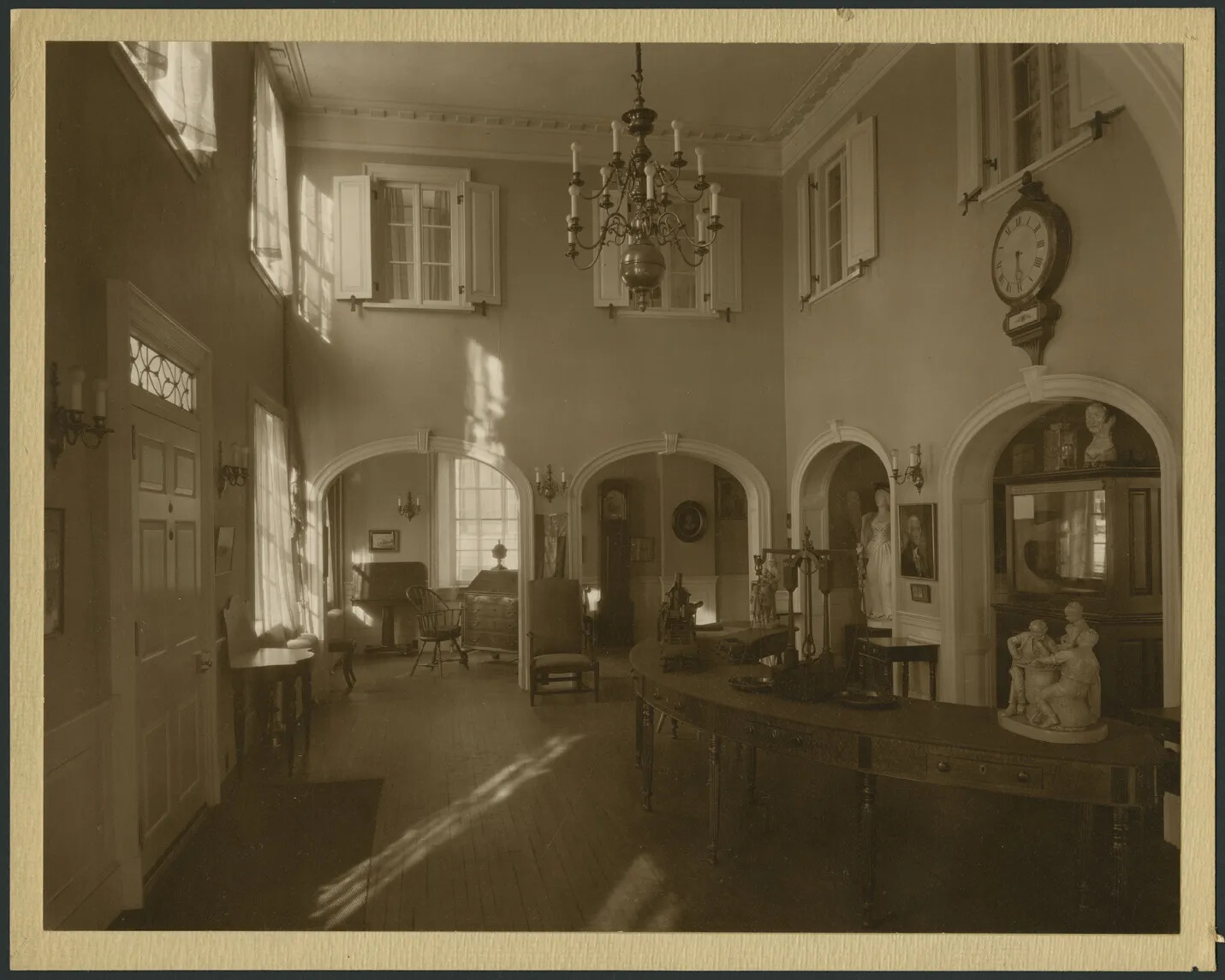
Caption:
The New Hampshire Historical Society was founded in 1823. It collects objects and documents from New Hampshire's past to save, preserve, and share New Hampshire's history. This photograph shows its museum on State Street in Concord, New Hampshire. What kinds of objects do you notice? In 1911, the Society moved to a special new building on Park Street in Concord. Have you ever visited it on a field trip?
Caption:
This is the first map made of the entire state of New Hampshire. It took 13 years to make.Carrigain Map. Another thing that helped people think about the state as a whole was the Carrigain Map, which was published in 1816. The Carrigain Map was the first official map of the entire state, and it was the first map ever to show the White Mountains and the Great North Woods. Before the Carrigain Map, other maps of New Hampshire just left a big blank space where the White Mountains and the Great North Woods were because the mapmakers didn’t know what should go in that area.
The Carrigain Map was made by a New Hampshire government official named Philip Carrigain. He spent over a decade of his life working on it!
Caption:
Philip Carrigain was an important person in New Hampshire in the early 1800s. He founded a newspaper, was a secretary of state, and wrote a poem called “The Granite State” that gave New Hampshire its nickname. He is most known for creating the “Carrigain map.” No maps of New Hampshire had been made since the American Revolution. There was a lot of land in the North Country that had never been mapped. And there were new towns popping up everywhere as more and more people moved to the state. Philip Carrigain convinced the state government that it was time for a new map. The state put him in charge of it. It was a long and complicated project, because each town’s map had to be drawn by hand. Then the maps had to be put all together into a single map. It took 13 years! Eventually, in 1816, it was finished, and a copy was given to each town in the state.State Capital. At the same time the Carrigain Map was published, New Hampshire also established its state capital in the town of Concord, which is in the geographical middle of the state. Before that, the state capital would move from town to town every year. Once Concord was chosen as the state capital, the state government decided to build a state house that would become a symbol of New Hampshire.
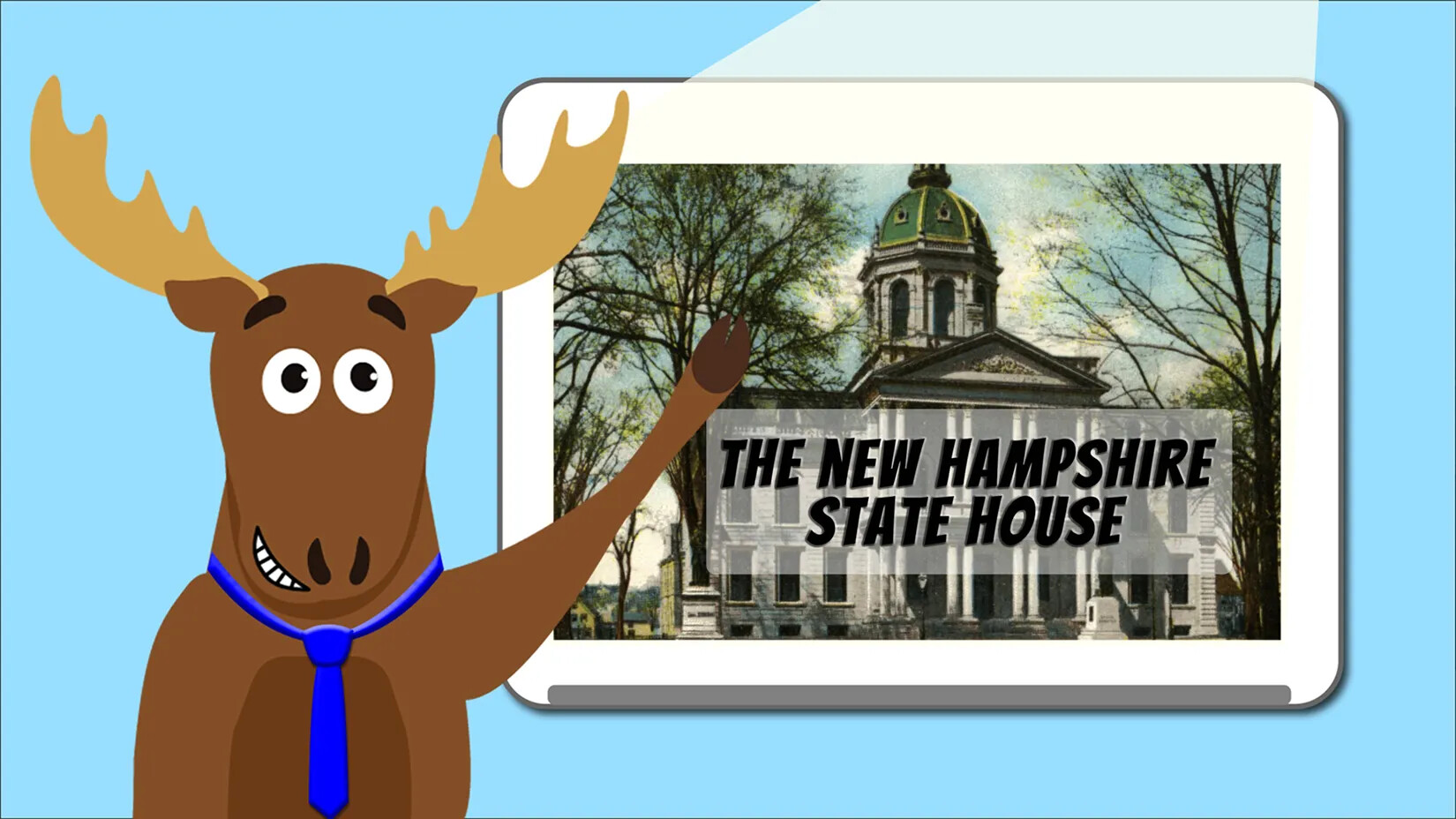
Mason Explains: The New Hampshire State House
A New Hampshire state icon!
The state house was used for all sorts of public events and activities for the people of the state. The building itself was the center of the state government. The legislature held its meetings there, and the governor had his office in the state house.
The area around the state house, which was called the state house yard, became a public meeting place where they held concerts and even played an early form of baseball! The state house yard was kind of like a park for the people of New Hampshire.
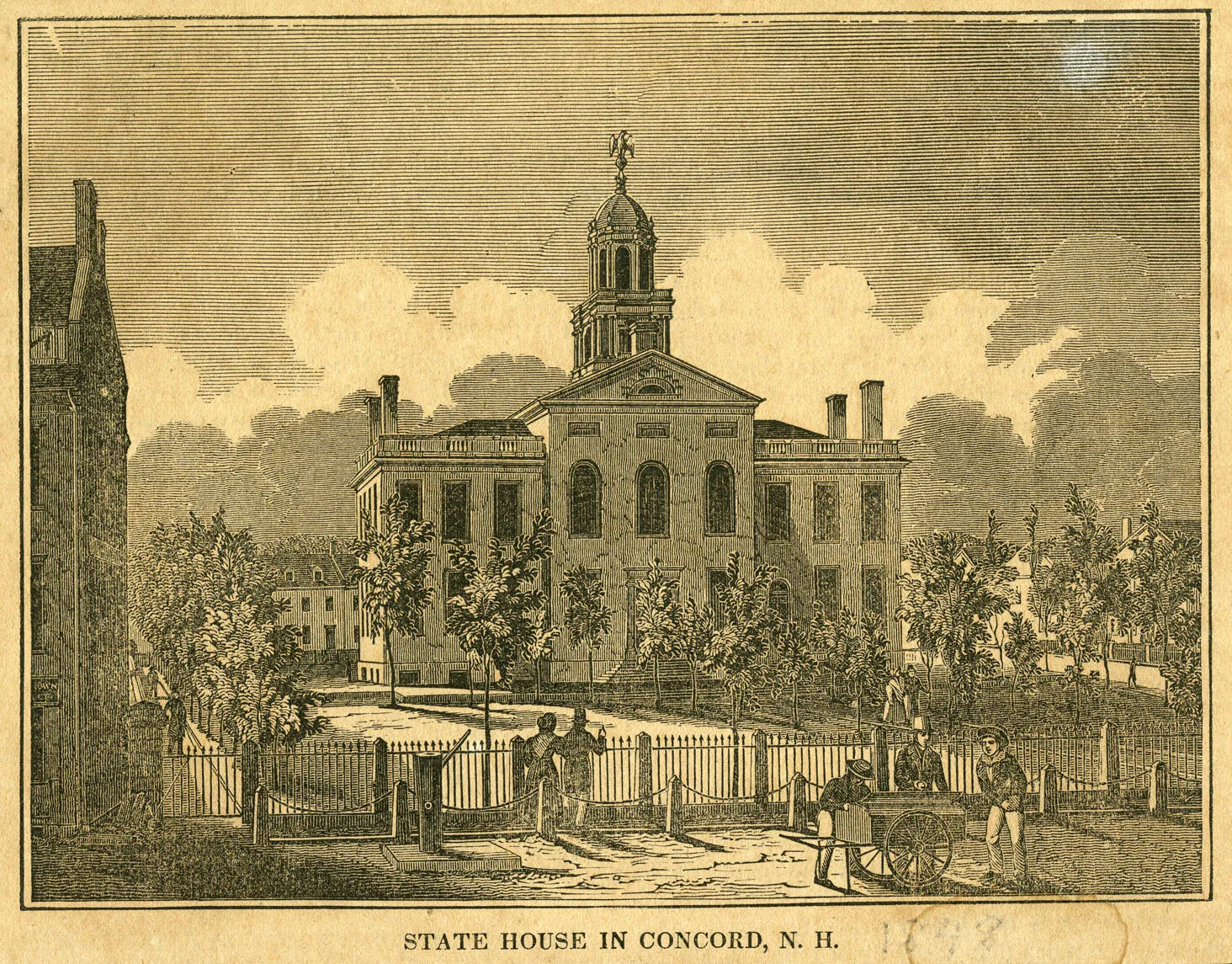
Caption:
This engraving of the New Hampshire State House in Concord shows the way it looked in 1836, about 15 years after it opened.The Granite State. When important people visited New Hampshire, the state government sometimes held dinners in the state house yard to honor them. At one dinner in the state house yard in June 1825, Philip Carrigain read aloud a poem he had written about New Hampshire in which he called it the “Granite State.”
It was the first time anyone had ever used that phrase to describe New Hampshire. Carrigain thought it was fitting to describe New Hampshire that way because the state had so much natural granite. The people of New Hampshire had a reputation for being tough, just like granite. The naming of the Old Man of the Mountain in 1805 was another example of the importance of granite in the state, as the rocks that made the Old Man’s face were granite. The phrase “Granite State” is still often used as New Hampshire’s nickname.
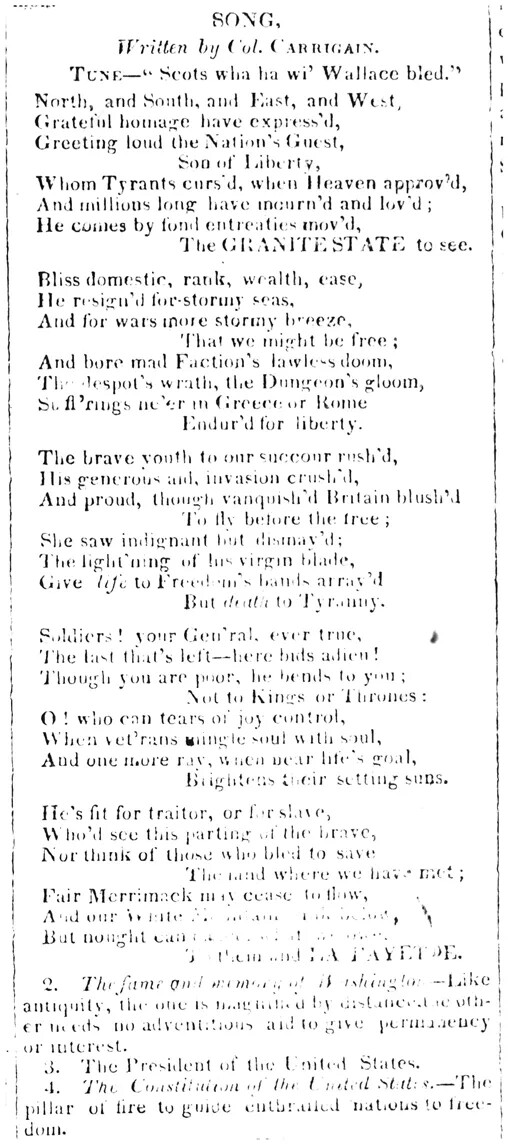
Caption:
This song is the first time we know of that people called New Hampshire "the Granite State." It was written by a man named Philip Carrigain. He wrote it in 1825, when an important French general named Marquis de Lafayette visited New Hampshire. Lafayette had fought with George Washington in the American Revolution and helped America win its independence from England. Fifty years later, he visited the United States. Wherever he went, people had big celebrations for him. When he visited Concord, there was a fancy dinner on the State House lawn, with speeches and songs. This song, "the Granite State," was performed then. It was printed in the Concord Register on June 25, 1825.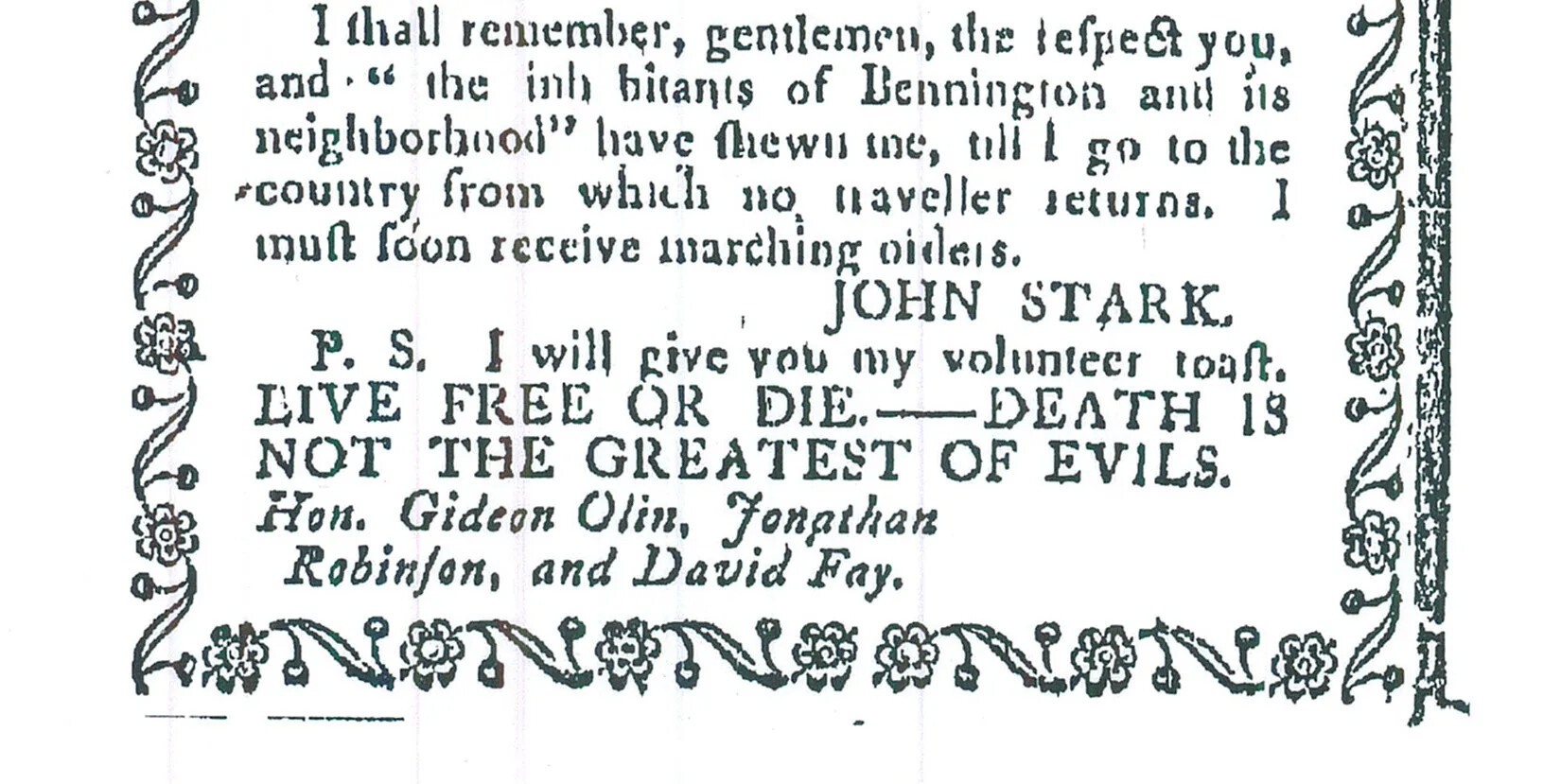
Caption:
In 1809, John Stark was invited to an anniversary celebration for the Battle of Bennington. Unfortunately, he was too old and sick to travel. Instead he sent a letter to be read out loud at the celebration. He wrote about his great respect for the soldiers who fought with him for liberty and independence. At the end of the letter, Stark wrote, “Live free or die, death is not the greatest of evils.” These words became an important symbol of New Hampshire and later, the state motto. Stark’s original letter does not seem to have survived, but it was reprinted in this newspaper.Caption:
New Hampshire’s most famous Revolutionary War soldier, General John Stark, used the term “Live free or die” in 1809. He was writing a letter to some fellow veterans who had organized a dinner to celebrate the anniversary of Stark’s great victory in 1777, the Battle of Bennington. Stark was too sick to attend the dinner, but instead he sent a letter. The letter praised the men for fighting in the American Revolution. Stark wrote, “Live free or die, death is not the greatest of evils.” A newspaper published Stark’s letter, and the phrase “Live free or die” seemed to stick in everyone’s minds. It wasn’t until 1945, though, that Stark’s phrase officially became the state motto of New Hampshire.
State Motto. New Hampshire’s state motto—Live Free or Die—also became popular around this time. It was written by John Stark, who was New Hampshire’s most famous soldier in the American Revolution. Stark had led New Hampshire men at the Battle of Bennington in 1777 and won an important victory there for the Americans. Veterans of the battle would sometimes hold reunions in honor of the Battle of Bennington.
In 1809, John Stark was too old to attend the reunion dinner, but instead he wrote a letter to the veterans to thank them for winning the battle. In the letter, he wrote about the importance of fighting for what they believe in, using the phrase, “Live free or die. Death is not the greatest of evils.” The veterans liked John Stark’s letter so much that they published it in newspapers around New England. The phrase “Live free or die” became a symbol of the people of New Hampshire’s independent spirit. It officially become the state motto in 1945.
Caption:
John Stark is one of New Hampshire’s most famous military leaders. He was born in Londonderry. He was a farmer, hunter, and trapper. As a young man he was captured by Native Americans and spent about a year living with an Abenaki family in Canada, until he was sent back to New Hampshire. When fighting broke out between the patriots and the British in 1775, he raced to Massachusetts to defend the colonies. He fought in important battles like the Battle of Bunker Hill and the Battle of Trenton, where he helped George Washington. Stark was eventually promoted to general and in 1777 he led New Hampshire troops to victory at the Battle of Bennington. This victory helped save New England from a British invasion. Stark is still known as the “Hero of Bennington.” In 1809 he wrote a letter to some of the soldiers he had served with and used the phrase: “Live free or die; death is not the greatest of evils.” Those words, “Live free or die,” later became the state motto.These statewide organizations and symbols helped unite the people who lived in New Hampshire. It helped them feel like they shared a common culture and heritage. The development of a transportation network, the birth of the Industrial Revolution and the market revolution, and the establishment of the state’s borders all combined with this common culture to help people feel connected to the state they lived in.
transportation network
noun
A system where goods or people pass from one place to another; transportation can be provided by animals (like horses) or machines (like railroads or cars). Transportation networks usually include roads, bridges, rail lines, canals, and other manmade improvements to the land.
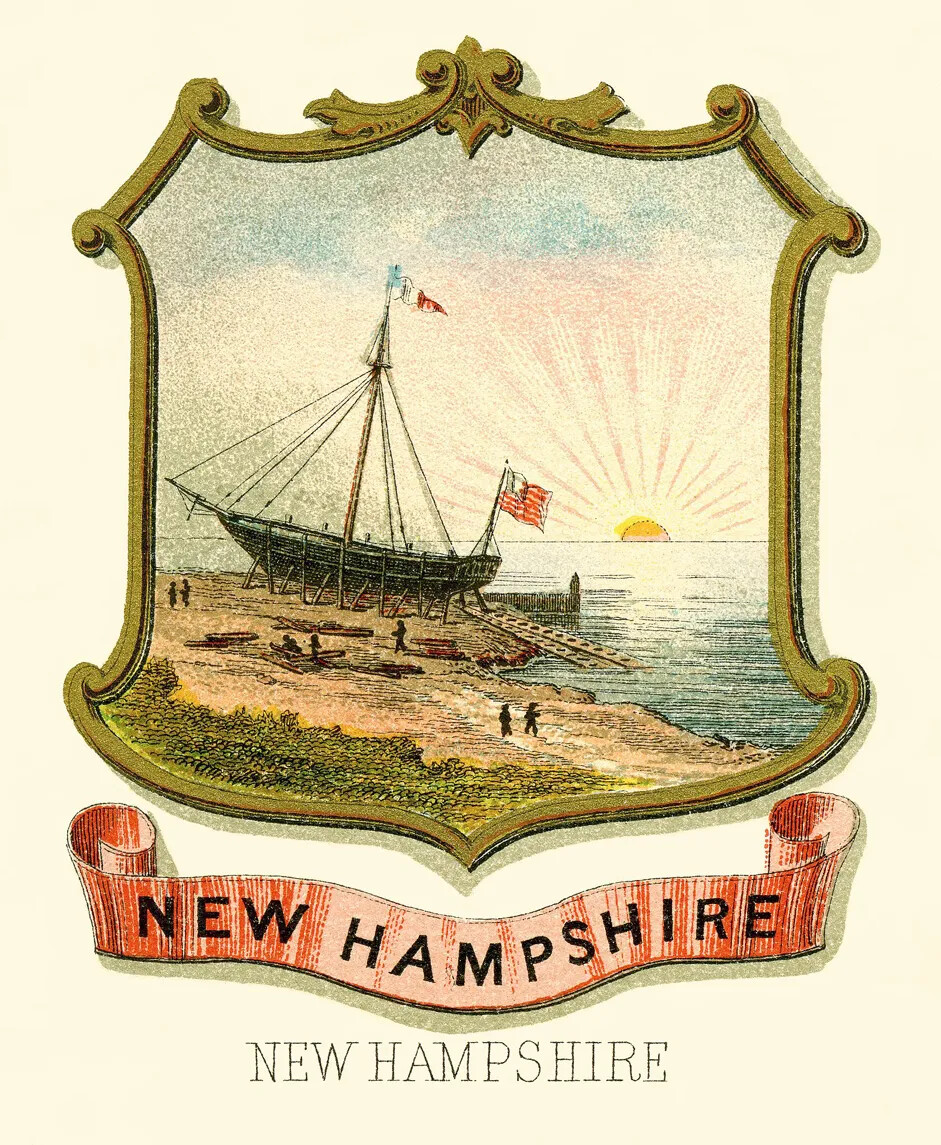
Caption:
A coat of arms is a visual symbol used to identify an individual, family, state, or organization. New Hampshire's coat of arms is similar to its state seal, but not quite the same. They both have a ship, because Portsmouth has always been an important shipbuilding center. They both show a harbor and a rising sun. The coat of arms also shows people.Let's Review!
What are the big ideas in this section?
Statewide Organizations
In the early 1800s, New Hampshire began to organize statewide institutions that helped people look beyond their own towns to a larger community. These organizations helped promote a common culture.
State History
People began to study and celebrate New Hampshire’s history by forming a state historical society. A book recording the history of New Hampshire was also published during this period.
State Capitol
The state capitol was established at Concord, which is located at the geographical center of New Hampshire. A state house was built in Concord to serve as the center of government and as a place for public gatherings.
State Symbols
Other symbols to honor New Hampshire were also created during these years, like an official state map, a state motto, and a state nickname. These symbols also promoted a common culture among everyone who lived in New Hampshire.
Unit 7 Student Reading
A printable version of the student reading for this unit, without pictures or graphics.
